
THE PEAK OF SOUTH AFRICAN MOTORING APEX 07 Lap of luxury Box-fresh Lexus LX tested Cape Town, electrified We preview Formula E in the Mother City RS revelry We strap into the new Audi RS3 & Porsche 911 GT3 RS ISSUE 7 R59,50 9772710519004 22005 RISING MERCEDES-AMG C63 DRIVEN! NEW HYBRID-MODEL MERC (URY) + NEWS BMW 3.0 CSL • Porsche 911 Dakar • Volvo EX90 • Lamborghini Huracán Sterrato LAUNCH PAD VW Amarok • Ford Everest • Toyota GR86 • Nissan X-Trail • Haval H6 HEV • Hyundai Venue DEEP DRIVE Aston Martin DBX707 • BMW iX3 • Audi RS3 Sportback • Jeep Grand Cherokee L • Kia Sportage FEATURE Winged wunder: Porsche 911 GT3 RS • Press ‘R’: VW Golf R & Tiguan R BIKE BMW R18 LIFESTYLE Fitness watches • Pots, Pans & Potjies • Riding shotgun with Siv Ngesi • Reading room

Visual for illustrative purposes only. Ts&Cs apply. NEW ALFA ROMEO TONALE HYBRID. LIVE UNPREDICTABLY


THIS IS FOR YOU.

A luxury sedan that is built to impress: the all-electric EQS with an elegant One-bow design, a luxurious interior space and cutting-edge technology that leads the way.
More information at mercedes-benz.co.za

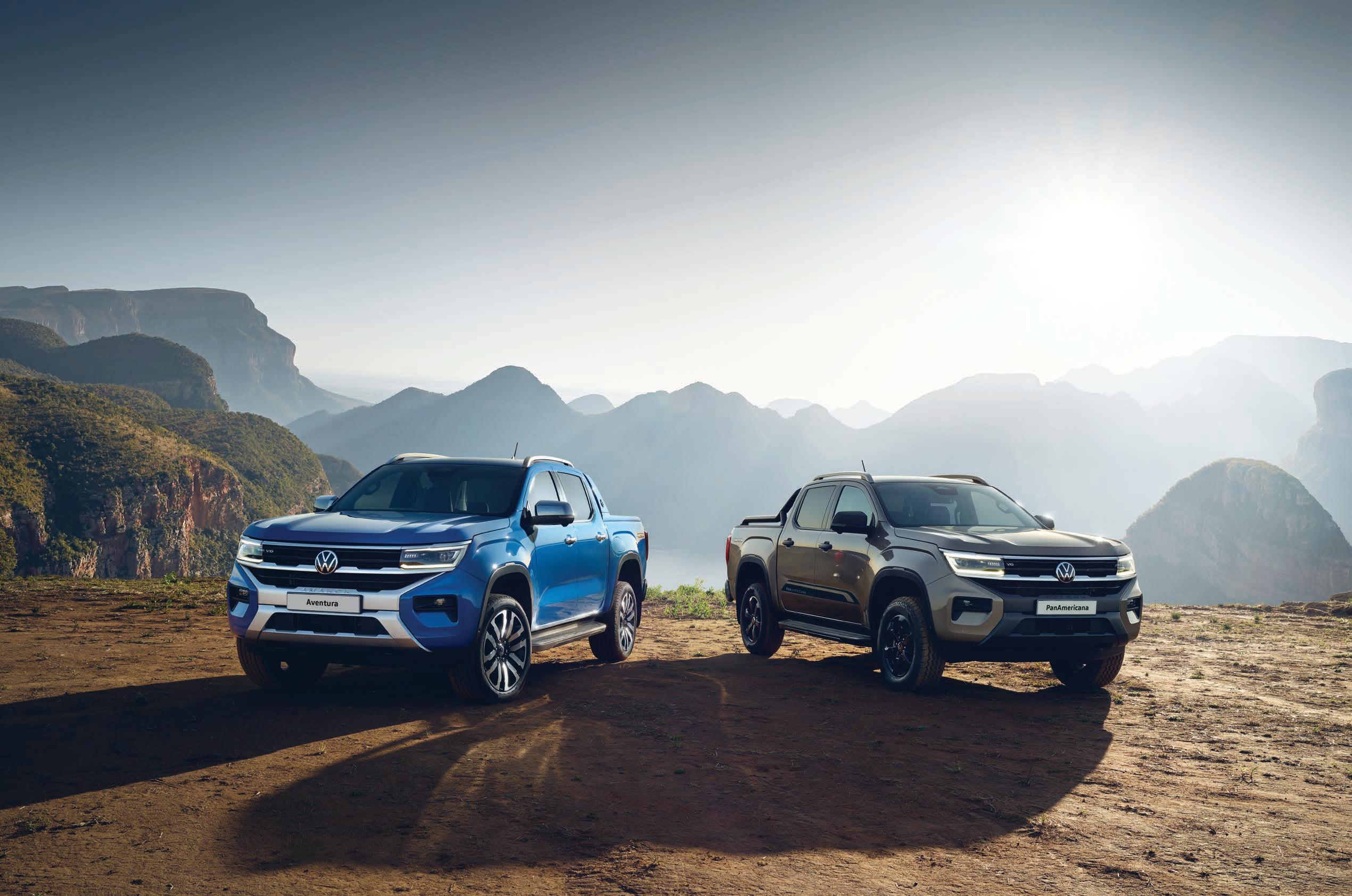















































































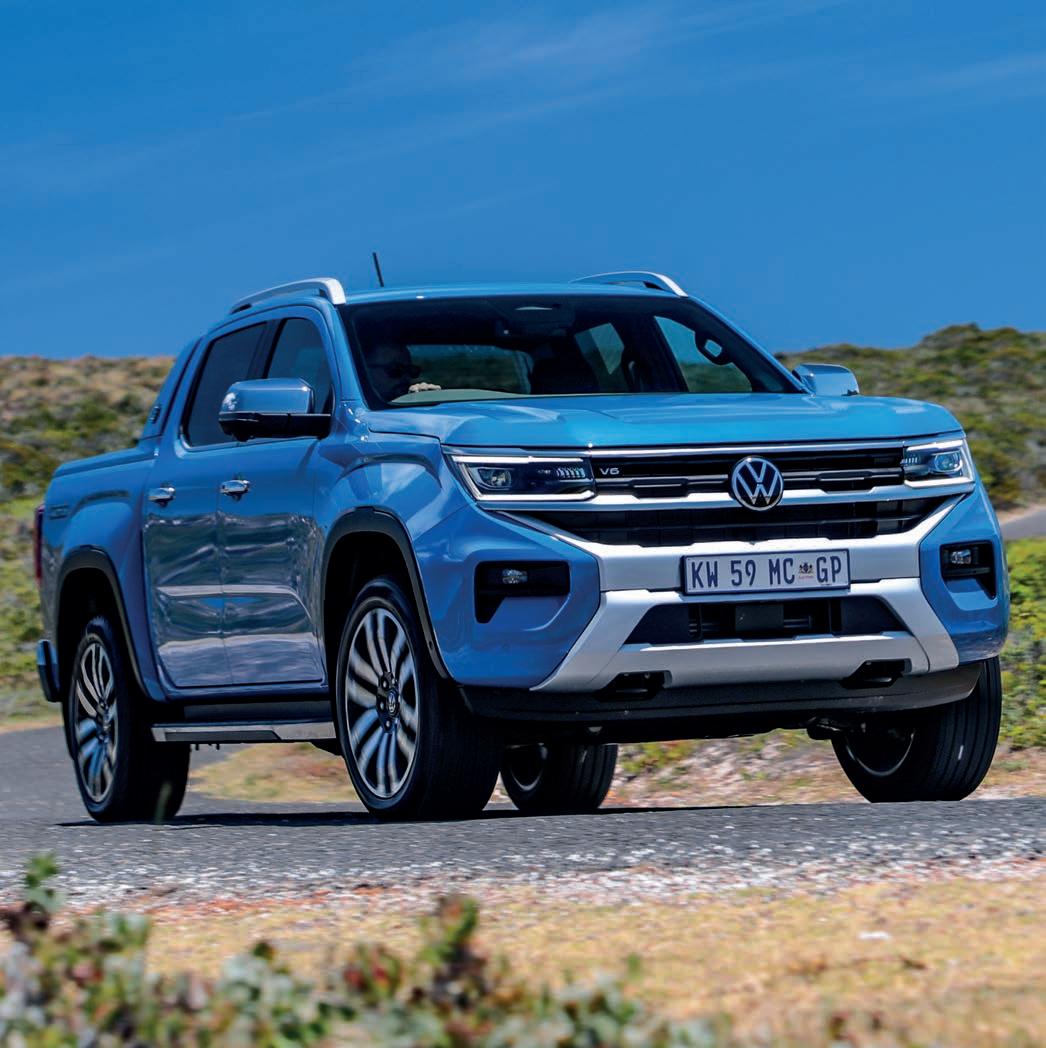

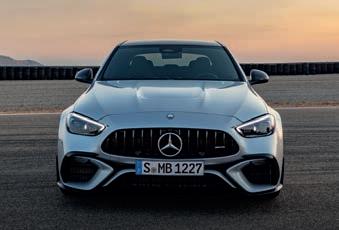
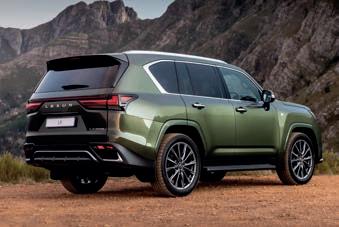
CONTENTS 54 LAUNCH PAD Volkswagen Amarok 18 NEWS BMW 3.0 CSL 44 COVER STORY Mercedes-AMG C63 S E Performance 98 DEEP DRIVE Lexus LX ISSUE 07 10 ISSUE 7 APEX


CONTENTS
16 FIRST WORD
NEWS
18 BMW 3.0 CSL
20 Porsche 911 Dakar
22 Volvo EX90
26 Lamborghini Huracán Sterrato
FEATURE
30 Table torque Formula E in SA
38 Winged wunder Porsche 911 GT3 RS

44 Hybrid DNA Mercedes-AMG
C63 S E Performance
78 Press ‘R’ VW Golf R & Tiguan R
LAUNCH PAD
54 Multi-purpose pick-up
VW Amarok
58 Peak potential Ford Everest

60 Great 86 Toyota GR86
64 Tailored X-Trail Nissan X-Trail
66 H6 surge Haval H6 HEV

67 Fresher than ever Hyundai Venue
58
38

Porsche 911 GT3 RS 116 DEEP DRIVE Kia Sportage
FEATURE
LAUNCH PAD Ford Everest
12 ISSUE 7 APEX




COLUMN 74 Are you not infotained? by Papi Mabele 77 Why not buy an old-school BMW? by
LIFESTYLE 52 Dress to impress 68 Fitness watches 84 Pots, pans & potjies 120 Riding shotgun with Siv Ngesi 137 The reading room DEEP DRIVE 92 Aston Martin DBX707 98 Lexus LX 600 F Sport 102 BMW iX3 M Sport 106 Audi RS3 quattro Sportback 110 Jeep Grand Cherokee L 3.6 4x4 Overland AT 116 Kia Sportage 1.6 T-GDi GT Line DCT LONG-TERMERS 126 Ford Ranger BiT 4x4 Stormtrak 10AT 127 Suzuki Celerio 1.0 GL MT BIKE 128 BMW R18 FINAL WORD 138 Mat Watson on cars CONTENTS 60 LAUNCH PAD Toyota GR86 120 LIFESTYLE Riding shotgun with Siv Ngesi 78 FEATURE VW Golf R & Tiguan R 14 ISSUE 7 APEX
Justin Jacobs









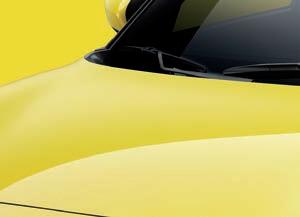
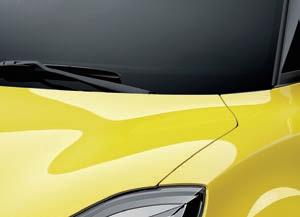

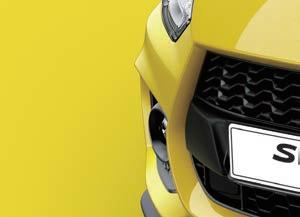









FEATURE 15 ISSUE 7 APEX
Taylor Swift recently released a brand-new album, Midnights. My girlfriend was elated, and when I heard one of the tracks features indie-rock songstress Lana Del Rey, I was intrigued. I adore Lana’s voice. I remember the first time I heard it, a decade ago. The song was Blue Jeans. To truly appreciate Snow on the Beach, we took the RS3 (p. 106), with its crisp Bang & Olufson sound system, for a day trip. When the last chorus ended, I indulged in the hyper hatch’s five-cylinder swansong, a tune worthy of making a greatest hits album for engine sounds. The same can be said of the howling soundtrack provided by the naturally aspirated flat-six sited below the rear wing of the latest 911 GT3 RS (p. 38).
Sound undoubtedly plays a significant part in how we perceive motor cars – some might even argue it signifies their souls – whether reminiscent of a high-pitched guitar solo of Led Zeppelin’s Jimmy Page or that of seeming silence, not Sound of Silence. The electric sound, that shoosh, that will be played by increasingly more vehicles as manufacturers move towards an electric future.

Hybrids of the two do exist and I’m not talking about only the mashups of rock bands collaborating with electronic-music artists; but back to cars. I’m talking about the one on this issue’s cover: the new-generation Mercedes-AMG C63 S, which now dons the E Performance moniker. Much has been said about the sound of A alterbach’s plug-in hybrid performance sedan, which has ditched its forebear’s V8 for an electrified four-pot. The jury is still out on its sound. After seeing and hearing a pre-production version of the PHEV C63 at Benz’s local production facility, although not a burbling V8 tune – one undoubtedly worthy of making a greatest hits album – it didn’t sound bad at all … not so much that I would skip the track. There’s no denying the performance it will put but you can read all about it on page 44. Pity pages don’t come with sound.
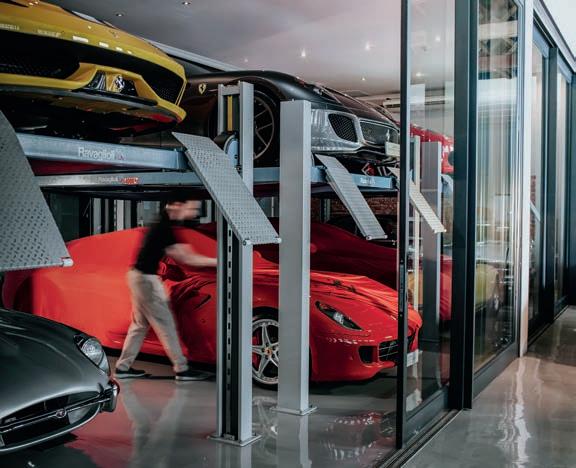
Skipping through the tracks of Midnights, there were some other admittedly good tunes. However, considering the car we were driving, it seemed paradoxical. And that was just fine. There is another new album that’s arguably more suited to the RS3’s soulful exhaust note: Ozzy Osbourne’s Patient Number 9. Best go for another drive. Before starting the engine and pressing play, I would like to thank our talented contributors. It’s been a joy compiling these pages.
apexmag.co.za apexmag.co.za @apexmagza apexmagza
THE TEAM
Publisher: Vann van Staden Editor: Marius Boonzaier Art director: Bianca-Leigh Nagel Lifestyle editor: Lauren Zuidema
Contributors: Thea Beckman, David Donde, Ian McLaren, Jennifer Campbell, Melinda Ferguson, Justin Jacobs, Papi Mabele, Juliet McGuire, MotorMagnet, Kumbirai Mtshakazi, Mark Smyth, Mat Watson, Vann van Staden

Proofreader: Margy Beves-Gibson
Advertising and editorial queries: 021 712 3842 / vann@apexmag.co.za
Published by: APEX Exchange (Pty) Ltd Distributor: On The Dot / Media Support
16 ISSUE 7 APEX
MB
FIRST WORD
Enjoy the issue Marius mariusboonzaier

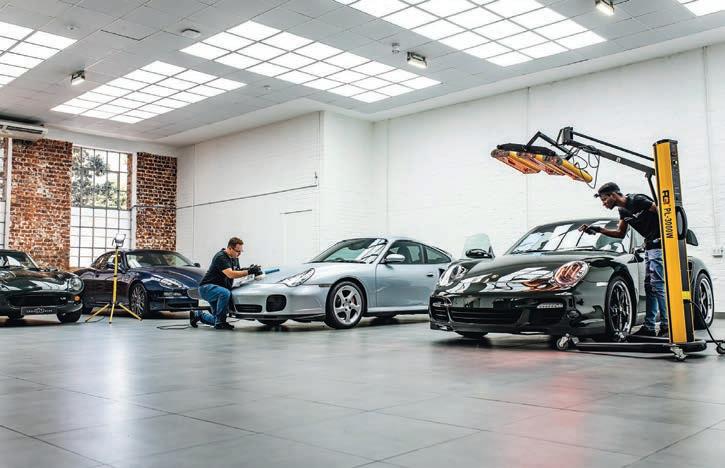



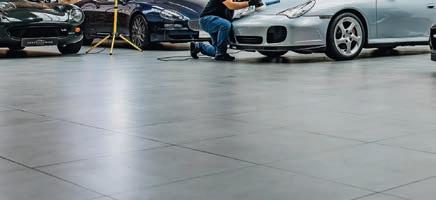


17 ISSUE 7 APEX
In issue 06, we celebrated BMW M’s 50th anniversary, sampling an array of the company’s new and classic models. However, as the end of the automaker’s 50th anniversary year came to a close, it lifted the covers of one last celebratory model, the most exclusive special edition it has ever produced. Meet the new 3.0 CSL. Only 50 examples will be made. According to the German marque, the latest 3.0 CSL was developed to combine the best of five decades of racing expertise from BMW M in an automobile with a highly emotional aura.
The original 3.0 CSL’s rear wing was arguably its most distinct design cue. That, and its sculpted bodywork. The new generation is no di erent. A newly designed grille dominates the front end. Together with the diamond-structure kidneys, two recesses in the front apron direct cool air to the drive system and six-piston 400 mm fore and single-
piston 380 mm rear brakes, housed in gold-coloured 19- and 20-inch forged light-alloy wheels. Of course, a modelspecific, fixed rear wing is also present.
The most powerful road-legal sixcylinder model ever created by BMW’s motorsport department, the 3.0 CSL’s 3.0-litre inline-six produces 412 kW and 550 Nm of torque. The engine revs until 7 200 r/min. And it must be noted that the powertrain is coupled with a six-speed manual transmission, transferring power to the tarmac via the rear axle. Purists rejoice!

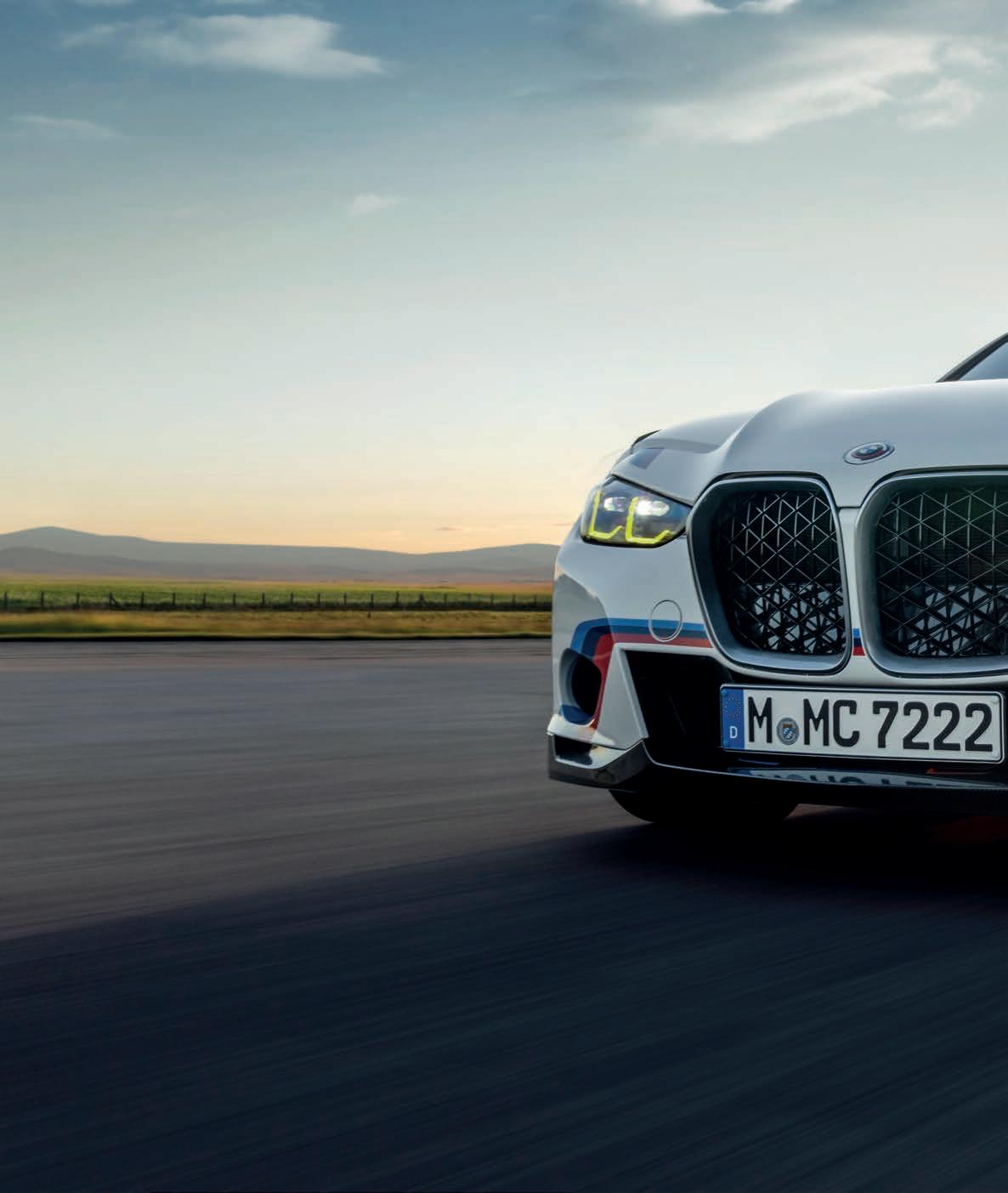
Billed as a masterpiece of engineering embodying the essence of racing passion, the new BMW 3.0 CSL is an emotional homage to the original ‘Batmobile’.
18 ISSUE 7 APEX NEWS







NEWS 19 ISSUE 7 APEX
911 NO LIMITS










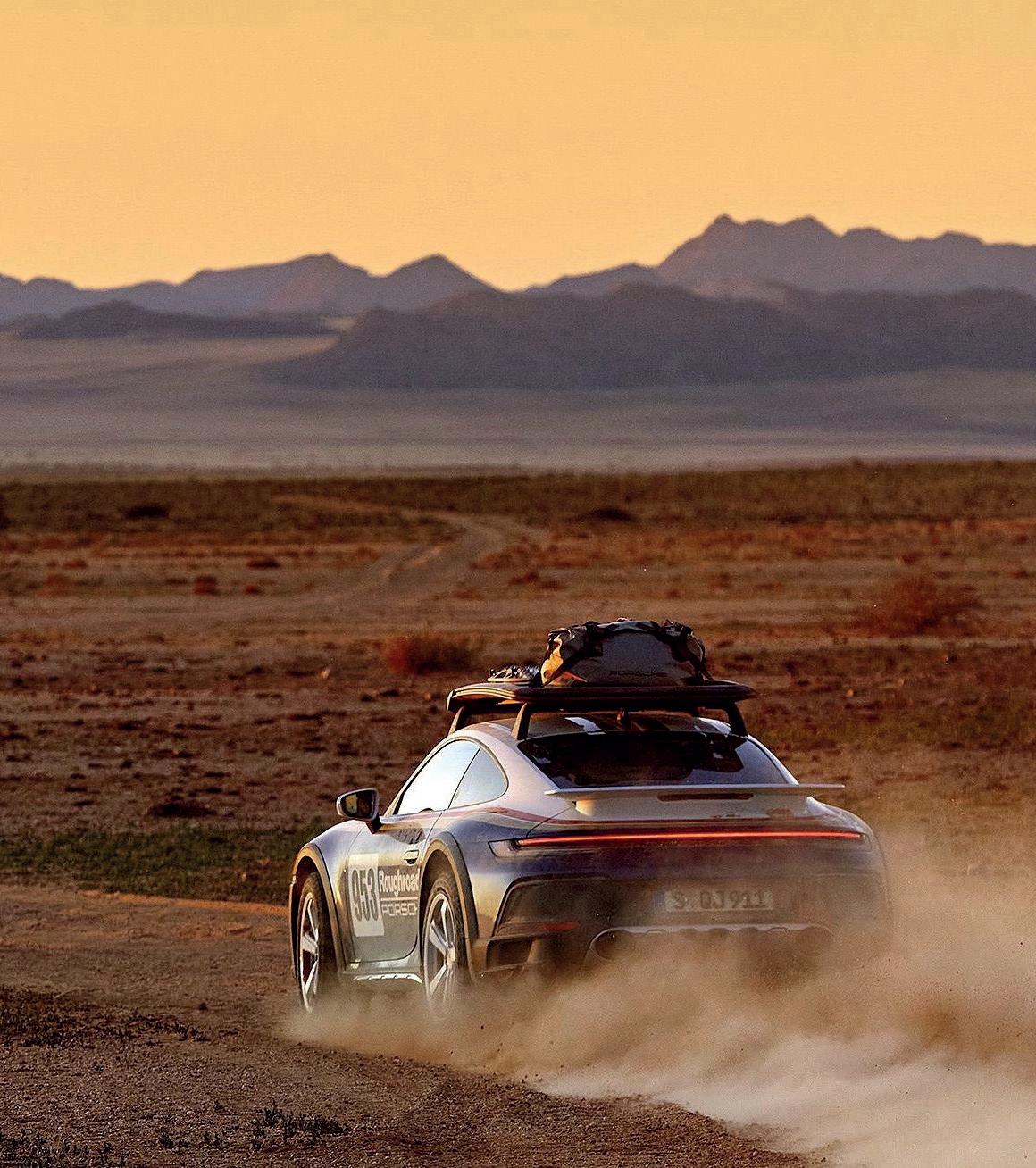

PORSCHE� , S ALL� TERRAIN NEUNELFER SHOWCASES THAT THERE ARE HARDLY ANY LIMITS TO THE 911.

Evoking the first overall victory by Porsche in the 1984 Paris–Dakar Rally, the 992-generation 911 Dakar is a Carrera reimagined for all-terrain adventure. Indeed, compared to the latter (when equipped with a sports suspension set-up), the tall(er)riding 911 has 50 mm more ground clearance, which can be lifted by a further 30 mm at the front and rear thanks to the standard-fitment lift system. According to the Stuttgart-based brand, the 911 Dakar’s ramp angle rivals that of conventional SUVs.

Although, this increase in ground clearance isn’t merely for tackling obstacles at a slow pace. The German marque says the ‘high level’ setting is available for ambitious drivers who wish to travel o the beaten track at speeds of up to 170 km/h. Adding to its sporty o -road attributes are two driving modes – Rallye and O road – and specially developed Pirelli Scorpion all-terrain tyres measuring 245/45 and 295/40 fore and aft, respectively. The chunky rubber (the tread pattern is 9 mm deep) is wrapped around 19inch front and 20-inch rear wheels.
A 3.0-litre twin-turbocharged flat-six transfers 353 kW and 570 Nm of torque to the tarmac, or, in the 911 Dakar, the roads less travelled, via an eight-speed dualclutch transmission. This all-wheel-drive 911 completes the obligatory 0-100 km/h sprint in 3.4 seconds. The top speed is electronically governed to 240 km/h.

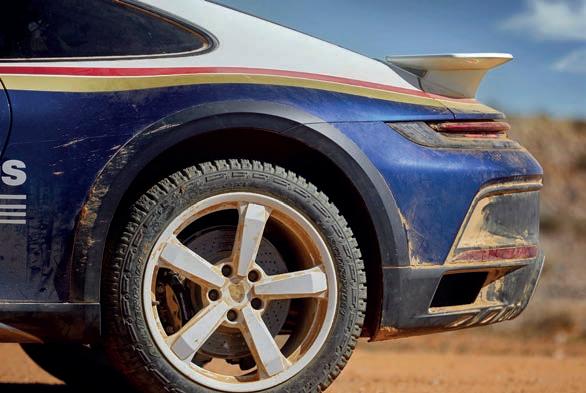

NEWS 21 ISSUE 7 APEX
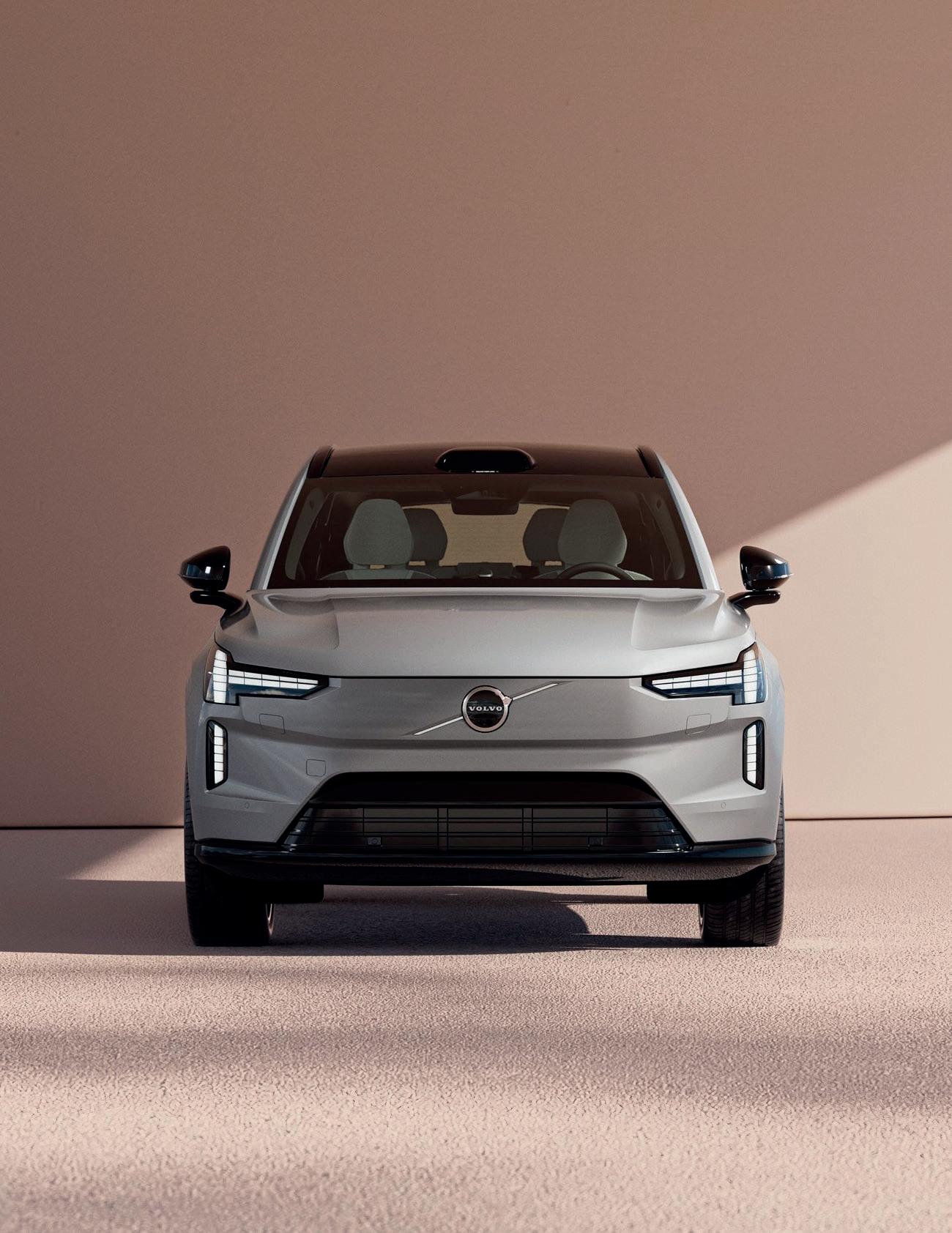



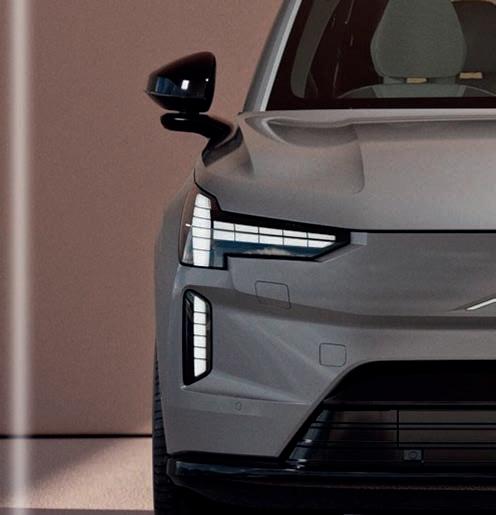







ot 22 ISSUE 7 APEX
Guiding he nbur g

























Signifying the start of something new for Volvo, the EX90 is a statement of where the firm is heading – fully electric and climate neutral by 2030 and 2040.


Safe and sound
According to the Swedish marque, the standard safety in the EX90 is higher than any car it has ever built. The systems are designed to understand you and the vehicle’s surroundings. In addition, the set-up becomes smarter and, as a result, safer over time, learning from new data and updating. The EX90’s ‘invisible’ safety shield comprises state-of-the-art technologies.


Exterior sensors respond when the driver’s inputs are a fraction too slow. Lidar senses the road in front, no matter the time of day or speed. Inside, sensors and cameras gauge eye-gaze concentration. When this system picks up the driver is drowsy or inattentive, it alerts them with a subtle nudge, and when they fall asleep or become ill, the car will stop and call for help.


NEWS
Computing companion

The EX90’s core functions are powered by a system comprising NVIDIA DRIVE AI Xavier and Orin, Snapdragon Cockpit Platforms and in-house-developed software. Volvo maintains this provides a more responsive and enjoyable experience inside the car. “Your Volvo EX90 won’t be just a new car; it will be a highly advanced computer on wheels,” added the Gothenburg-based brand. “[It is] the first Volvo to be truly defined by its software and part of a wider ecosystem, connecting to your home and your other devices. The Volvo EX90 is the start of something new for Volvo Cars in many ways,” said Jim Rowan, chief executive.
The automaker says the EX90’s 14.5-inch portrait-orientated touch-enabled display is a gateway to one of the best infotainment systems. Google is built-in. Thus, several apps, including Google Assistant and Maps, are available from Google Play. Not an Android user? Not to worry, the set-up is also compatible with Apple CarPlay. Music is streamed through a new reference-quality Bowers & Wilkins sound system with Dolby Atmos. Headrest-integrated speakers provide immersive sound.

24 ISSUE 7 APEX NEWS
Emissionfree shoosh
Based on a brand-new platform, the EX90 will initially be available with a twin electric motor arrangement and all-wheel drive. The former is coupled with a 111 kWh battery. The permanent magnet electric motors produce a combined output of 380 kW and 910 Nm of torque. The company claims its emissions-free flagship SUV can travel up to 600 km on a single charge (WLTP test cycle). A 10 to 80 per cent recharge takes around 30 minutes.
In addition, the EX90 is the firm’s first car to o er bidirectional charging. This technology allows you to use the battery as an extra energy supply. so you can power your home, another electric Volvo or devices.
According to Volvo, the EX90 contains approximately 15 and 25 per cent of recycled steel and aluminium and 48 kg of recycled plastics and bio-based materials. Around 15 per cent of plastic is used in the car.


ALL-TERRAIN-HONED

























Billed as the first supercar designed for maximum driving pleasure on loose or dirt surfaces, the Huracán Sterrato delivers a new degree of thrills.
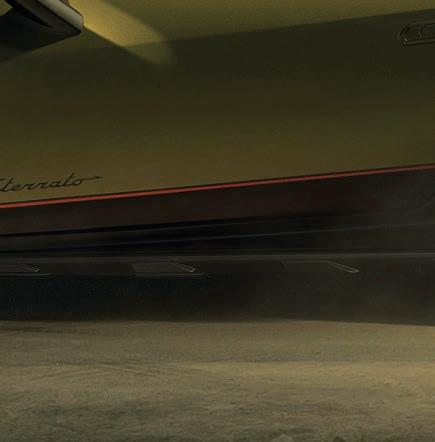




26 ISSUE 7 APEX
ALL-TERRAIN-HONED HURACÁN



































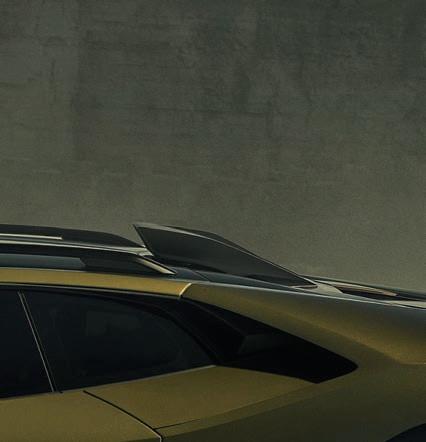
“Breaking new ground in driving sensations”, the Raging Bull brand says its all-terrain supercar “belongs in the world’s most dynamic and exciting driving environments”. The Huracán Sterrato achieves this with an updated version of Lamborghini’s Integrated Vehicle Dynamics (LDVI) system. The set-up features specific Strada and Sport calibrations and a Rally mode for enhanced low-grip conditions.
In addition, the Sterrato’s fore and aft tracks are 30 mm and 34 mm wider than its EVO stablemate’s. The ground clearance is up by 44 mm “to ensure greater suspension travel”. The suspension arrangement is of the independent double-wishbone variety. MagneRide electromagnetic damper control is also present.





Adding to its all-terrain capability, the front end features aluminium underbody protection. The sills have been reinforced and the air intake intake at the rear supplies clean air to the engine when driving on dirt roads.






The Huracán Sterrato is equipped with the brand’s 5.2-litre V10 petrol powertrain, producing 449 kW and 565 Nm. A seven-speed dual-clutch transmission directs power to an electronically controlled all-wheeldrive Haldex system.
“With the high-speed all-terrain concept of the Sterrato, we have uniquely combined the driving experience of a true super sports car and the fun of driving a rally car,” said Rouven Mohr, Lamborghini’s chief technical o cer. “The Sterrato delivers a new degree of driving thrills.”


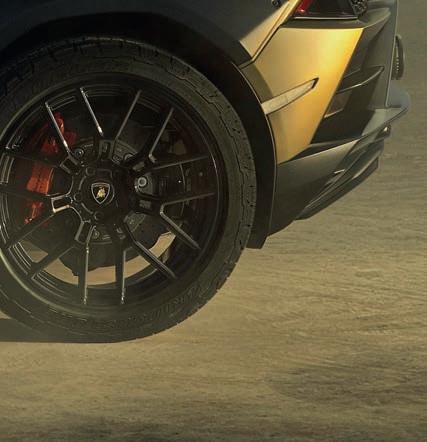
APEX 0-100 km/h 3.4 seconds 0-200 km/h 9.8 seconds Top speed 260 km/h


T ORQ
















































































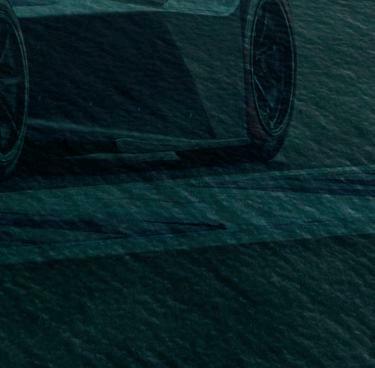











TABLE ORQUE











After a COVID-19-related false start in 2022, the ABB FIA Formula E World Championship is finally set to power into South Africa’s Mother City. Contributor Ian McLaren takes a closer look at what we can look forward to.




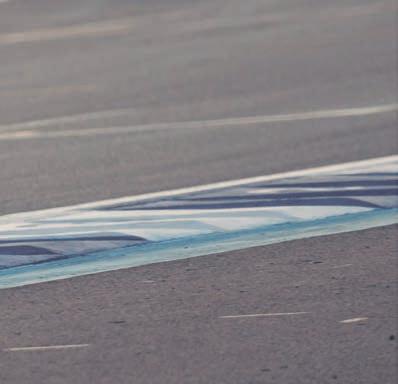

Words: Ian McLaren IanMcLaren76






















31 ISSUE 7 APEX FEATURE
postcard-inspiring coastline often touted as an ideal venue for a Monaco-mimicking motorsport event. Despite recurring annual headlines suggesting Formula One might be poised to race around Cape Town’s Green Point precinct, any number of logistical challenges – including costly infrastructure upgrades and a notably vocal local homeowners’ association – dictates this is never likely to be greenlit. Yet, devised in 2011 to introduce a more sustainable, cleaner and quieter form of worldclass, single-seat racing to the streets of some of the most famous cities in the world, the ABB FIA Formula E Championship heads into its ninth season and the Mother City is confirmed as the third stop on its 2023 calendar. Hosted by South African promotor e-Movement, the
first Formula E race to be held in Southern Africa will be the main event of a week-long festival aimed at creating awareness and, ultimately, excitement around what’s possible when it comes to our necessary, sustainable future.
Of course, as South Africans grapple with the prospect of up to eight hours of staged power outages per day, the idea of a racing formula that relies solely on electricity visiting our shores has drawn plenty of scepticism. Such has been the evolution of Formula E since its first race in Beijing in 2014 – where a midrace car change was required for a driver to complete the distance – this FIA-status series now travels with its own biofuel-powered generators capable of delivering 100 per cent of the energy needed to run a full race weekend.

32 ISSUE 7 APEX FEATURE

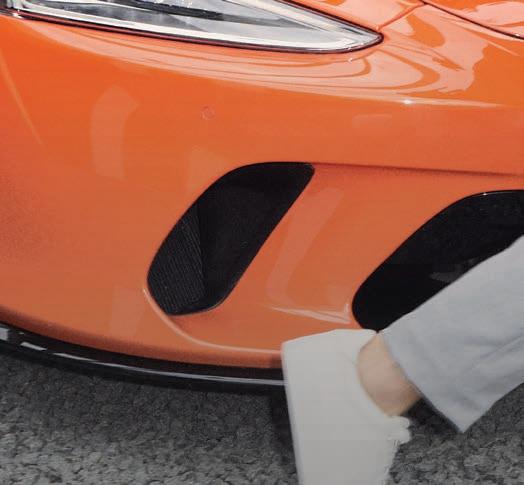










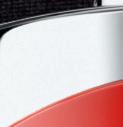







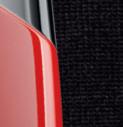




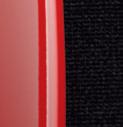










As a series monitored closely by most of the world’s largest car manufacturers, while brands like MercedesBenz, Audi and BMW have since turned their respective attentions to other motorsport categories as alternative testbeds on which to develop future electrification plans, Formula E remains home to some of the biggest names in the industry. Joining brands like Porsche, Jaguar,
Nissan and Citroën for the 2023 season are legendary racing names like McLaren and Penske, while Maserati returns to a starting gird for the first time in 60 years. An outlier when it comes to notable racing heritage, Mahindra Racing has been a member of the Formula E paddock since its inaugural season, hosting several of the series’ fastest drivers during this time.
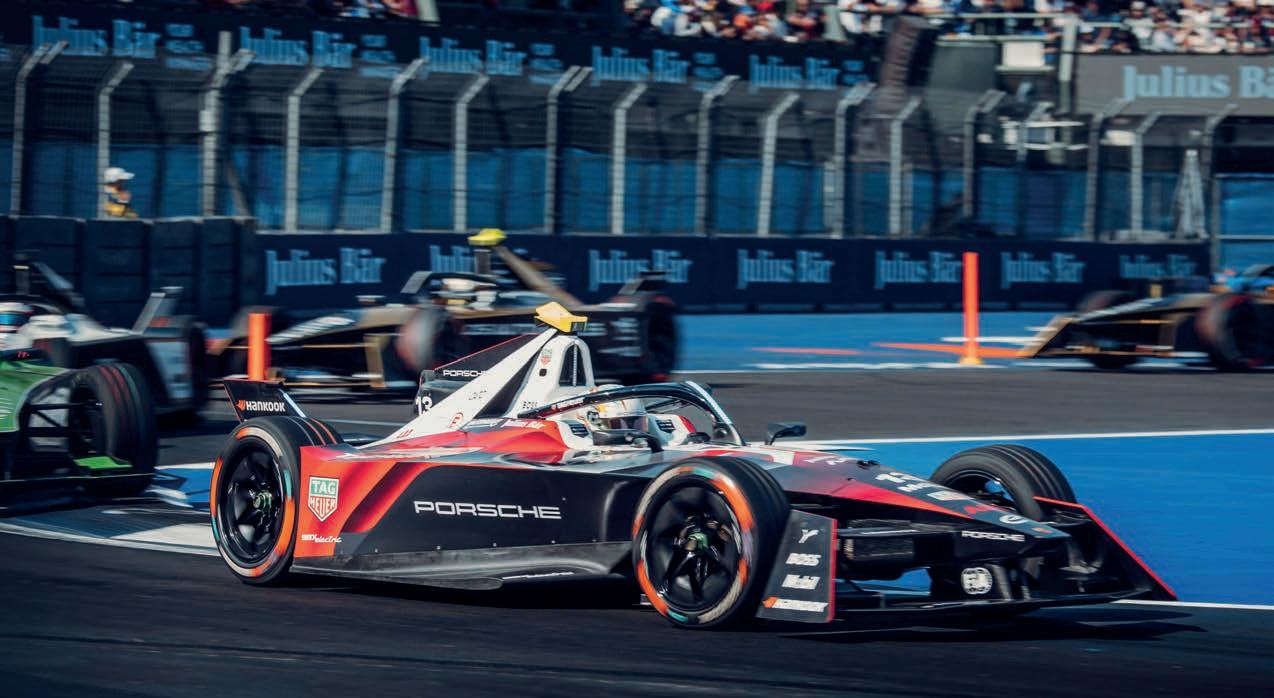

35 ISSUE 7 APEX FEATURE

The significant news regarding Season 9 of Formula E is the introduction of its third-generation racing car. Noted for mimicking the profile of a paper aeroplane, this sleek new racer o ers more power than its predecessor but now also features a second, 250 kW electric motor on its front wheels. Propulsion to a top speed of 320 km/h comes from a 350 kW motor powering the rear wheels and the secondary unit is designed to harness regenerative braking energy that the driver can access during the race. Such is the e ectiveness of this set-up that up to 40 per cent of the energy required to complete the race distance is sourced via this new system.
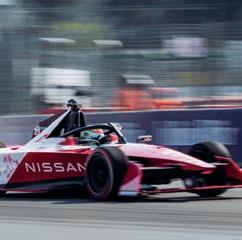
The juxtaposition of a Formula E race weekend compared to other more traditional forms of motorsport is that the absence of the alluring soundtrack associated with a highly tuned internal combustion engine is one of the reasons these nevertheless lightning-fast cars can race – and entertain – within the confines of a city centre.
A market of motorsport enthusiasts can now imagine a time when Formula 1 returns to the immaculately refurbished Kyalami Racing Circuit, with the allure of a Cape Town-hosted Formula E street circuit o ering yet another world-class sporting spectacle to this part of the world. A




FEATURE 37 ISSUE 7 APEX
WINGED

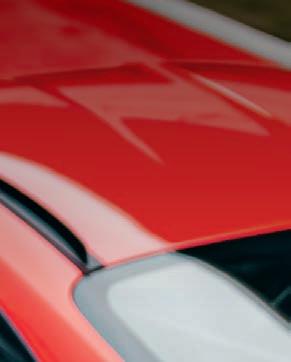
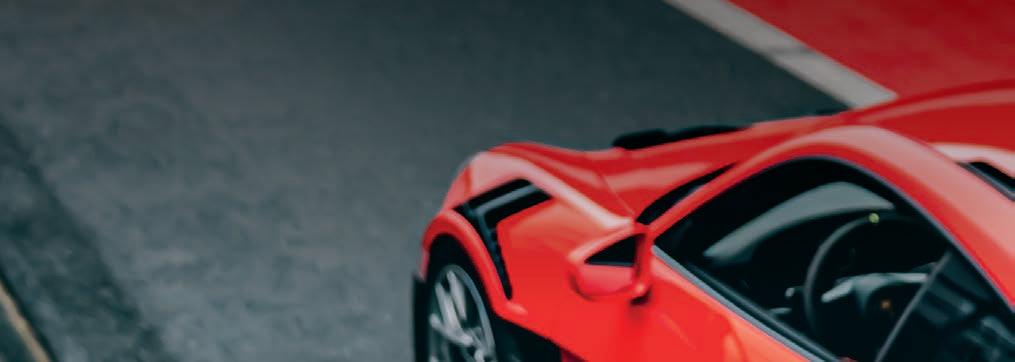

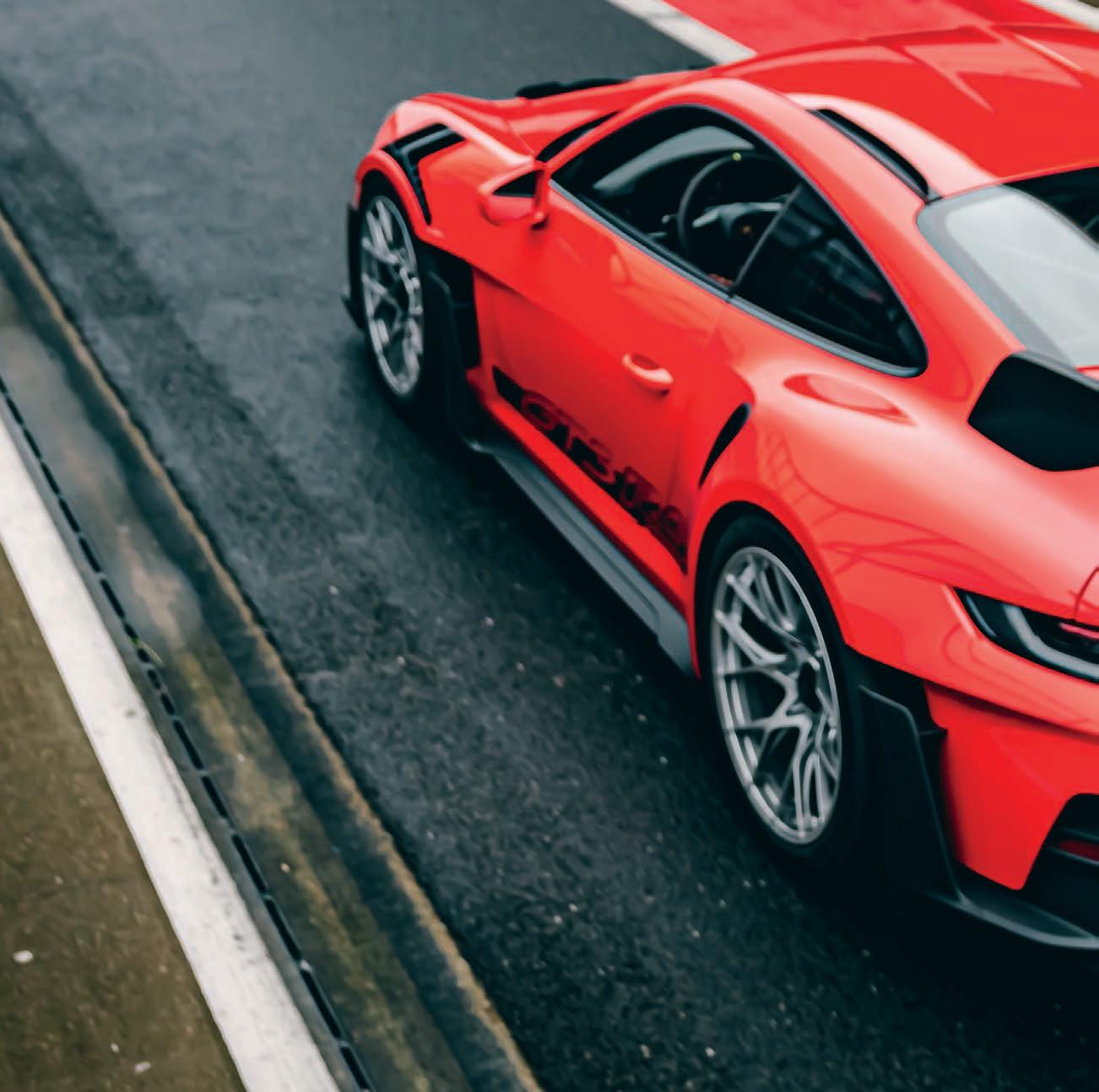
38 ISSUE 7 APEX
WUNDER

The new GT3 RS is an uncompromising piece of engineering and, around Silverstone circuit, a true showstopper…


Words and photos: MotorMagnet motor_magnet

39 ISSUE 7 APEX
FEATURE
The term race car for the road gets thrown around quite loosely these days.


But I can’t think of a better phrase to put the new GT3 RS into context. It is purpose-built, extreme and uncompromising on performance. It pushes the envelope and sets the benchmark for what a roadlegal race car truly is.


The formula is simple. The new GT3 RS is powered by an optimised version of the high-revving 4.0-litre naturally aspirated boxer-six found in the standard GT3 (if ‘standard’ can ever be used to describe a car from Porsche’s GT department). Power has been increased to 386 kW, with peak torque down to 465 Nm. The engine howls to 9 000 r/min. This is primarily achieved through new camshafts. The RS model’s seven-speed PDK has shorter overall gear ratios than the dual-clutchequipped 911 GT3. The result is a 0-100km/h sprint time of 3.2 seconds.
The central-radiator concept has been carried over from motorsport. It is positioned where your luggage would typically be in all other 911 models, with the front active aerodynamic elements integrated into the space. It keeps hot air from flowing into the engine intakes at the rear with the help of roofmounted fins.


Aerodynamics is what truly puts the 992-generation GT3 RS in another league. The introduction of active aerodynamics on a Porsche GT car for the very first time is historic. And while the

giant rear wing with DRS is instrumental, aerodynamicist Mathias Roll points out what makes it truly e ective is that it works in tandem with the active aero flaps underneath the front bumper. The two-piece front wing increases downforce by up to 80 per cent on the front axle, bringing the overall downforce to 860 kg. The fully panelled underbody includes 30 fins for targeted airflow and downforce generation.
The new RS is undoubtedly made with clear intentions, but how does it all transfer to reality? Fortunately, we had the entire Silverstone F1 circuit to find out.
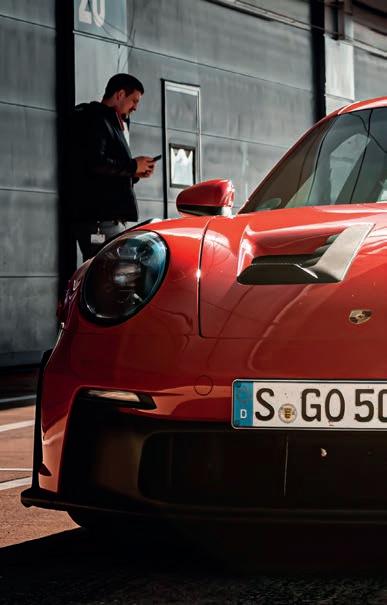
Falling into the carbon-fibre bucket seats, with the roll cage (also fashioned from the latter lightweight material) right behind you, certainly sets the tone. You are presented with a

FEATURE 40 ISSUE 7 APEX
new steering wheel with four di erent dials to adjust the suspension, torque vectoring, traction control and, of course, the driving mode. It’s very handy on a wet and cold Silverstone.
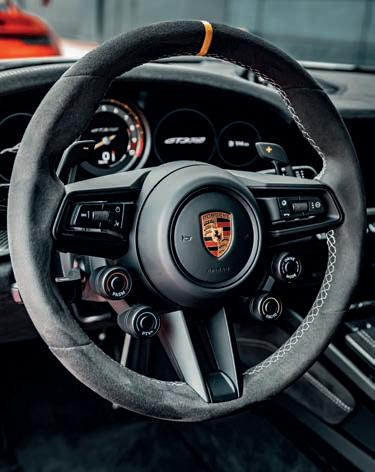
Start it up, and the familiar flat-six exhaust note envelops the cabin, resonating through a somewhat sparse interior. Set o , and immediately the car feels eager to breach the 30 km/h pitlane limit.




Driving onto the Silverstone circuit, you can't help but feel a tingle in your spine. There isn’t a single car I would rather have been in right then. I gingerly steered it through the first few corners, trying to get some heat into the Michelin Pilot Sport Cup 2 tyres before

unleashing it on the first straight. The shorter gear ratios are instantly noticeable as you come up quickly onto the first braking point. Hard on the brakes, the car sucks itself down to the point where the tarmac may crack. Turn-in. The mechanical grip is remarkable. Immediately you’re instilled with absolute confidence in the car. And with each corner you push it that little bit harder, it takes it all in its stride and pushes you on to exploit it further.
I believe a good car flatters the driver. The GT3 RS pushed me beyond what I thought I was capable of. It is a truly impressive piece of engineering and takes you right to the cusp of what a road car is capable of. A





FEATURE
1. A quartet of dials on the tactile steering wheel to adjust several settings.
2. No luggage space here, just the central radiator. Note the bonnet fins.
3. Grippy Michelin rubber, which, in addition to the active aero elements, keeps the new 911 GT3 RS firmly on the track.
1 2 3
RS ANCESTORS
996.2

Engine:
997.2 4.0
Engine:
997.1 Engine:


997.2
3.8
Engine: 3.8 L, flat-6, petrol Transmission: 6-spd MT Driven wheels: R Power/Torque: 331 kW/430 Nm 0-100 km/h: 4.0 seconds
991.2
Nm 0-100 km/h: 3.3 seconds Top speed: 310 km/h Weight: 1 420 kg
Engine: 4.0 L, flat-6, petrol Transmission: 7-spd dual-clutch Driven wheels: R Power/ Torque: 383 kW/470 Nm 0-100 km/h: 3.2 seconds Top speed: 312 km/h Weight: 1 430 kg
Aerodynamics is what truly puts the 992generation GT3 RS in another league. The introduction of active aerodynamics on a Porsche GT car for the very first time is historic.

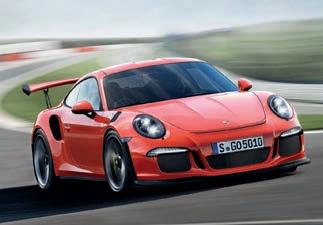


992
Price:

42 ISSUE 7 APEX FEATURE
3.6 L, flat-6, petrol Transmission: 6-spd MT Driven wheels: R Power/Torque: 280 kW/385 Nm 0-100 km/h: 4.4 seconds Top speed: 306 km/h Weight: 1 360 kg
4.0 L, flat-6, petrol Transmission: 6-spd MT Driven wheels: R Power/Torque: 368 kW/460 Nm 0-100 km/h: 3.9 seconds Top speed: 310 km/h Weight: 1 360 kg
R4 153 000 Engine: 4.0 L, flat-6, petrol
wheels: R Power/Torque: 386 kW/465 Nm 0-100 km/h: 3.2 seconds Top speed: 296 km/h Weight:
450 kg
Transmission: 7-spd dual-clutch Driven
1
3.6 L, flat-6, petrol Transmission: 6-spd MT Driven wheels: R Power/Torque: 305 kW/405 Nm 0-100 km/h: 4.2 seconds Top speed: 310 km/h Weight: 1 375 kg
4.0 L, flat-6, petrol Transmission: 7-spd dual-clutch Driven wheels: R Power/ Torque: 368 kW/460
991.1 Engine:
Top
speed: 310 km/h Weight: 1 370 kg

HYBRID













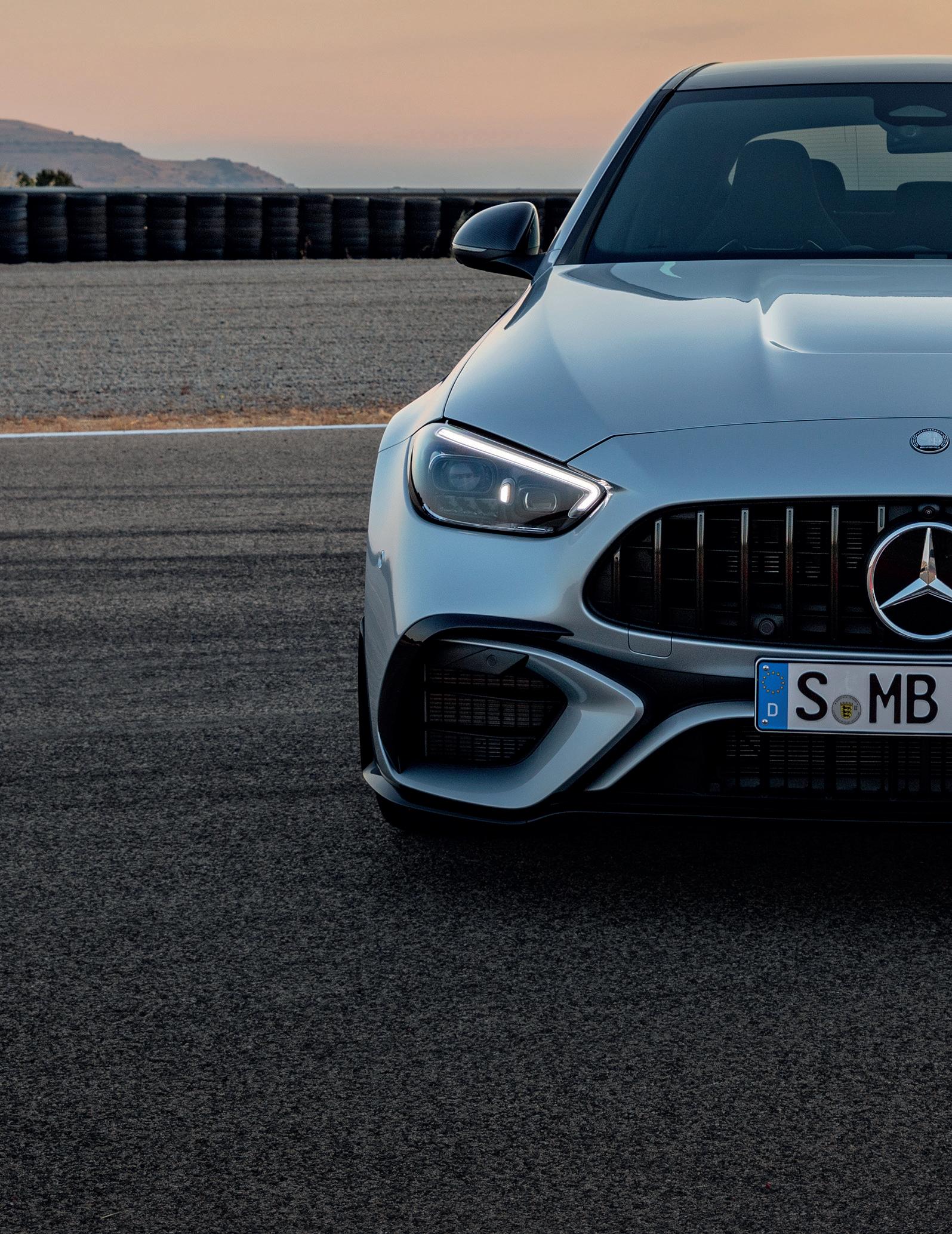
Mercedes-AMG has replaced the V8 in the C63 with a hybrid powertrain, but as we discovered in Spain, the new generation is about way more than just its engine.

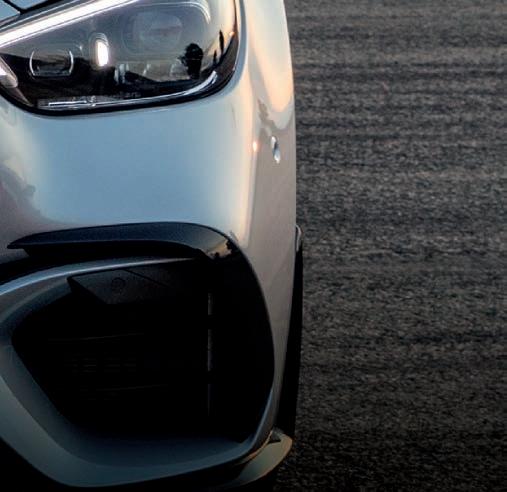


Words: Mark Smyth Motorscribe



HYBRID DNA











FEATURE
The Mercedes-AMG C63 is a car that’s all about noise, brute force, raw performance and that constant fear that one day you’ll discover its bite is worse than its bark. For years its heart has been a roaring V8, hand built by dedicated technicians in A alterbach, Germany, but those days are gone. Now we have the C63 S E Performance, and beneath the famous power bulges on the bonnet sits a 2.0-litre, four-cylinder petrol engine.

Not surprisingly, the news of the decision to go with a four-pot did not go down well with enthusiasts but there is more because the engine is mated to an electric motor. Yes, the C63 has gone hybrid; although, before you run o to drown your sorrows at the demise of the C63, this is no Prius, as we found out when we drove it at its international launch in southern Spain.
The electrified C63’s design language harks back to the original wolf-in-sheep’s-clothing days of pre-W204 versions. The power bulges are still there, now flanking a cooling duct; there are quad pipes at the back, a discreet boot spoiler and the front track is 76 mm wider than a regular C-Class’, but it’s all a bit more subtle.
That’s not the case inside, though, where there are digital displays galore as well as the usual AMG bucket seats, swathes of Alcantara, leather and carbon fibre. As well as the central
touchscreen, there’s a digital instrument cluster, which can be personalised with di erent themes and, at times, looks like you are in a racing sim. Add to that a massive head-up display that can easily dominate your view of the road ahead, and it’s all a bit gaming console, a bit over the top.
It is very comfortable, however, with the engineers retaining the premium everyday drivability of the latest-generation C, which, of course, is proudly built in East London, South Africa. There might be many buttons, a million menus and sub-menus, but most of the time, you’re not going to do much more than change the music.
You’ll be able to hear your favourite tracks better, too, because here’s something you probably never thought you’d get in a C63… electric mode. The 6.1 kWh battery will allow you to drive up to 13 km in silence, but this isn’t the new model’s party trick.
The sound might be gone, replaced by amplification of the four-cylinder in the cabin, but this is a new breed of C63. The P3 hybrid combination creates 500 kW – 350 kW from the engine and 150 kW from the electric motor – and there’s a massive combined torque output of 1 020 Nm, all of which enables a 0-100km/h sprint time of 3.4 seconds.
T
BILBOA
BARCELONA MADRID VALENCIA
SEVILLE GRANADA 46 ISSUE 7 APEX
CORDOBA MALAGA FEATURE


47 ISSUE 7 APEX
For the first time, the C63 has 4Matic+ all-wheel drive and rear-wheel steering. There are eight AMG Dynamic Select Drive programmes, each of which provides varying levels of power, plus it gets a drift mode, with the ability to send 100 per cent of the power to the rear wheels.

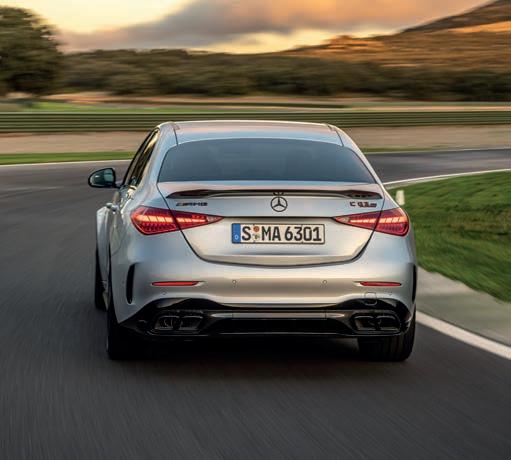
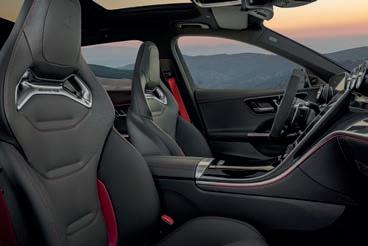
The new C63 isn’t about the numbers, though, and it’s definitely not about the sound. Instead, it’s about the dynamics. René Szczepek is the head of driving dynamics development for AMG, and he told us the decision to switch to hybrid was made six years ago. At the same time, they realised they needed to develop not just a new car but a whole new driving dynamic for AMG.

“We have never changed the character of the C63 so much,” he says. “Our tasks were to make the car as drivable and predictable as possible in every situation.” Szczepek focused on the dynamics, taking the damping system from the AMG GT Black Series and creating a new rear sub-frame, increasing torsional sti ness and adding more strut bracing to provide a more direct steering feel.

The team also wanted to create a car that’s as quiet as possible in Comfort mode but can switch its character instantly when the driver wishes. Ultimately, he says, the aim was to create a “daily, drivable sports car”.
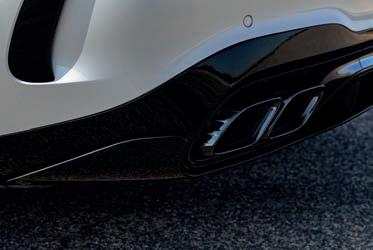
It didn’t take long behind the wheel to realise they’d nailed that aim superbly. It’s a little eerie to pull away in electric mode, although the neighbours will be happy. Still, the electric motor provides instant torque, and while Comfort mode delivers just 25 per cent of the battery’s power, engaging full kick-down gives you access to it all.
That’s for when you get out of town when it’s time to play with the driving modes, where even the ESP has been tuned to leave you alone and let you get on with it. There’s a bit of noise, but this is no longer what the C63 is about. Instead, it’s about unexpectedly sharp handling, phenomenal levels of adhesion and an ability to get on the power and keep pushing through every twist and turn, rapidly building up confidence in the engineering and understanding the work that Szczepek and his team have put in.
48 ISSUE 7 APEX FEATURE
Once upon a time, it would have had to give way to the BMW M3 or a Porsche 911 in a really twisty mountain pass, now it matches them turn for turn. On the technical Ascari race circuit, driving behind multiple DTM champion Bernd Schneider, the C63 held its line every time, where previously, we might have been waiting for the back end to step out. Its Race Track mode contains telemetry on various world tracks, and it even includes a Boost mode, complete with ‘Boost’ flashing on either side of the instrument cluster at pre-programmed points. It felt a bit Fast and Furious but hey, boost is boost.





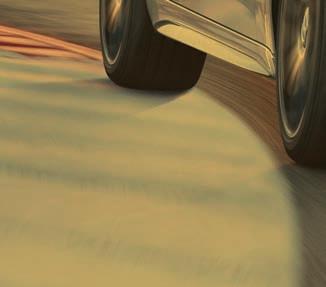

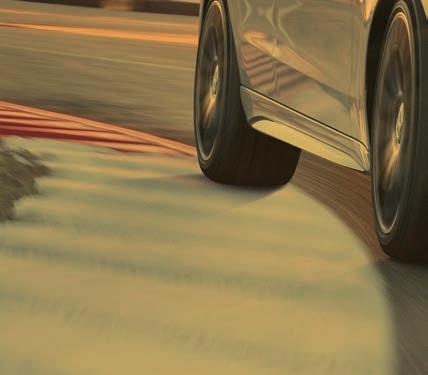

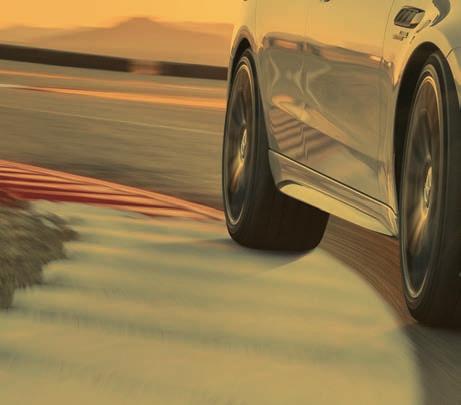

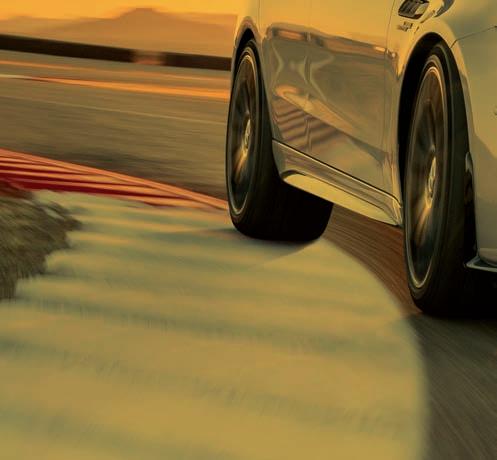
The gimmicks are not the focal points here, nor, surprisingly, is the hybrid system. Yes, it delivers in terms of power and e ciency, adding something di erent to the C63’s arsenal, but the complete change in character impresses. The C63 has gone from being a sledgehammer to a razor-sharp performance sedan. It hasn’t just had a heart transplant; its entire DNA has been rewritten. A








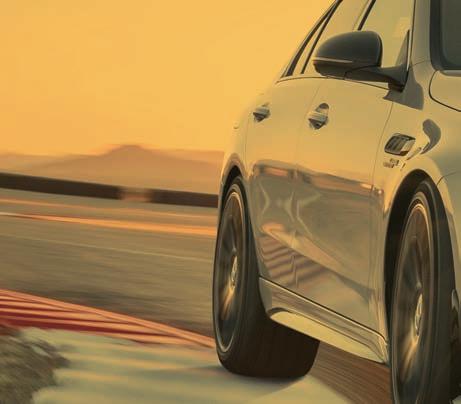



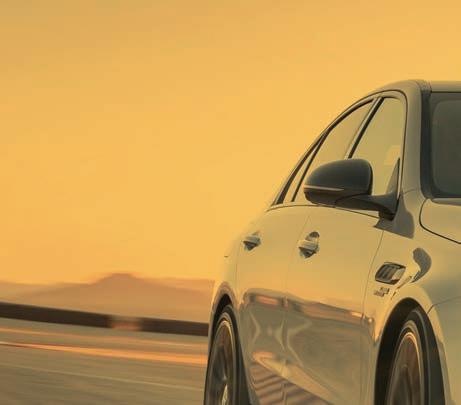
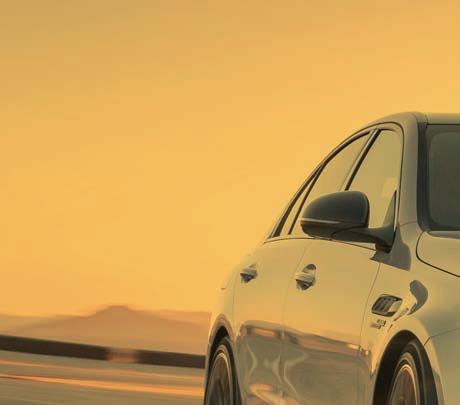







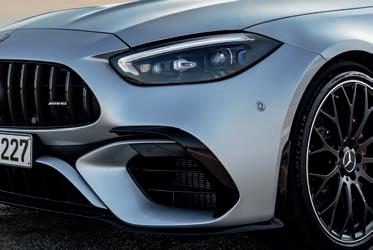


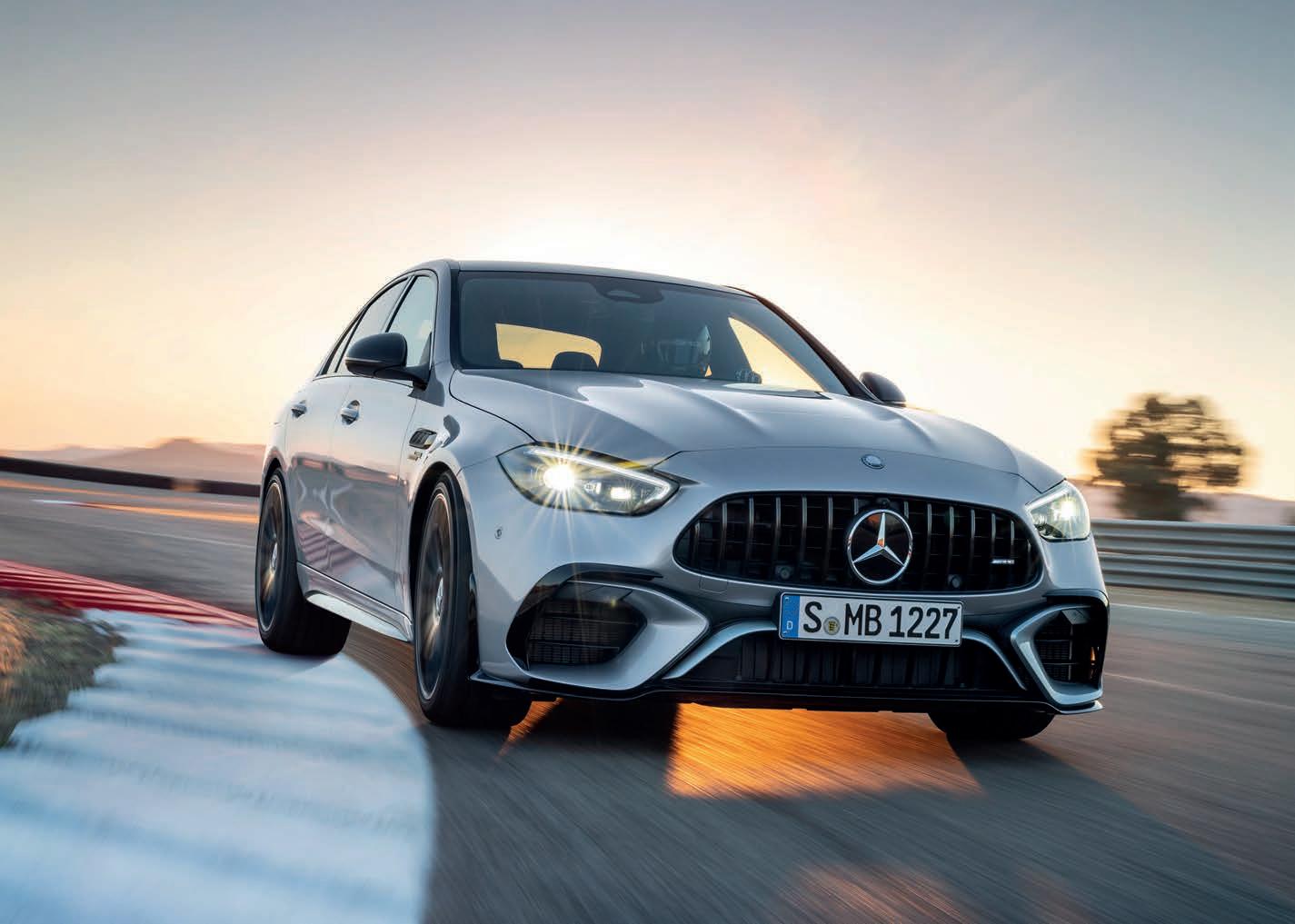
49 ISSUE 7 APEX
The C63 has gone from being a sledgehammer to a razor-sharp performance sedan
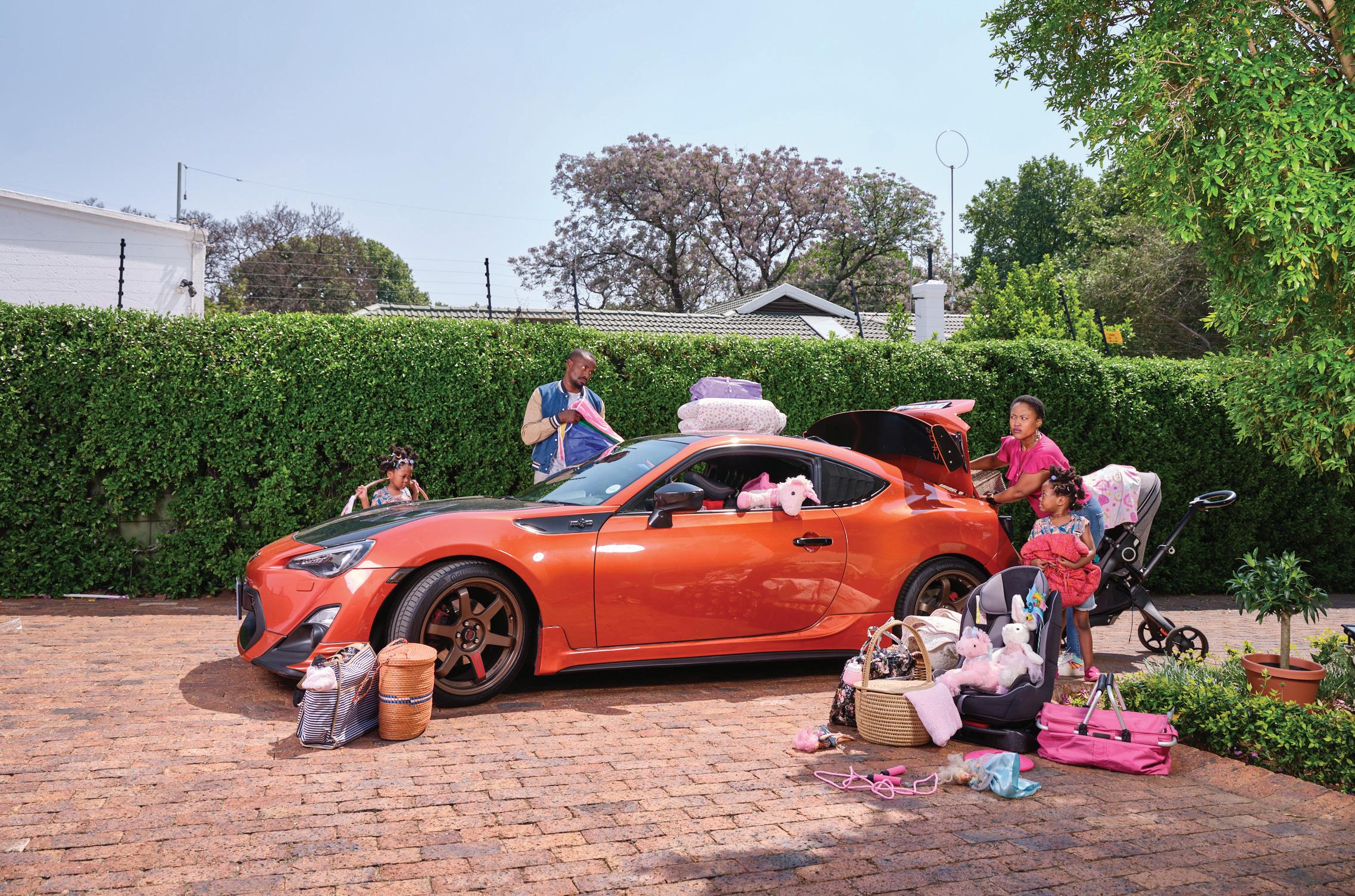
Does your medical aid suit your family? Move to the medical scheme that fits your journey and visit momentummedicalscheme.co.za























To carry style, you need to exude confidence. Pair stylish outfits with the latest fragrances, a match to elevate your signature look. BROUGHT TO YOU BY EDGARS Follow us on Instagram @edgarsfashion
Signature navy trousers R449.95 Signature Premium stripe shirt R399.99 Signature semi-formal bonded leather belt R199.99 Paco Rabanne Phantom EDT from R1 245
DRES S TO IMPRESS
Signature navy suit Jacket R1 099.95



Signature navy trousers R449.95
















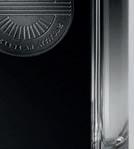



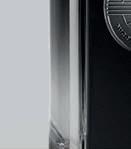






Signature red gingham check shirt R349.99 Signature semi-formal bonded leather belt R199.99 Mont Blanc Legend Red EDP from R1 299









53 ISSUE 7 APEX LIFESTYLE
Stone Harbour dobby shirt R229.95 Stone Harbour straight fit chino R399.95 Stone Harbour leather belt R249.95 Stone Harbour lace-up docksiders R399.95 Antonio Banderas The Icon 100 ml EDT R840
LAUNCH PAD
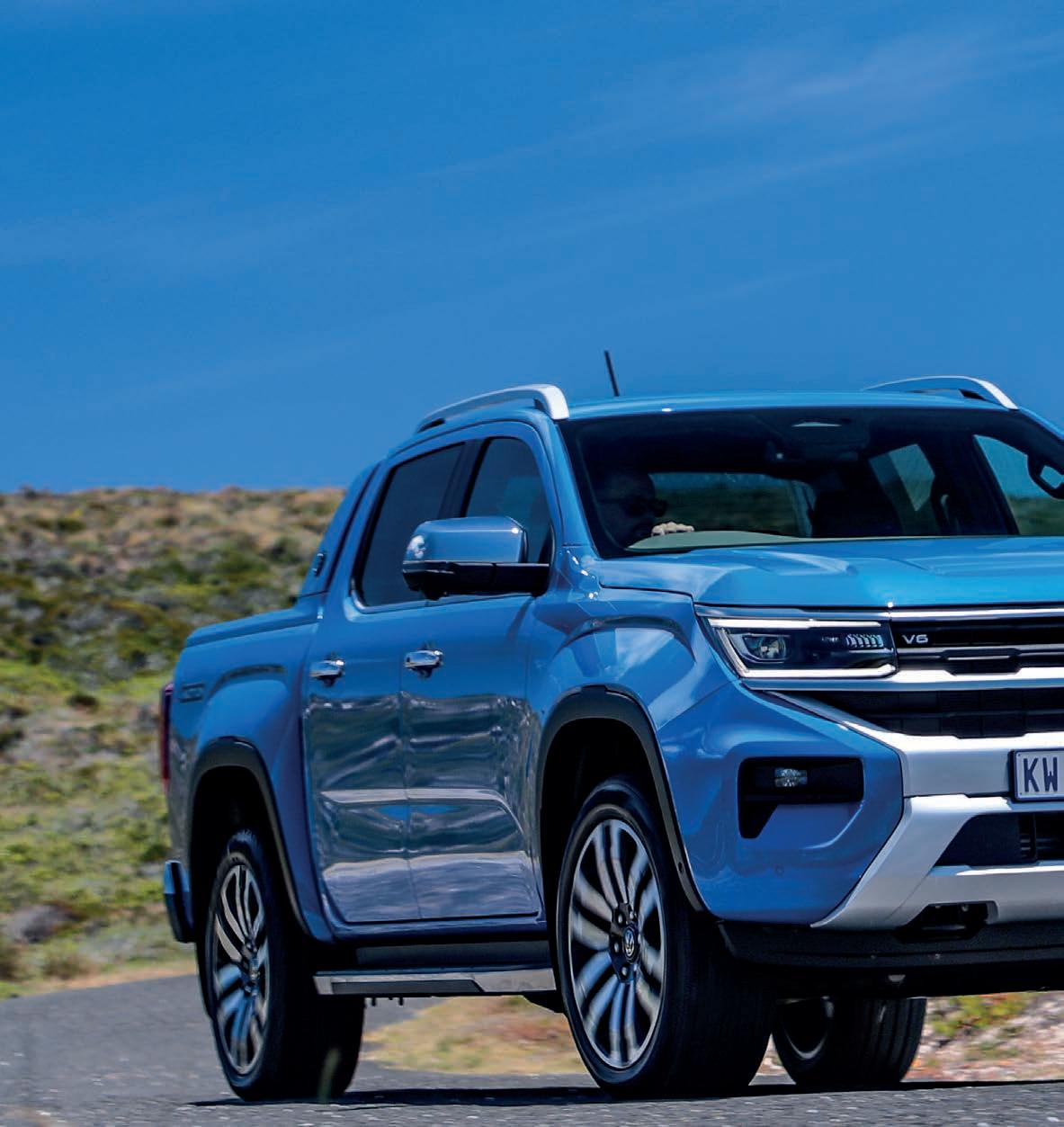

54 ISSUE 7 APEX LAUNCH PAD
Volkswagen Amarok V6

Words: Vann van Staden winewheelsandwatches
Multi-purpose pick-up
The new Amarok means business and comes to the party in the wilderness. We attended the international launch in Cape Town.

55 ISSUE 7 APEX
We often joke about the mullet hairstyle… Business in the front, and party at the back. The same applies to the new Volkswagen Amarok. It’s a remarkably refined leisure bakkie that can easily transition from traversing the roads less travelled in the wilderness to prancing around in the concrete jungle. As VW South Africa puts it: it’s a bakkie that acts as a multi-tool.
We attended the international launch right here on local shores. Yup, you read that right. The German marque thought
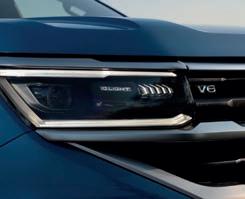

the best place to host it would be here. And it’s appropriate, as South Africa is where the latest iteration is built. It was the perfect opportunity for the Wolfsburg-based brand to showcase how the Amarok shines in the city and o the beaten track in some of the most picturesque environments in the Western Cape.
The Amarok has been a hit since it was introduced in 2010. It was arguably the first premium double-cab bakkie, o ering the practicality of a pick-up but with the comfort of an SUV. Globally, VW sold over 830 000 units of the first generation. Locally, the V6 turbodiesel variant of the


German-built bakkie proved most popular. It was rather appropriate, then, that it was the V6-powered Aventura and PanAmericana versions of the latest model we sampled at the launch.
The second generation, although having a load bed, is more SUV-like than ever. This applies to its exterior design, comfortable interior and more advanced technologies. In the Aventura guise, it looks luxurious and in the PanAmericana guise, ready for o -road adventures. Its large footprint lends to its imposing looks. Locally built alongside the new Ranger at Ford’s Silverton production
facility in Pretoria, the latest Amarok measures 96 mm longer than its forebear at 5 350 mm and 1 910 mm in width. The wheelbase has been stretched by 173 mm.
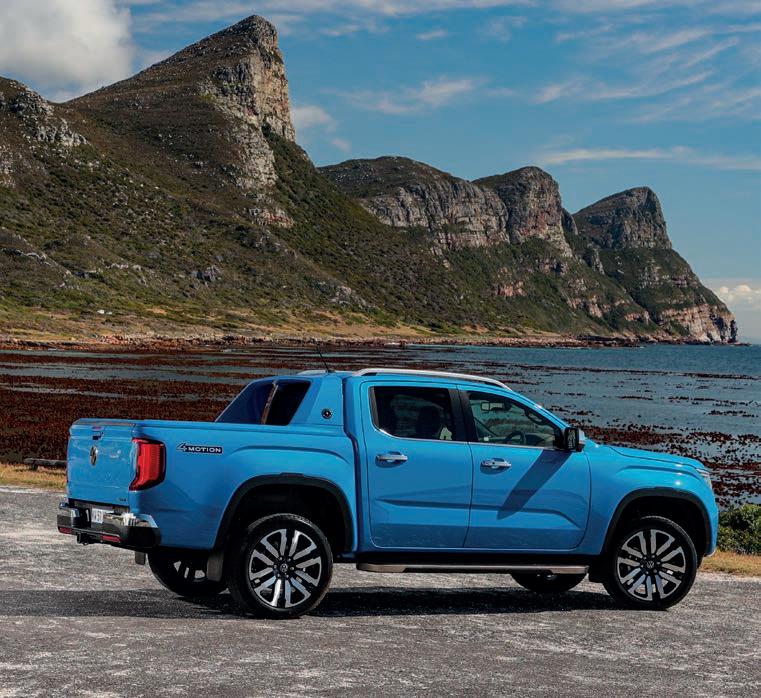
The cabin oozes comfort. The seats give you that hug you didn’t know you needed. A 12.3-inch digital instrument binnacle is situated in front of the driver, while the centrally sited 12.0-inch portrait-orientated touchscreen infotainment system incorporating screen mirroring is within easy reach. The dual-zone climate control system came in handy during the launch, as temperatures hit a scorching 36 degrees Celcius.

So, to business, then. On the road, the Amarok fared commendably. The suspension felt supple and the handling couldn’t be faulted. However, the Aventura’s 21-inch alloy wheels did relay some vibration to the steering wheel when travelling at speeds over 110 km/h. There was slight turbo lag when overtaking manoeuvres were required. But once you are on the move, there’s no stopping you. The same can be said when travelling o -road. So, to the party, then…
The four-wheel-drive system incorporates 4H and 4L settings. It was a boon when leaving behind the tarmac in the rearview mirror and piloting the Amarok o -road. The approach and departure angles are 30 and 26 degrees, respectively, and the wading depth is rated at 800 mm. The Amarok proved its worth on the 4x4 route. A
Price: TBC Engine: 3.0 L, V6, turbodiesel
Transmission: 10-spd AT Driven wheels: 4 Power: 184 kW @ 3 250 r/min Torque: 600 Nm @ 1 750-2 250 r/min 0-100 km/h: n/a Top speed: n/a
Fuel consumption: 8.4 L/100 km CO2: 222 g/km

AT A GLANCE
The new-generation Amarok builds on its predecessor’s premiumbakkie prerequisites. It’s a bakkie you can use for business and comes to the party in the wilderness. However, pricing and spec, which will be released in Q1 2023, will be paramount, especially considering the asking price for its Blue Oval-built brother, the Ranger Wildtrak V6, e ectively its direct competitor. Only time will tell.
LAUNCH PAD 57 ISSUE 7 APEX
Peak potential
Now positioned as a more premium o ering, will the new Everest summit its segment?
Few cars in the market legitimately have enough space for a family. Let’s not kid about it (pun intended). If you have more than one child, a five-seater with a measly boot will not cut it. And if you’re a family who enjoys a little bit of adventure, a run-of-the-mill SUV will also not quite be your vibe. You need a sevenseat adventure SUV, much like the Ford Everest. Before this new generation arrived, I would have suggested the Toyota Fortuner and Isuzu mu-X in the same breath. Although, things have changed at the Blue Oval’s o ces. According to the American marque, the new Everest has its sights set on the Toyota Land Cruiser Prado.
One has to acknowledge this is a pretty bold move. I am not sure how many current Everest drivers will be too happy that their family (and previously somewhat budget-friendly) adventure SUV now hangs around the million rand mark. That’s right; the new Ford Everest’s pricing kicks o at just under R1 million for the Sport derivative while the Platinum,
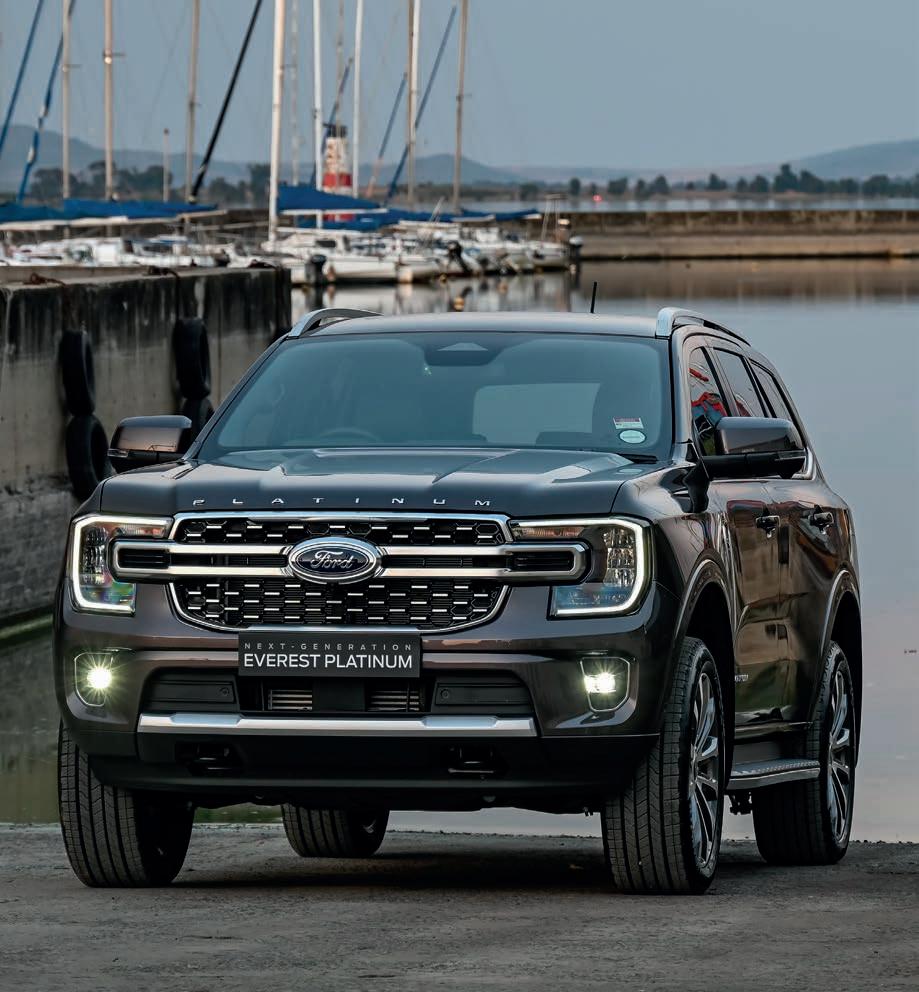 Ford Everest 3.0 V6 4WD Platinum AT
Words: Juliet McGuire Julietmc
Ford Everest 3.0 V6 4WD Platinum AT
Words: Juliet McGuire Julietmc
58 ISSUE 7 APEX LAUNCH PAD
which, let’s face it, is probably the one you’d want, comes in at R1 113 100.
To be fair, the Platinum comes quite well specced. You can expect a 12-inch portraitorientated touchscreen with the latest Ford SYNC4 system. As much as it is comprehensive, can feel somewhat overwhelming, and it will take some time to get the hang of. There is also a 12.4-inch digital instrument cluster; 10way electrically adjustable front seats with memory functionality; heating and ventilation; second-row seat heating; power outlets for all three rows; and a 360-degree camera, to name but a few features.
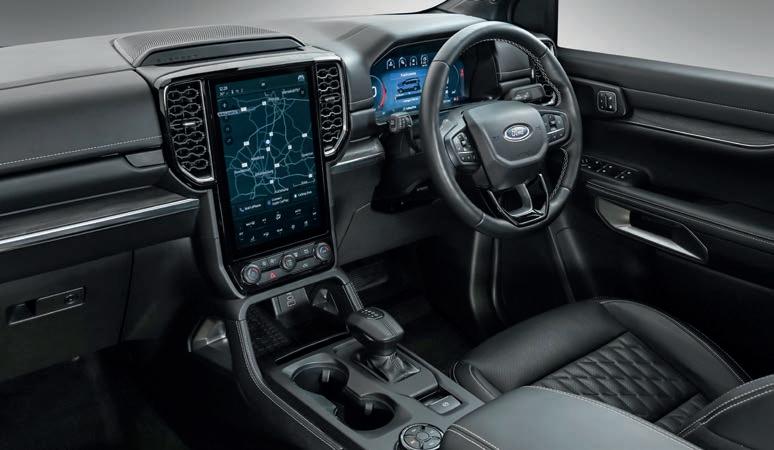
The Platinum also houses the biggest engine in the

Everest family. The new 3.0-litre V6 turbodiesel engine produces 184 kW and 600 Nm. The oil-burner is mated with a 10-speed automatic transmission. Power delivery is smooth and the overall refinement is impressive, as is the urgent punch it has when overtaking. It will have no problems fully loaded, either. However, it doesn’t feel blisteringly quicker than the 2.0-litre twin-turbo four-pot in the Sport. I would say that if you aren’t into the featureladen Platinum derivative, you might as well save a buck or two and opt for the Sport.
Where the Everest cannot be faulted is its o -road capabilities. A shift-on-thefly system enables you to switch between 2H, 4H and 4L with absolute ease. The
range-topping Platinum has a permanent four-wheeldrive system with automatic torque across the axles. Both variants boast a wading depth of 800 mm. We didn’t splash through any rivers on the launch, but we tackled some hair-raising obstacles, and the Everest ate them up for breakfast. It felt as if there was nothing it couldn’t do but I felt like that in the secondgeneration model as well. If you’re a caravanning family, you can tow up to 3 500 kg, which is 400 kg more than its predecessor . A
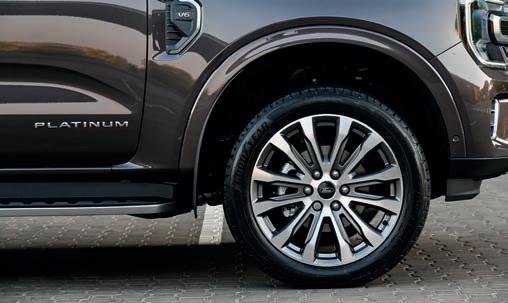
AT A GLANCE
4
184 kW
3 250 r/min
600 Nm
1 750-2 250 r/min 0-100 km/h: n/a Top
n/a
8.5 L/100 km
224 g/km
Price: R1 113 100 Engine: 3.0 L, V6, turbodiesel Transmission: 10-spd AT Driven wheels:
Power:
@
Torque:
@
speed:
Fuel consumption:
CO2:
LAUNCH PAD 59 ISSUE 7 APEX
There is no denying the new iteration is better in every way, shape and form than the outgoing model. However, I am not convinced positioning it in a premium segment is the best tactic. I wonder if it would have been a better move to rename this product.

60 ISSUE 7 APEX LAUNCH PAD
Toyota GR86 MT
Words: Vann van Staden winewheelswatches
Great 86
Staying true to its forebear’s fun-to-drive formula, the new GR86 encapsulates driving enjoyment.

61 ISSUE 7 APEX LAUNCH PAD
Ineed to start with a disclaimer: this was my first time in Gqeberha; as per the locals, the friendly city (apparently, they don’t like us out-of-towners to refer to it as the windy city). But windy it was. Before hopping into the whirlwind of thrills provided by the GR86, I was chasing down my cap on the tarmac. Yet the friendly city it now is. And I like that. Getting behind the wheel of the GR86 instantly makes you happy. I’m not the biggest fan of using the word ‘fun’. It's so predictable. But with the GR86, driving it on Aldo Scribante raceway, it’s the only word that
can encapsulate what I had there: a tonne of fun!

This is the second generation of the beloved 86, Toyota’s funto-drive sports car (not that the GR Supra isn’t). The di erence between the latest iteration of Toyota’s atmospheric two-door sports car and its forebear is significant, and in the best way.
The previously employed 2.0-litre has been ditched in favour of a 2.4-litre flat-four producing 27 kW and 45 Nm more. This allows the six-speed manual model to hit the 100 km/h marker from a standstill 1.2 seconds quicker than its forebear at 6.4 seconds.

The gearbox is slick, allowing for sharp gear changes. There


LAUNCH PAD
is, of course, also a derivative employing an automatic transmission. This variant has a 0-100 km/h sprint time four-tenths of a second slower than the manual. Sprint times aside, the manual is undoubtedly the model to go for. Why? Again, although I don’t use the word often, the three-pedal model is oodles of fun and – no surprise here – far more engaging to drive. The handling is sharp and the chassis taut. It’s a true purist’s sports car. A

Price: R698 100 Engine: 2.4 L, flat-4, petrol Transmission: 6-spd MT Driven wheels: R Power: 174 kW @ 7 000 r/min
Torque: 250 Nm @ 3 700 r/min 0-100 km/h: 6.4 seconds

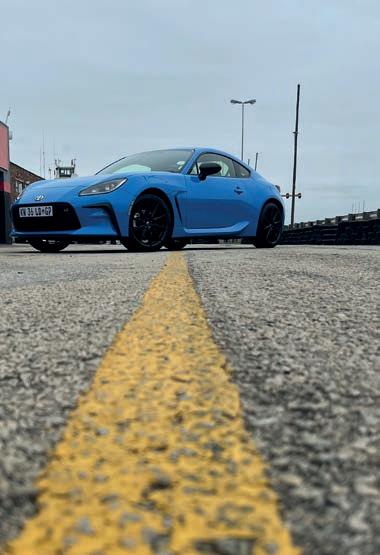
Top speed: 226 km/h Fuel consumption: 9.5 L/100 km CO2: 217 g/km
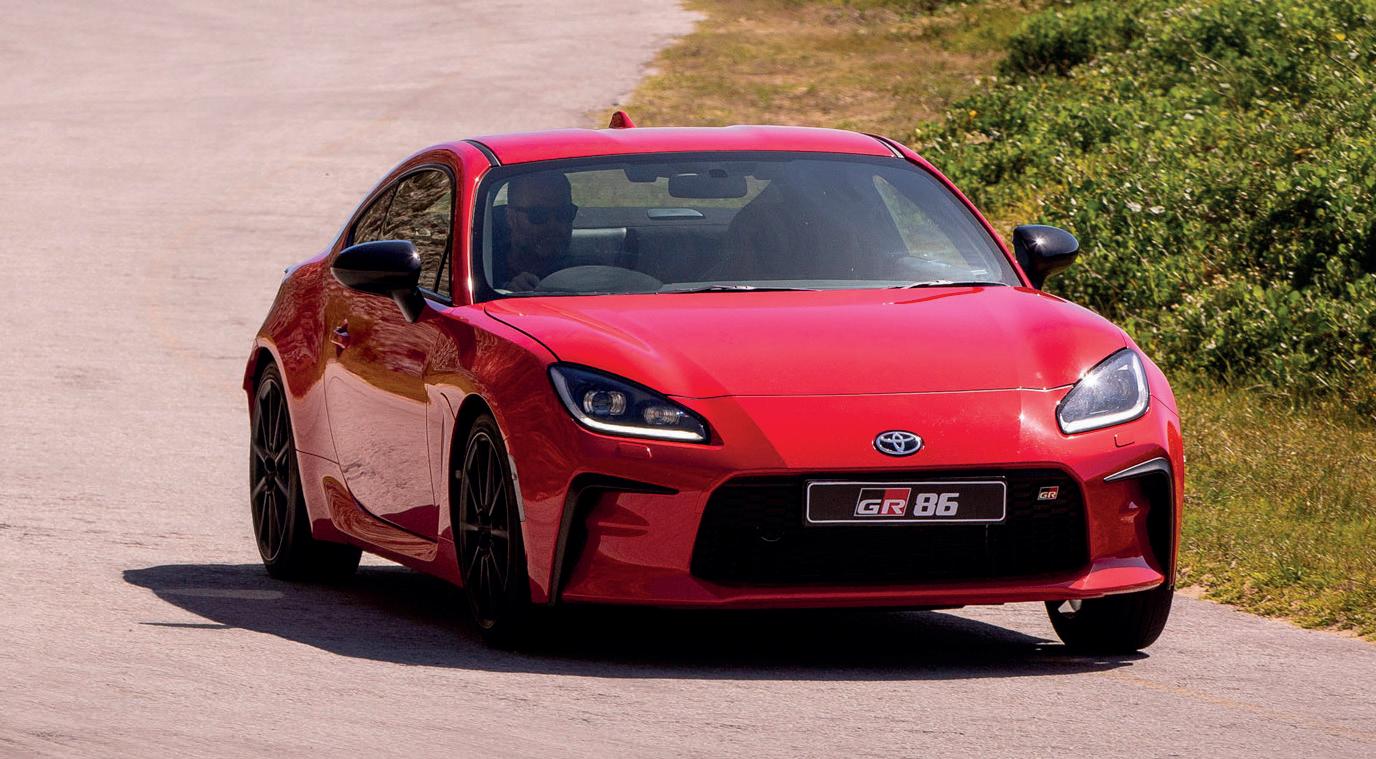
AT A GLANCE
Toyota describes the GR86 as an analogue car for the digital age. We couldn’t agree more. For the purists in us, the GR86 ticks all the boxes. Its e ortless transition from track to town complements its Waku Doki fun-to-drive formula. Unadulterated driving pleasure now has a name, and it’s GR86.
LAUNCH PAD 63 ISSUE 7 APEX
Nissan X-Trail
Tailored X-Trail
The new Nissan X-Trail arrives in SA early in 2023, and we’ve driven it in Slovenia.


Whereas the Qashqai can be held primarily responsible for kickstarting the boom in the crossover and SUV market, it’s the X-Trail that has taken Nissan’s success in this genre worldwide, and 2023 will see the arrival of the fifth generation in SA.
The X-Trail was introduced in 2001. Since then, the Japanese automaker has sold over 7.8 million, including three million units of the third generation, launched in 2014. It’s massively popular in countries like the United States – where it’s called the Rogue – and in China. Which is why the new one, built on the CMF-C platform from the Renault Nissan Alliance, is so very important.
 Words: Mark Smyth Motorscribe
Words: Mark Smyth Motorscribe
64 ISSUE 7 APEX LAUNCH PAD
We travelled to the beautiful country of Slovenia, a place full of incredible scenery, wonderful people and the promise of adventure, to sample the X-Trail.
Available as a five- and seven-seater, the latest X-Trail, of course, is larger than the Qashqai. It also boasts more technology. But back to the dimensions ... compared to the previous iteration, it measures 20 mm more in width and is 15 mm taller, but interestingly, it’s 10 mm shorter, even with the allowance for the third row of seats.

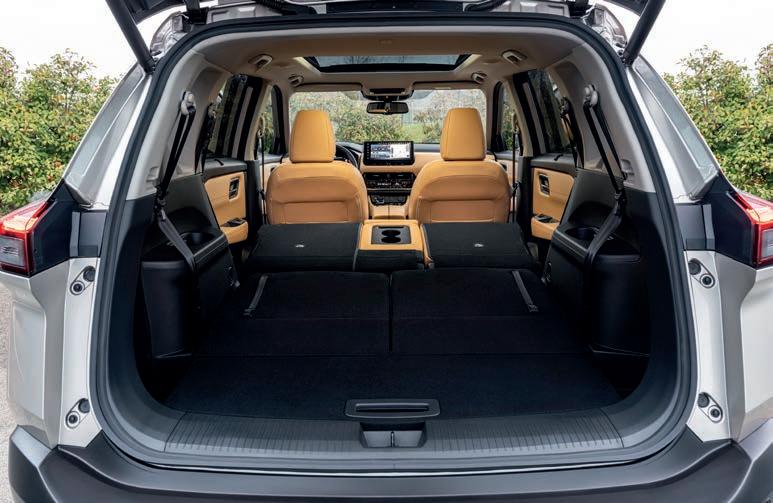
The X-Trail is part of Nissan’s plan to electrify its models, with 75 per cent of all its sales expected to be electrified by 2026, rising to 100 per cent after that. Within that will be pure battery-electric vehicles. No surprise then that the X-Trail gets Nissan’s new e-POWER technology and its e-4ORCE all-wheel-drive option, but it’s not an EV. Essentially e-POWER means a 1.5-litre petrol engine that acts as an electricity generator in the same way that BMW did with its range extender on the i3. Front-wheel-drive versions get 150 kW and 330 Nm, while the e-4ORCE models add a 195 Nm motor on the rear axle.
Before you get excited about experiencing all that e-POWER and e-4ORCE, they aren’t coming to SA, unfortunately. Instead, we will get a 1.5
turbopetrol, replete with 12 V mild-hybrid tech, pushing out 120 kW and 300 Nm. We’ll also get only front-wheel drive, but there will be a choice of five or seven-seat versions.
It will have all the fresh design, though, with the X-Trail now looking very di erent to the Qashqai as it did with the early generations. That’s true inside, too, with a more premium interior, a quality finish to the materials and tech that includes

12.3-inch screens for both the instrumentation and the infotainment system. It all feels way more upmarket than the last one and more spacious, too, although the third row of seats is still really for the kids or the friends you’ve o ered a lift home to after a night out and who are just grateful they aren’t walking. There’s loads of safety stu , from airbags to intelligent lane intervention and Nissan’s Pro Pilot driver
Why can’t SA have the nice one? Nissan told us that the e-POWER model would be too expensive compared to rivals like the Hyundai Santa Fe and Kia Sorento. But if you’re in the market for a spacious five- or seven-seater family SUV, you might want to get on this trail.
assistance systems.
It all feels family-friendly, which translates into its ride on the road. It was composed both on the tarmac and gravel. The ride was comfortable, the controls were all well placed, and the visibility was good. The tech is not overdone. There are still some physical controls, and the new X-Trail seems properly thought out by a team that understood the assignment. A
Price: TBC Engine: 1.5-litre, 3-cyl, turbopetrol + electric motor Transmission: CVT Power: 120 kW Torque: 300 Nm 0-100km/h: 9.6 seconds Top speed: 200 km/h
Fuel consumption: 7.1 L/100km CO2: 161 g/km
AT A GLANCE
65 ISSUE 7 APEX
Haval H6 1.5T HEV Ultra Luxury
H6 surge
The first-ever locally available Haval hybrid adds more sophistication and an electrical surge to the H6 line-up.
Since Haval’s introduction to South Africa, the Chinese company has piqued the interest of many. Now, for those seeking to add some electrical surge to their motoring: enter the H6 HEV, the firm’s first-ever hybrid vehicle available in SA. Once you enter the premiumfeeling cabin (a highlight of the package) and set o , you’ll be pleasantly surprised with the new-energy newcomer’s overall refinement. Why?

Allow us to explain…
Available in only Ultra Luxury level of specification, the H6 HEV is, like many
hybrids, features several model-specific exterior design cues, and is equipped with a 10.25-inch digital instrument cluster and a crisp 12.3-inch touchscreen infotainment system. This displays hybridspecific functions, such as how electricity is directed to the wheels and battery. A head-up display and a surround-view 3D camera system are included.
Speaking of the transfer of electricity between the front wheels and the battery, the electric motor is coupled with a 1.5-litre turbopetrol four-pot, which produces 113 kW and 233 Nm.
Interestingly, the electric motor has more power (139 kW) and torque (300 Nm) than the internal combustion unit. In total, 179 kW and 530 Nm are on o er. These figures make the H6 HEV the most powerful Haval available in SA. The powertrain is coupled with a state-of-the-art Direct Hybrid Transmission. Our biggest gripe in the past with Haval models is their fuel consumption. However, owing to the petrol-electric arrangement, the HEV, the most fuel-e cient model in the firm’s local line-up, sips a claimed 5.2 L/100 km/h, a figure we nearly matched. This
enables you to travel more than 1 100 km on a single (60-litre) fuel tank. Thanks to this H6’s subtly sprung suspension, the journey should be comfortable. However, it does have a few drawbacks – one in particular – so let’s return to the cabin. With only a couple of analogue controls, you have to operate most functions via the infotainment system. And navigating this system when on the move isn’t as user-friendly. Owners will arguably become accustomed to the set-up. However, it is probably best to navigate the system while you are stationary, before setting o .
AT A GLANCE
A
Price
1.5 L, 4-cyl, turbopetrol + electric motor Transmission: E Driven wheels: F Power: 179 kW Torque: 530 Nm 0-100 km/h: 8.5 seconds Top speed: n/a Fuel consumption: 5.2 L/100 km CO2: 121 g/km
: R669 950 Engine:
Words: Marius Boonzaier mariusboonzaier
66 ISSUE 7 APEX LAUNCH PAD
Before the launch of the HEV variant, in issue 06, we recommended several petrol-electric cars. The H6 HEV is worthy of making this list. So, if you’ve decided to bridge the world of electrification, Haval’s hybrid H6 is undoubtedly worth a look.
Hyundai Venue 1.0 T-GDi DCT
Words: Marius Boonzaier mariusboonzaier
Fresher than ever
The updated Venue line-up boasts bolder looks, several spec enhancements and a new N Line model.
Many manufacturers, especially tech companies, strive to keep abreast with the latest trends. Take Apple, for example: how many times has it happened that you just got your hands on a box-fresh iPhone (following an extensive wait) and, a couple of months later, a new one is launched? In the world of crossovers, automakers have to do the same, fortunately not always at such a staggering lack of pace. To remain relevant in this booming segment, carmakers frequently introduce new or additional models to their line-ups or hand the current variants some muchneeded updates. Speaking of the latter … enter the fresh-faced Hyundai Venue.
Arriving at the same, ahem, venue where the pre-facelifted model was launched, the underground parking garage was packed with the revised model range, all dressed in di erent shades. We hopped into a Fiery Red example and set o to Glen Carlou winery in Klapmuts, Cape Town. The bright hue complemented the redesigned bodywork, which now features a bolder front grille.
The model we sampled was equipped with the South Korean firm’s 1.0-litre turbocharged three-pot, coupled with a seven-speed dual-clutch transmission (the turbo-triple can also be had with a

six-speed manual ‘box). Producing 88 kW and 172 Nm of torque, the latter available from a mere 1 500 r/min, the engine felt spirited, though the DCT sometimes held onto a lower gear for a longer time than required when stomping on the throttle for quick overtaking. Other than that, the compact crossover’s drive was comfortable on the well-maintained tarmac.
Although with a ground clearance of 195 mm, the same didn’t apply when travelling on a stretch of corrugated gravel. It was bumpy but the small front-
wheel-drive SUV should fare fine on wellkempt gravel roads. In the city is where it is at its best ... at home.
As standard, the revised model line-up (the former range-topper, the Glide, has been ditched for the sportier-looking N Line, pictured here) comes with an 8.0inch touch-enabled infotainment screen with all the favourite features, such as screen mirroring. LED lamps, a rear-view camera and parking sensors are included in some variants, while artificial leather upholstery and a sunroof are exclusive to the N Line. A
AT A GLANCE
Price: R394 900-R449 900 Engine: 1.0 L, 3-cyl, turbopetrol Transmission: 7-spd dual-clutch Driven wheels: F Power: 88 kW @ 6 000 r/min Torque: 172 Nm @ 1 500-4 000 r/min 0-100 km/h: n/a Top speed: 187 km/h Fuel consumption: 6.9 L/100 km CO2: 138 g/km
LAUNCH PAD 67 ISSUE 7 APEX
Thanks to several updates and together with Hyundai SA’s seven-year/200 000 km warranty, the new Venue should continue to be a best-seller for the brand, despite facing some sti competition.
HUAWEI WATCH FIT 2
Available in two editions, Active and Classic, and with a durable battery life of 14 days (or seven days for heavy use), the Huawei Watch Fit 2 is perfect for active people who tend to forget to charge their devices. It comes with a 1.74-inch Huawei FullView Display and a suite of healthy living management tools, including a nine-axis IMU, optical heart rate sensors, an audio companion for fitness, and 50 m water resistance.

UTILITY WRIST CANDY



From tracking fitness goals and staying in touch with contacts to using AI to prove yourself right in trivia disputes with mates; like futuristic tech from a seventies science fiction movie, you can do it all with the simple tap of a smartwatch. Here’s what you need to know about today’s best brands and models.
























Words: Thea Beckman


















SAMSUNG GALAXY WATCH 5



Sleep tracking, health and wellness monitoring, 13 per cent better battery for everyday usage and, get this, even the ability to see your body fat percentage; the Samsung Galaxy Watch 5 touts itself as “the smartwatch for everyday wellness goals”, allowing you to literally keep a finger on the pulse of your health and fitness goals. How did you sleep last night? Get a breakdown of your sleep score.

TAG HEUER CONNECTED CALIBRE E4 PORSCHE EDITION


If it’s the functionality of a fitness watch you’re after, but with the sophisticated, classic style of a high-end wristwatch, this special-edition watch is the spoil of the century for you, especially if you’re also a diehard Porsche fan. The love child of these two iconic houses, this fitness watch epitomizes the luxury of the TAG Heuer Connected experience but with advanced controls for Porsche owners. You can’t argue with that colour, either, coming in the same iconic frozen blue as the electric Porsche Taycan.

APPLE WATCH ULTRA



































If you, like everyone else with an Apple Watch, are tired of guarding your wrist more viciously than a mother bear, lest you accidentally crack its delicate face, the Apple Watch Ultra delivers that sexy upgrade on durability, ruggedness and battery life we’ve all been waiting for. With a robust titanium case, precision dual-frequency GPS, and up to 36 hours of battery life, this is the fitness watch of choice for Apple-orthodox athletes who like to hike Mount Everest on weekends.

GARMIN INSTINCT® CROSSOVER SOLAR






























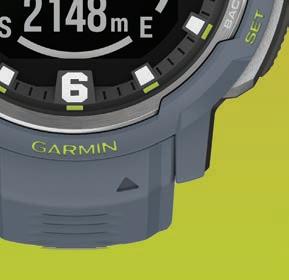





Bold and rugged, with infinite battery life, the Garmin Instinct® Crossover Solar is like that oke on the cover of romance novels with the bulging muscles and the indefatigable appeal. Except this rugged hybrid does the opposite of making us feel inferior. It boasts a dual-layered bezel, a high-resolution digital display with smart functionality, and all the fitness features you want, with the added benefit of being water resistant to 100 m and thermal- and shock-resistant.

LIFESTYLE
ANOTHER ONE BITES THE DUST








Second consecutive Dakar victory for Toyota Gazoo Racing.
Qatar’s Nasser Al-Attiyah and his French co-driver, Mathieu Baumel, successfully defended the Dakar title they won for TOYOTA GAZOO Racing (TGR) in 2022, when they brought their GR DKR Hilux T1+ over the finish line of the final stage of Dakar 2023 on 15 January. The pair lost 5min 41sec to the stage winners, but that hardly mattered, as they sealed the overall victory with a winning margin of 1hr 20min 49sec.

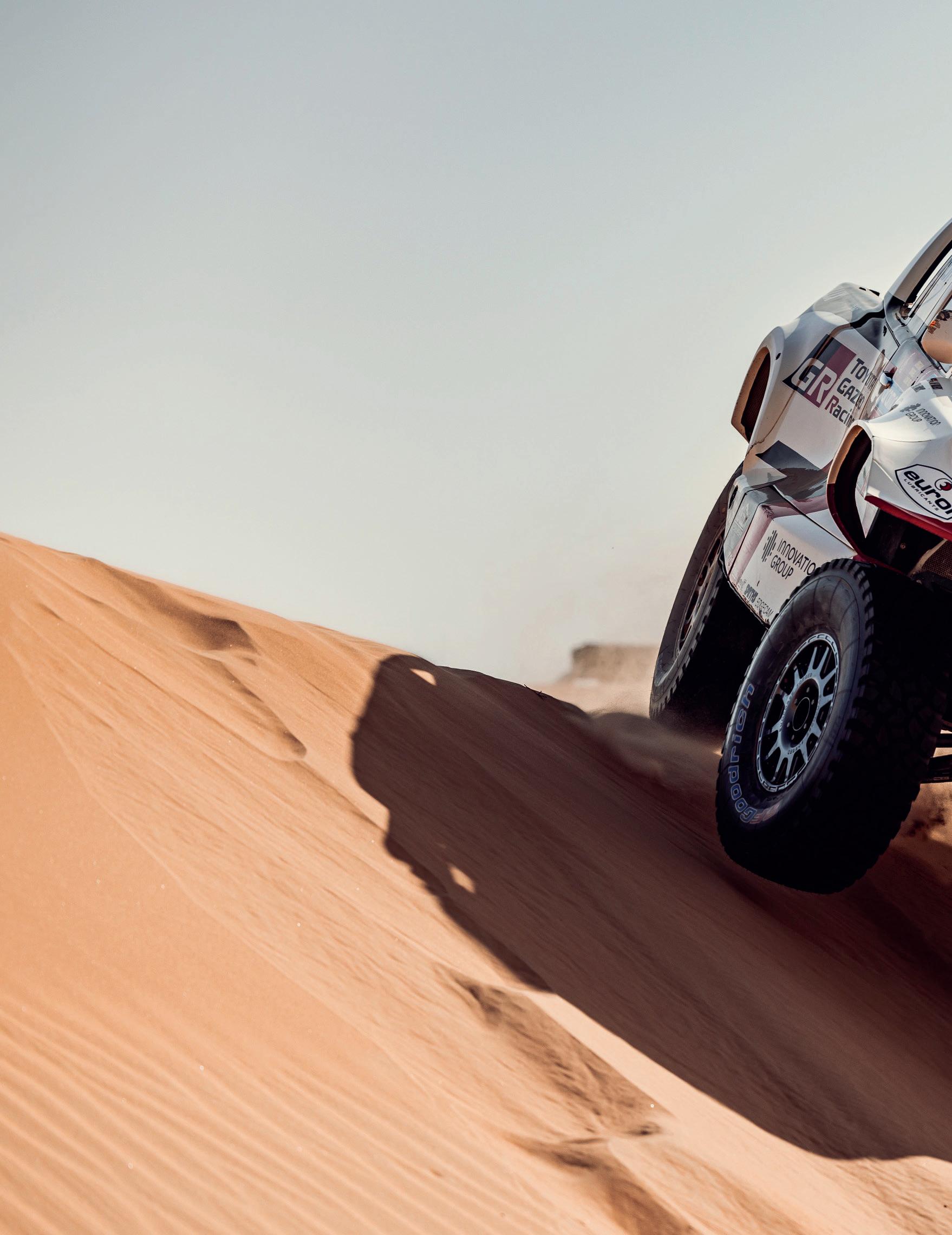
The final stage of Dakar 2023 was a 136km-long test that started from the bivouac at Al-Hofuf. Competitors had to complete a short liaison of 167km before taking on Stage 14, which was then followed by a final liaison of 100km to the finish podium in the coastal city of Dammam.

For Nasser, this was his fifth win in the Dakar Rally, while Mathieu’s tally is now four victories. The pair have won three times for Toyota, with the latest victories coming in a back-to-back display of quality, durability and reliability for the Japanese manufacturer. The pair took over the lead of the event on Stage 2, and never relinquished that position.
Nasser Al-Attiyah: “This in amazing feeling! I have to thank so many people, starting with every member of our team. It was a tough two weeks, but to be able to come back and defend our title is fantastic! I’m really proud of our Toyota Hilux T1+, and to win the race three times with Toyota is truly something special.”





Giniel de Villiers, who completed his twentieth consecutive Dakar Rally when he crossed the finish line near Dammam, ended the rally in 4th place in the overall standings. This result brings his total number of Top 5 finishes to 15, including one victory in 2009. The South African has only finished outside the Top 10 on one occasion, and his performance in the 2023 Dakar Rally underscores the toughness and tenacity of one of the Dakar Rally’s true veteran racers. Together with co-driver Dennis Murphy, Giniel finished this year’s 45th edition of the rally in fine style, posting a Top 10 time on the closing stage.


Giniel de Villiers: “The Dakar is always full of challenges, and we certainly had our share of challenges this year. Of course, it could’ve been better for us, but then many competitors can probably say the same. It would have been nice to be on the podium, but overall, as a manufacturer, Toyota has every reason to be proud. I think this result has just proven the reliability of the Hilux once again, and we again managed to showcase this amazing car in Saudi Arabia this year.”

Dakar 2023 will long be remembered by Henk Lategan and co-driver Brett Cummings as a race that could have turned out very di erently for them. They moved as high as 2nd place in the overall standings, before two setbacks pushed them down the order. The pair showed great pace throughout the rally, and will be hoping for a truer reflection of their speed in future editions. Even so, they finished in 5th place overall, less than 5min behind their teammates in fourth.
Henk Lategan: “Dakar 2023 has been a rollercoaster for us. It has been a tough two weeks for us, with some extremely good days; but also some disappointing ones. It does feel good to be in the Top 5 after such a tough Dakar, and I think they’ve thrown everything at us this year. With that in mind, it feels fantastic to be at the end of the race, and while we’ll always wonder what might have been, we are very happy to bring the car home in a good position.”


Toyota dominated the Dakar 2023 results, with the works TGR crews finishing 1st, 4th and 5th. A privately entered Toyota Hilux T1+ in the hands of the young Brazilian, Lucas Moraes, added to the Japanese manufacturer’s tally, by finishing in third place overall. This was Lucas’ first attempt at the Dakar Rally, though he had an experienced co-driver in the form of Timo Gottschalk beside him in the car.



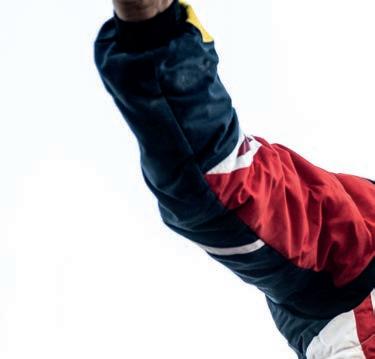
PROMOTION
Glyn Hall, TGR Dakar Team Principal: “What a day for our entire team!




Winning Dakar is something memorable, but winning the world’s toughest race twice in a row is simply extraordinary. My sincere thanks to every member of our team, every one of our sponsors and, of course, our drivers and co-drivers, who delivered a stunning result. I’m really proud of our GR DKR Hilux T1+, which has proven yet again that it is reliable and durable enough to not only complete the world’s roughest automotive race, but to do so two years in a row.”
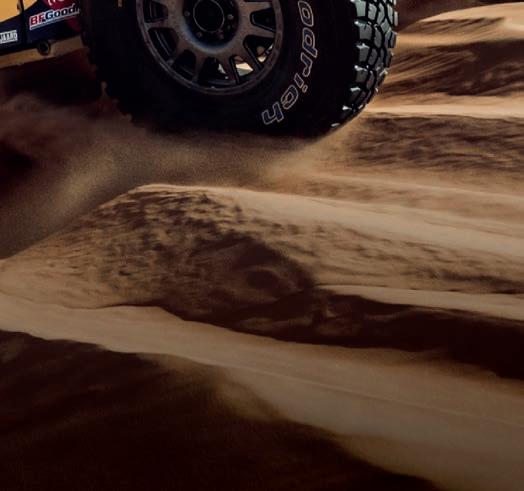

PROMOTION
Are you not infotained?
As several automakers and software companies enter the in-car tech arena, a war is brewing for your vehicle’s infotainment system.
For the longest time, the most intriguing and, dare I say, complicated part of your car’s dashboard was trying to figure out where to hang your furry dice. That was the dilemma for my dad, at least, in his legendary Dark Red Mica metallic Toyota Cressida. Things have changed since then, however. These days, larger screens have infiltrated vehicles’ cabins, paving the way for a new era of interior tech.
I really started paying attention to in-car software with the uptake of Apple CarPlay/Android Auto. Back then, even now, the ability to plug in your smartphone and have a similar interface projected on the car’s infotainment system became a musthave. The truth, though, is that Apple and Google would never be content solely with projection. For starters, it’s a barebone execution as the smartphone doesn’t connect any deeper with the vehicle and no rich data is processed between the two. Think of it as plugging a second screen into your computer.
The idea of running your software on the car seems far juicier, and that’s


KD

 Papi Mabele
Papi Mabele

Papi is a broadcaster and writer. He has been hooked on the science behind tech and motoring ever since he tried his hand at Lego sets when he was five. He can sometimes be coaxed to express opinions, invariably his own.
the situation we find ourselves in. Fortunately for Android, they are no strangers to this. Enter Android Automotive. Unlike Android Auto, Android Automotive is the native system. Here, Google can take its fill of the car’s core data. It knows the status of the battery, whether the lights are switched on, and the speed. It can control almost everything from navigation and climate to driver assistance and safety systems.
While all these innovations may seem forward-thinking, consumers want more phone-like experiences. Yet there is a complexity in building systems that run like smartphones. They need to be open to third-party apps and services, which automakers are grudgingly starting to recognise.
In the end, what remains to be seen is whether all these systems will play together in the long run. While Volvo has pioneered Google’s solution, several others have climbed aboard. It’s only a matter of how long before more manufacturers embrace this. For the most part, the ‘smartphonicifaction’ of the infotainment system is still in its infancy stages. A
74 ISSUE 7 APEX COLUMN
Words: Papi Mabele PapiMabele


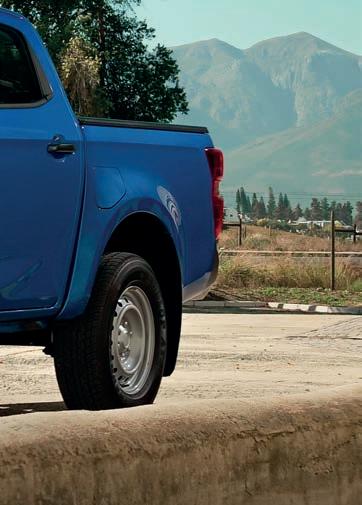















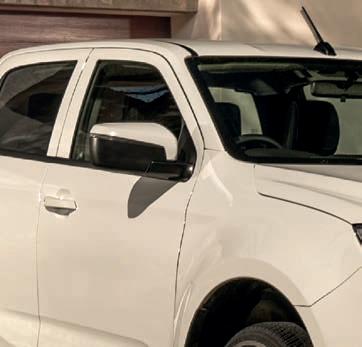
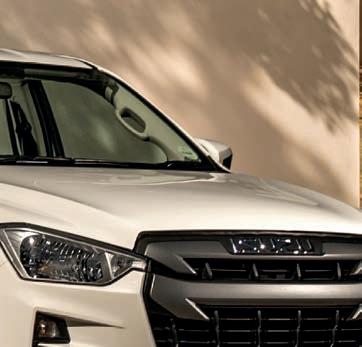








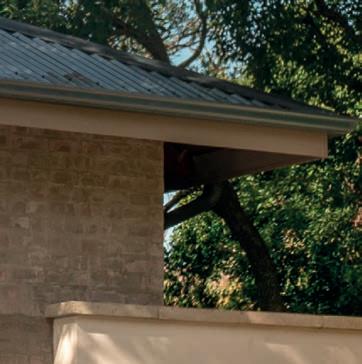










COLUMN
Why not buy an old-school BMW?
With automakers set on an electrified future, contributor Justin Jacobs argues now might be the time to buy a petrol car that makes you feel special. In his case, it was a BMW.
Words: Justin Jacobs Thejustbin
Forget about crypto; I think you should buy an old BMW instead. As is the case with many car manufacturers, BMW is spending all of its time, energy and resources on electric vehicles. While that’s fun and all, it tends to increase the value of the older, petrol-powered models.
Think about something you have, maybe something you want. Now imagine if there were a limited number of those things. The value should increase, right? It boils down to supply and demand. The big question, however, is what is being supplied ... in this case, a BMW.



Some BMWs have been known to be true driver’s cars. Mercedes supplied the luxury, Audi provided the safety, and the Bavarian firm delivered the thrills. Nowadays, the lines are so blurred as all of the German Big Three companies have vehicles that fall into these categories. But for me, BMW o ered some pretty good cars back in the day, but not all were desirable.
While I love a good E46 320d, I doubt you will see any returns on that anytime soon, or ever, to be honest. Instead, you must naturally look at the M cars. Have you seen the prices of E36 M3s lately? If you can find one for sale, some examples of the twenty-six-year-old compact
A motoring content creator and writer for over a decade, Justin believes a car has a personality and needs to be discovered, learnt and understood.

sports sedan carry a price tag equal to a modern hot hatch.

The E46 M3 is enjoying a growing interest and, as we learnt earlier, the more people who want one, the higher the price. These cars could be found all
over online listing sites for peanuts just a few years ago. Today, even the questionable ones are sold for significant amounts.


I’m not going to sit here and tell you to go out and buy an old BMW without following the same advice. In 2016, I bought a rough, unloved E39 M5, the best M5 and one of the best M cars, according to many experts. After a bit of hard work and a decent yet not exorbitant amount of money to freshen it up, I now have a car worth five times more than what I paid six years ago.
I also think the automotive industry’s new direction is making cars like the older (internal combustion) BMW M, Mercedes-AMG and Audi RS models more desirable.
Here’s the thing ... you don’t need to go out and buy an old BMW M car, slowly fix it up and wait until it doubles or even triples in value. You could just as well get something that is enjoyable to drive, something that makes you feel special (here’s talking to you Mazda MX-5 drivers). There will be even fewer petrol-powered cars on showroom floors in a few years. Why not preserve a bit of automotive history. You never know, your decision might be pretty profitable one day. A
COLUMN 77 ISSUE 7 APEX JJ
Justin Jacobs
PRESS RESS
A letter that has been revered since it first adorned a VW, we press ‘R’ on the apex Golf and Tiguan’s steering wheels and enjoy the ride.
Words: Marius Boonzaier mariusboonzaier

78 ISSUE 7 APEX
SINCE IT FIRST adorned a Volkswagen, the iconic ‘R’ badge has been revered; for 20 years, to be precise. Indicating the German marque’s pinnacle performance cars, Wolfsburg’s R-badged models have achieved cult status worldwide and locally, the Golf especially. And it’s no wonder why; the opening gambit to VW’s R portfolio was the now-cult-classic Golf R32. However, since 2002, this moniker has adorned not only the firm’s apex hot hatchbacks. VW has also handed the R treatment to the Passat (R36), Touareg (R50), the Estate and Cabriolet versions of the Golf R, Scirocco and, more recently, the T-Roc, Arteon and Tiguan. And alongside its new-generation R-badged hot-hatch sibling, the latter model finally arrived in South Africa, a country enthused over the letter R. So, with these models at our disposal, what else is there to do but press the blue R button on these steering wheels and relish what’s arguably the last internal combustion R models?














FEATURE
THE EA888 UNIT IN THE MK8 R PRODUCES 235 KW/400 NM, MAKING IT THE MOST POWERFUL PRODUCTION GOLF EVER.


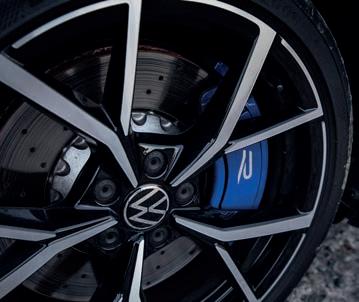


Golf
80 ISSUE 7 APEX
R
Before I started the Golf R, colleague Vann blasted o around the mountain pass in the Tiguan R and I took a moment to acquaint myself with the latest iteration. The first Golf I drove was a seventh-generation R. I couldn’t help but wonder whether this would be the last time I sampled a traditionally powered Golf R. It’s a car that’s been renowned in the automotive world since the first model introduced a dual-clutch gearbox to production cars and sported the illustrious VR6 engine. There was no time to reminisce. Rain clouds blanketed Cape Town’s blue sky. It was time to drive.
The engine-start button ignited the 2.0-litre turbocharged four-pot, the same powertrain found in its forebear. It felt familiar. However, the EA888 unit in the Mk8 R produces 235 kW/400 Nm, making it the most powerful production Golf ever. I pressed the blue R button on the steering wheel. With Race mode activated, the standard-fitment, chrome-tipped exhaust sound was enhanced. Yet something was missing. And that something was the (optional) Akrapovic system equipped with the Mk7. Like its predecessor, this set-up is also available on the new model and is undoubtedly a must-have item.


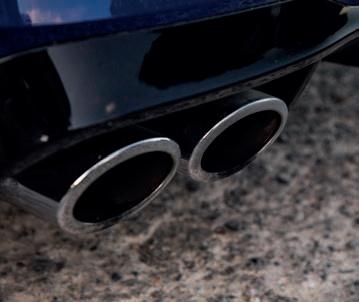

We set o in search of Vann. With each passing corner, the Golf R egged me on to drive faster. The grip levels were astounding, thanks to the all-new all-wheel-drive system, also found on the Tiguan R. The 4Motion set-up features R-Performance torque vectoring, capable of shifting power between the fore and aft axles and between the left and right rear wheels. Specifying the Black Performance package adds a drift mode to the Golf R and lifts its electronically governed top speed of 250 km/h to 270 km/h.

FEATURE 81 ISSUE 7 APEX
In a straight line, the Golf R completes the obligatory 0–100 km/h sprint in 4.8 seconds. But, like its tall-riding stablemate (0–100 km/h in 5.1 seconds), it felt quicker than the claimed figure. This is thanks to the torque distribution and the slick-shifting seven-speed DSG. The dual-clutch ’box’s shifts are rapid. As we entered the corner, I planted my right foot firmly on the brake pedal and the brakes bit hard. The handling is pin-sharp. And then, it started to rain. However, that didn’t halt its stride. It only revealed just how capable it is in dry and wet conditions. The same can be said of the Tiguan.



Tiguan R

We finally caught up with Vann and it was my turn in the Tiguan R, which we now call, “the Tiguan made fun”. And it was. Although I preferred the low-slung seating position and cabin layout (bar the capacitive controls) of the Golf, it felt good to sit in VW’s sports SUV. It felt taut for a car of this ilk (the R-badged Tiguan rides 10 mm lower to the ground than its standard stablemates).
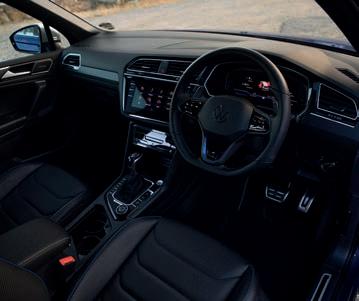


Revered for generations, the Golf R continues to make its mark on the motoring world. It forms a neat balance between a daily driver and a mountain-road carver. Regarding the former, the Tiguan R is even more so, considering its practicality, without sacrificing dynamism.


Which one would I take home? Undoubtedly the Golf R. I will admit the Tiguan R makes a good case for a four-person family. No matter which model you choose, and whether this will be the last of the EA888 (or any internal combustion R, truth be told), it’s best to hit the R button and enjoy the ride. A

FEATURE 83 ISSUE 7 APEX
THE TIGUAN R MAKES A GOOD CASE FOR A FOURPERSON FAMILY
POTS, PANS & POTJIES
Popular thanks to television’s Ultimate Braai Master, brothers-in-law Greg Gilowey and Karl Tessendorf have released their second cookbook, Beer Country’s Pots, Pans and Potjies. The duo’s lust for cooking, potjie and beer stand out among the pages of tasty recipes and beer pairings.


Next Day Potjie Nachos
Potjie is always tastier the next day, so why not throw that goodness over some crunchy corn chips? It sounds crazy, but trust us, it’s so worth it.
INGREDIENTS
1 tub (250 ml) sour cream
Small handful of chopped fresh chives
Zest and juice of 1 lemon
Sea salt and freshly ground black pepper
1 big bag of proper corn chips
Any leftover potjie, warmed up 200 g gouda cheese, grated
200 g mozzarella cheese, grated

3–4 pickled jalapeño chillies, sliced
Mix the sour cream, chives, lemon zest and juice in a small bowl and season to taste.
In today’s insta-everything world, cast iron reminds us of a simpler time. A time when things were built to last, not break within a year. A well-seasoned pan is a cooking Swiss Army knife. A solid flat pot is the ultimate campfire jack-of-all-trades, and the humble potjie pot is more than just a pot. It’s our version of low and slow, with some important lessons to teach. It forces you to relax, enjoy the ride, and realise the best things are worth waiting for. It’s a delicious goal for friends and family to come together and work towards over the course of the day: prepping the ingredients, starting the fire, building the flavour layers and watching the potjie’s bulging belly whisper away.
Bang your corn chips into a large cast-iron pan and spread the warmed leftover potjie evenly over the chips. Mix the two cheeses and sprinkle them over the potjie. Top with pickled jalapeños for kick, then season with salt and pepper and pop the pan under the grill until the cheese has melted. Serve with dollops of the sour-cream mixture .
Beer Pairing
Lager If you wanna get fancy with the pairing here, it’s all about what was in the potjie. That said, chances are it’s full of fat, flavour and next-day deliciousness; so, reach for a well-balanced beer with good carbonation and a clean finish.
84 ISSUE 7 APEX LIFESTYLE
Here are a few recipes to enjoy from Beer Country’s Pots, Pans and Potjies by Greg Gilowey & Karl Tessendorf.
Feeds: 4–6
Prep: 10 min Cook: 10–15 min


Feeds: 6 Prep: 20 min Cook: 30 min + standing time
Hot Sticks Potjie Party
It’s a hot sticks party and you’re invited. Buckle up and bring some beer to cool those taste buds because after a drumstick or three you’re going to need it.
THE MARINADE
1 cup Gochujang paste
½ cup lager
¼ cup brown sugar
¼ cup rice vinegar
¼ cup honey
2 Tbsp soy sauce
2 Tbsp sesame oil
A knob of fresh ginger, finely chopped
3 cloves garlic, finely chopped
Zest and juice of 3 limes
THE CHICKEN
20 free-range drumsticks
Marinade for brushing
The potjie
Oil for frying
Knob of butter
1 large onion, peeled and chopped
Remaining marinade
1 cup lager
Braaied chicken
TO SERVE
A handful of sesame seeds, toasted
2 spring onions (green part only), chopped
3 limes, quartered
Beer Pairing
To make the marinade, put all the ingredients into a small pot and whisk over medium heat to melt and combine.
To make the chicken, score the drumsticks with a sharp knife and brush them with marinade. Don’t go crazy, just brush to coat evenly. Braai the drumsticks in a flip grid over hot coals to char and caramelise the marinade, then set aside. The drumsticks will not be cooked, but they will finish cooking in the potjie.
To make the potjie, preheat a number 3 potjie over medium-heat coals. Add a splash of oil and the butter and fry the onion until it softens and browns. Add the marinade and beer and mix to combine. Add the drumsticks to the potjie, put on the lid and simmer for 30 minutes. Check the pot every now and then to make sure the sauce isn’t catching. Take the pot o the heat and allow it to stand with the lid o for 10 minutes. Sprinkle the sesame seeds and spring onions into the potjie and let your guests get stuck in. Serve with the quartered limes.
New England IPA It’s all about balance with the fruity hop hit to the head in the pairing. It is best mates with the sweetness in the dark and sticky sauce, and medium to low bitterness means it just gets better and better with every swig.

LIFESTYLE 87 ISSUE 7 APEX
Stacked Mustard and Cheese Potato Bake
This is everything you know and love in a good ol’ potato bake, but stacked instead of layered. Not only does stacking look fancy, but it gives all the exposed edges a chance to get crispy and lekker.
THE POTATOES

2 kg large potatoes, sliced into 2 mm rounds
Olive oil for drizzling
Sea salt and freshly ground black pepper
THE MUSTARD CREAM
1 cup fresh cream
1 tbsp prepared hot English mustard
1 tbsp Dijon mustard

5 sprigs of fresh thyme, picked and chopped
Small handful of fresh flat-leaf parsley, chopped
THE TOPPINGS
Large handful of grated mature cheddar cheese
Small handful of fresh chives, chopped
To make the potatoes, drizzle the slices with olive oil and season well with salt and pepper. Stack the slices vertically into a large flat pot in whichever pattern you choose, as long as they are stacked up against each other.
To make the mustard cream, pour the cream into a small pot over a medium heat. Add the mustards, thyme and parsley and whisk well to combine. Bring the cream to a boil while whisking, then remove it from the heat.
Pour the hot mustard cream over the potatoes. Pop on the lid and use a spade to create a clear circular space in the coals for the pot. Place the pot into the space, then surround it with medium-low-heat coals, ensuring no coals touch the pot (see Baking on the Braai p. 48).
Bake with the lid on for 45 minutes, then place a few coals on the lid to brown the top for another 10–15 minutes. Or, bake uncovered in the oven at 180 °C for 45 minutes. Add the cheese and grill with the lid o for another 10 minutes to brown, but keep an eye on it.
Top with chopped chives and season with salt and pepper.
Beer Pairing
Stout This comfort food dish is the perfect vehicle to showcase stout’s roasty, toasty flavours. The bitter malt bill is best mates with the rich mustard cream and amps up the umami hits from the cheese.
88 ISSUE 7 APEX LIFESTYLE
Feeds: 8 Prep: 10 min Cook: 1 hour

If you’re looking for something that’s dressed up, casual or weekend-friendly, step out in style with a Stone Harbour look.





90 ISSUE 7 APEX WE REWARD YOU FOR SHOPPING! IT’S EASY TO JOIN. SIGN UP AT THE TILL. NO CARD? NO WORRIES. USE YOUR CELL NUMBER, ID OR EMAIL ADDRESS. AVAILABLE ONLINE & IN-STORE. WHILE STOCKS LAST.
1. PRINTED TEES R129.99 2. CARGO SHORTS. R399.99 3. CAP. R99.95 4. OXFORD WHITE SHIRT. R299.95 5. SHORT SLEEVE WOVEN SHIRT R349.99 6. CHINO PANTS R399.95




Subscribe now Email subs@apexmag.co.za *This o er is valid only for subscribers with a South African address. SUBSCRIBE TO Subscribe to South Africa’s hottest new car and lifestyle magazine. Read the latest updates, get the scoop with our deep drives and launch reports, and benefit from expert advice on classic cars. Plus plenty more! MAGAZINE Save 25% ON 3 OR MORE ISSUES 3 issues @ 25% discount = R133 APEX
DEEP DRIVE


92 ISSUE 7 APEX
ASTON MARTIN DBX707
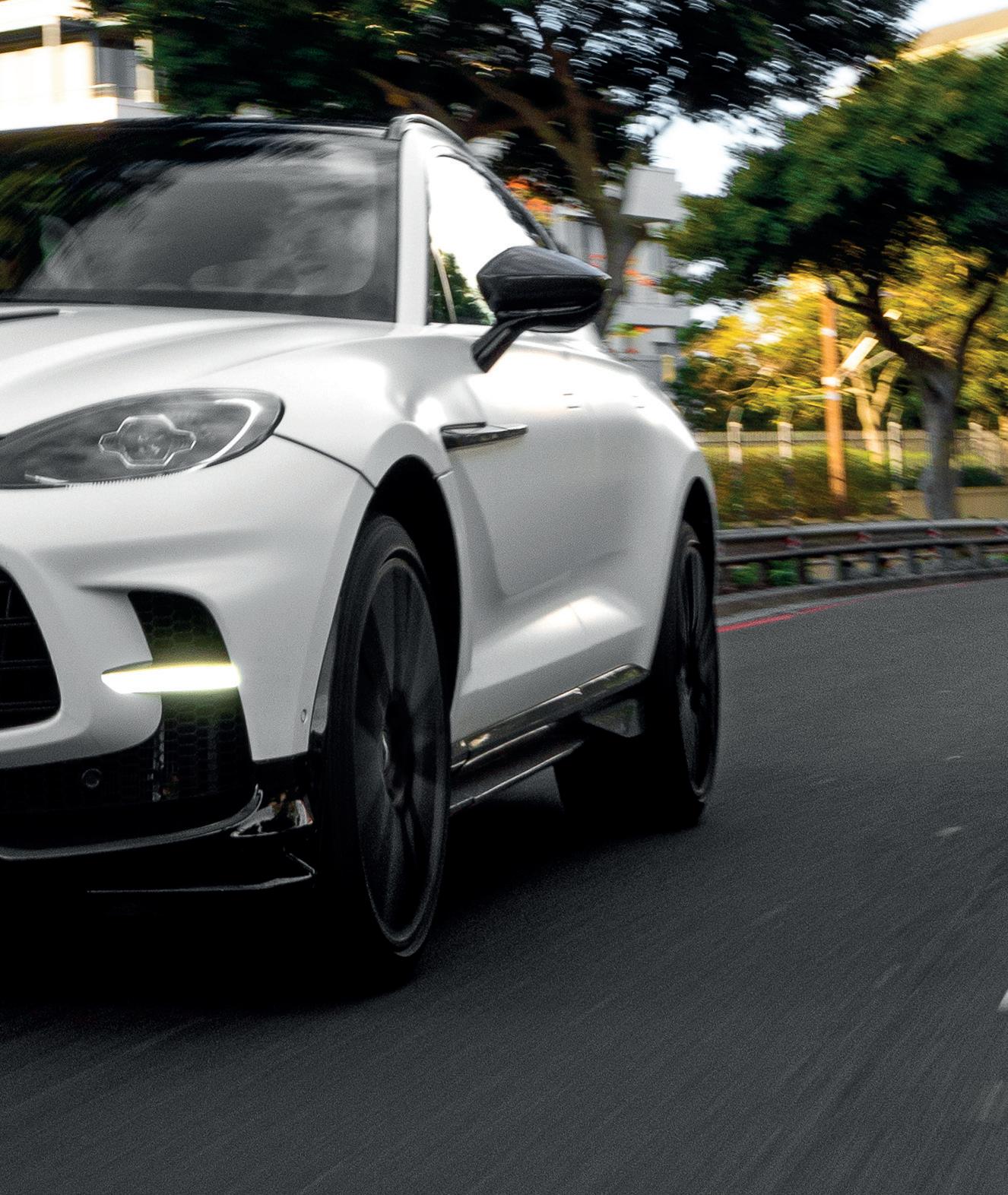
An SUV like no other? Aston Martin says so. So how is the apex DBX?
Words: Marius Boonzaier mariusboonzaier
Photos: Timothy Throne itstimooo on-road presence; balance between comfort and dynamism dated infotainment
DEEP DRIVE 93 ISSUE 7 APEX
Billing your product as an SUV like no other is a bold statement to make. To live up to this claim, the DBX707 has to outgun performance SUVs like the (more comfortable) Lamborghini Urus S and (more focused) Performante with their devilish 666 ps (490 kW) and (471 kW) Porsche Cayenne Turbo GT, the fastest SUV to lap the Nürburgring Nordschleife. The apex DBX’s power and torque outputs of 520 kW and 900 Nm overshadow that of these rivals. If you consider the Purosangue an SUV (Ferrari seemingly doesn’t), the DBX707 is the most powerful of its kind.

The DBX707 has the Urus S beat at the 0–100 km/h stakes at 0.2 seconds quicker to the three-figure marker from a standstill. If ever the DBX707 were lined up against the Urus Performante and Porsche’s first-ever GT-badged SUV, the trio would reach 100 km/h simultaneously if they were to accomplish their claimed sprint times of 3.3 seconds. Maintain acceleration, and the Brit will keep pace to 310 km/h, a top speed slightly higher than that of its competitors. But what’s the pinnacle DBX’s lap time around the Green Hell? Don’t bother asking. Although more powerful, it has a higher top speed and has been tested around the 20.832 km northern loop, Aston hasn’t attempted

DEEP DRIVE
DEEP DATA

Price: R4 800 000 Engine: 4.0 L, V8, turbopetrol Transmission: 9-spd AT Driven wheels: 4 Power: 510 kW @ 6 000 r/min Torque: 900 Nm @ 2 600-4 500 r/min 0-100 km/h: 3.3 seconds Top speed: 310 km/h Fuel consumption: 14.2 L/100 km CO2: 323 g/km Length: 5 039 mm Height: 1 680 mm Width: 1 998 mm Wheelbase: 3 060 mm Weight: 2 245 kg Luggage capacity: 638 L Fuel tank: 85 L Warranty: 3 years/unlimited km Service plan: 3 years/unlimited km
95 ISSUE 7 APEX
a record-breaking run … yet. And that’s perfectly fine (though we will admit it would be interesting). Why?
In true Aston fashion, the DBX707 is blisteringly quick, that’s been established, but a sophisticate at heart; its heart beating beneath a chiselled body, specifically tailored to allow optimal airflow to its breathing apparatus.


Compared to the standard model (internally named DBX550), the DBX707 is 115 kW and 200 Nm more powerful and it’s front grille is 20 per cent larger to allow more air to reach the largest (ball-bearing) turbochargers ever fitted to a Mercedes-AMG 4.0-litre V8. Here it has been specifically calibrated and directs power to the fore and aft axles via a nine-speed wetclutch automatic transmission instead of a traditional

96 ISSUE 7 APEX DEEP DRIVE
torque converter. The rear spoiler and di user have also been enlarged for enhanced aerodynamics.
Engaging launch control, the rear haunches squatted over the test unit’s 23-inch alloy wheels (22-inch items are standard fitment) as the the revs rose, along with the burble of the V8. The Brit took a deep breath ... it’s best you do, too. Lift your left foot o the brake pedal. Set o . The DBX707 felt staggeringly quick. If not quite accomplishing the 3.3 seconds to 100 km/h, it didn’t feel far o its claimed sprint time.
Where the Aston truly shone was on sinuous back roads. Set to its most performance-orientated driving mode, the DBX707’s steering firmed up, allowing for sharper handling. The suspension became more dynamic but not so much as to render the drive an uncomfortable experience.

The DBX707’s Aston Martinmade architecture (remember, some of its competitors share platforms) felt taut on the winding stretches of tarmac. There was little body lean in the bends.
The DBX707’s bodywork measures 5 039 mm bow to stern, 1 998 mm in width and 1 680 mm in height (when its adaptive air-suspension arrangement is in its standard setting). The ride height can be adjusted from 190 mm to 235 mm. Aston’s 2 245 kg performance SUV was seemingly composed, not only for a vehicle of its ilk but for a motor car in general. Reining in speed is a set of 420 mm front and 390 mm rear ventilated brake discs.
The DBX707 is most at home in the urban environment and, whereas it hides its dimensions and mass well around corners, its sheer size was felt in the city. Fortunately, it ships with all the necessary parking aids to make manoeuvring a cinch in tight spaces. However, its exterior proportions became favourable when seated inside the opulent interior, which, of course, can be personalised to your heart’s extent. The front headroom was ample, as were the rear head- and legroom. The boot compartment swallows a generous (claimed) 638 litres of luggage. Together with its potent powertrain and pliant ride quality in its most comfortable setting, this makes the DBX707 a commendable grand tourer.
Myriad standard convenience and entertainment items are present. Three-zone climate control keeps the cabin cool, while Apple CarPlay screen mirroring relays tunes over an 800-watt 14-speaker sound system. Aston Martin Music
by
Ross
Depress the throttle for quick overtaking, and the exhaust note will soon mu e the
hip-hop tune. Activate the adaptive cruise control, sit back, and enjoy the ride. Long-distance journeys are where the DBX707 excels. A 4/5
THE VERDICT
On paper, paging through the DBX707’s absolute power, torque and performance figures, the British brand’s performance SUV seemed bonkers. To a certain extent, it is. However, once getting behind the steering wheel, the thought faded. Overall, the apex DBX makes sense. Yes, it has more power than you’d ever need (and probably don’t need in a car of this kind) and performance figures that will leave you awestruck. Aston’s engineers were firmly focused on extracting maximum dynamism but never lost sight of what makes a modern SUV great. Whereas some manufacturers have sacrificed comfortability at the altar of performance, Aston Martin remained committed. The DBX707 forms a neat balance between the former and the latter. This makes it a performance SUV like no other.
Rick
ft. Drake and Chrisette Michele, anyone?
97 ISSUE 7 APEX

98 ISSUE 7 APEX
LEXUS LX 600 F SPORT
The latest Lexus LX majors in luxury yet retains its o -road credentials.
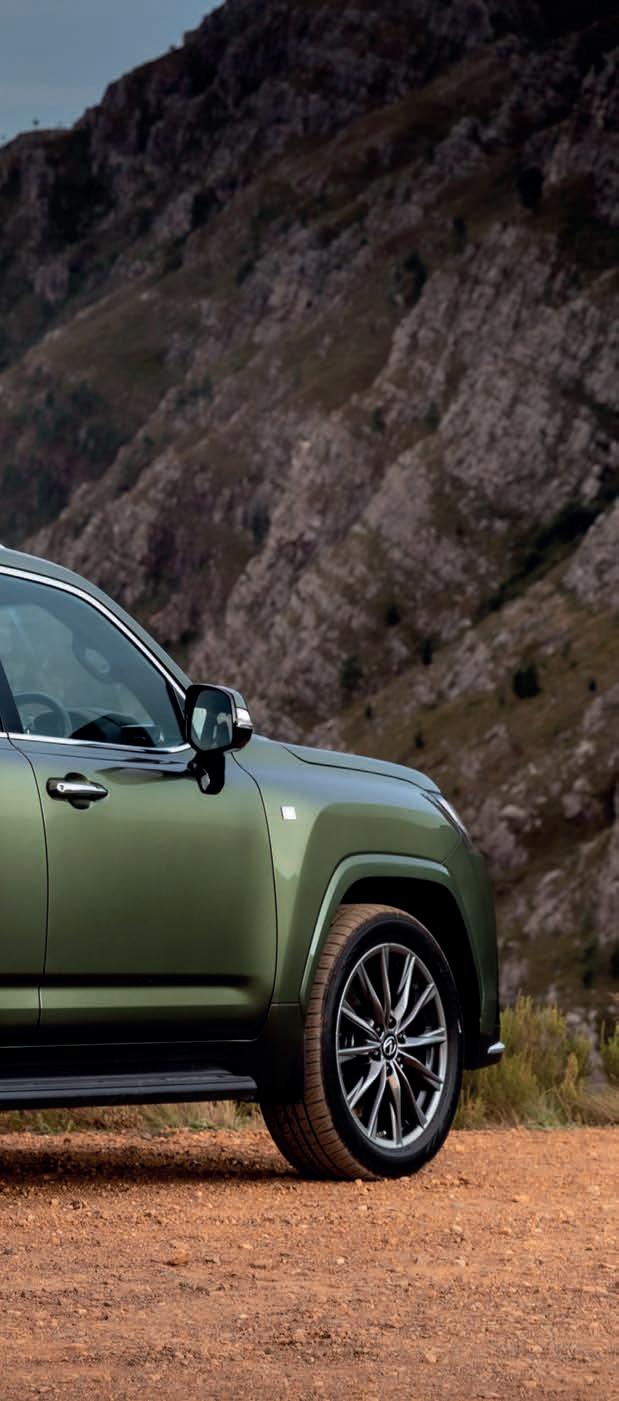 Words: Marius Boonzaier mariusboonzaier
Words: Marius Boonzaier mariusboonzaier
opulent cabin; solid construction; supple ride quality not as dynamic as its rivals
Over the past few months, my girlfriend and I started searching for a new apartment to rent, browsing the classifieds, and heading to viewings, but to no avail. We’ve yet to find a place in Cape Town that is large enough, has ample parking and falls within our budget. Considering we’re planning to stay in Cape Town, finding one with all these prerequisites is di cult. It’ll take some time but the search continues. Recently, I headed to a viewing, driving the box-fresh Lexus LX. The 360-degree surround-view camera made it a breeze to park the large SUV in a tight side street. I met the landlord and headed to the apartment. I couldn’t help but start measuring it in LX terms. How many units of the Japanese firm’s luxury SUV could fit into the apartment?
In truth, not that many. The LX is massive, measuring 5 090 mm bow to stern and 1 990 mm in width, or 10.1 m2 of floor space. Although, you cannot drive an apartment (in this case) to the shops or your weekend destination. I hopped back into the Lexus and headed home.
So, how does it drive? Tested here is the LX 600 in – a first for an LX – F Sport guise. Under this variant’s sculpted bonnet is the the Japanese manufacturer’s 3.5-litre V6 petrol engine, switched on via an engine start/stop button featuring fingerprint recognition. Coupled with a 10-speed automatic transmission, the twin-turbocharged unit produces 305 kW and 650 Nm, the latter available from a lowly 2 000 r/ min. There was a naturally aspirated feel to the powertrain. The engine’s response to throttle inputs was immediate,
DEEP DRIVE 99 ISSUE 7 APEX
DEEP DATA

Price: R2 314 400 Engine: 3.5 L, V6, turbopetrol Transmission: 10-spd AT Driven wheels: A Power: 305 kW @ 5 200 r/ min Torque: 650 Nm @ 2 000-3 600 r/min 0-100 km/h: n/a Top speed: 210 km/h Fuel consumption: 11.3 L/100 km CO2: 272 g/km Length: 5 090 mm Height: 1 895 mm Width: 1 990 mm Wheelbase: 2 850 mm Weight: 2 680 kg Luggage capacity: 1 109 L Fuel tank: 110 L Warranty: 7 years/100 000 km Maintenance plan: 7 services/100 000 km
DEEP DRIVE
thanks to the well-calibrated self-shifter. Although the power and torque outputs were su cient, it’s not the last word in performance. However, this is not what the LX was built for, even when donning the F Sport badge. It was made to transport its occupants in comfort and sheer opulence in which it majors.
The ride quality is exceptionally smooth. The adaptive variable suspension with active height control (standard ride height is 210 mm and setting include Low, Normal, High1 and High2) soaks up road scars with aplomb, even with the F Sport’s 22-inch alloy wheels. In addition, the suspension arrangement automatically adjusts when detecting sharp steering inputs to reduce body roll by 25 per cent. Considering the LX’s dimensions, body lean was still present but less noticeable in the bends. Overall, the steering was light.
O the beaten track, ride quality felt equally supple. Rest assured, if you were inclined to take the LX o -road, it should fare well. Whereas some luxury SUVs have all-wheel drive purely
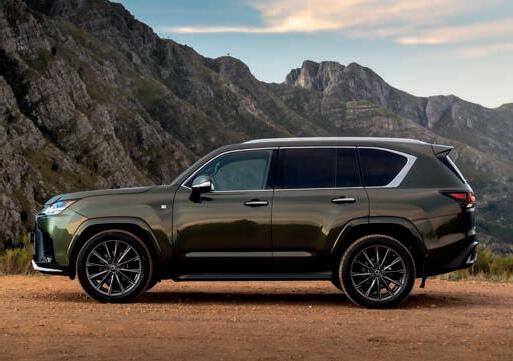
We’ve had to wait 14 years for the latest LX. It majors in comfort and opulence and, like its forebear, should withstand the test of time. It’s well built and it has been, and will be, around for years. The wait for the new LX has been worth it. We would argue that the LX 500d (also
for the peace of mind of safety, the new LX has retained its 4x4 prerequisites. There are several o -road driving modes, courtesy of Lexus’ Multi-Terrain Select system, and the 10-speeder features a low-range transfer case. The F Sport boasts a Torsen limited-slip di erential and the approach and departure angles are 21 and 21.7 degrees, respectively. The water fording depth is rated at 700 mm. All of this should allow you to reach some of the most desolate environments in the world. And you’ll be doing so in luxury.

The F Sport’s Lexus-solid cabin sports model-specific seats replete with heating and ventilation functionality. The pews are lounge-like – exceptionally comfortable – with the captain’s chair electrically dialled into the preferred position, it provides a commanding view of the road. Owing to the wide centre console, the space for the driver and front passenger is not as large as the exterior dimensions might suggest. Passengers at the rear, though, enjoy an expansive seating area. The luggage capacity is rated at 1 109 litres.
The LX’s dual-stacked touchscreen arrangement comprises 12.3- and 7.0-inch displays, the former used for infotainment.
Apple CarPlay/Android Auto Screen mirroring relays tunes via a Mark Levinson surround sound system. Fortunately, not all functions are operated via touch. For its flagship 4x4, Lexus has retained physical controls to adjust the volume and climate and engage the o -road modes. A

THE VERDICT
101 ISSUE 7 APEX
4/5
BMW IX3 M SPORT
The X3 has embraced electrification. Donning an ‘i’ next to its moniker, BMW’s emissions-free premium midsize SUV aims to make its popular, traditionally powered kin proud.
Words: Marius Boonzaier mariusboonzaier
palatable pricing; standard spec; familiar BMW feel exterior design may be too traditional for some; lacks the performance and all-wheel drive o ered by rivals
In September, the BMW Group announced it was on track to double its global electric-vehicles sales figure in 2022. In the first nine months of the year, the firm sold 128 196 units of fully electric BMW and Mini vehicles, amounting to a sales increase of 114.8 per cent. Together with the i4 and the iX (both tested in issue 05), one of the cars driving the growth was the iX3. But how will the Bavarian brand’s battery-powered X3 be received in South Africa, where the petrol- and diesel-powered X3 models are so adored?
If you were to place the iX3 in the internal combustionpowered X3 line-up, in terms of pricing, it slots in between its (all-wheel drive) xDrive30d (from R1 214 340) and M40i (R1 459 046) siblings. (See how the iX3 compares to these models in Internal combustion kin.) If you think about it, in terms of the cost of EVs, the electrified X3 is not badly priced for a premium midsize electric SUV. Not yet convinced? Consider the German Big Three and the iX3’s rivals: the Audi e-tron 55 quattro and Mercedes-Bez EQC 400 4Matic. The former is priced from R1 745 000, and the latter at R1 679 000. It’s worth noting that both these models boast more power and torque (and, as a result, better performance figures) and all-wheel drive, the latter of which contributes to on-road driving dynamics (we say onroad because it’s unlikely these vehicles will ever get their tyres dirty on anything but a stretch of gravel).

102 ISSUE 7 APEX

DEEP DRIVE 103 ISSUE 7 APEX
In contrast, the BMW’s (210 kW/400 Nm) single electric motor exclusively drives the rear wheels. That said, the iX3’s power and torque outputs seemed su cient. It’s all you need in an SUV in this segment with peak torque – although less than the EVs mentioned above – available as soon as you depress the throttle. Where the iX3 lords it over its German rivals is in the range stakes. BMW claims the iX3 can travel up to 460 km on a single full charge, which is 20 km more than Audi and Mercedes. When charging is required, plugging the iX3 into a 150 kW DC fast charger adds 100 km of range in 10 minutes. To clarify, suppose you were to load up the 510-litre luggage compartment and set o from Cape Town for a vacation road trip along the Garden Route to Plettenberg Bay. You will be able to reach Mossel Bay (depending on how you drive, of course), where one of these fast chargers is located, and continue the journey in a few minutes. Although, we would argue it’s best to keep it plugged in until the 74 kWh (net) battery pack is fully recharged, costing around R435. Then, the iX3 should complete the trip e ortlessly. It’s worth noting that recharging the batteries
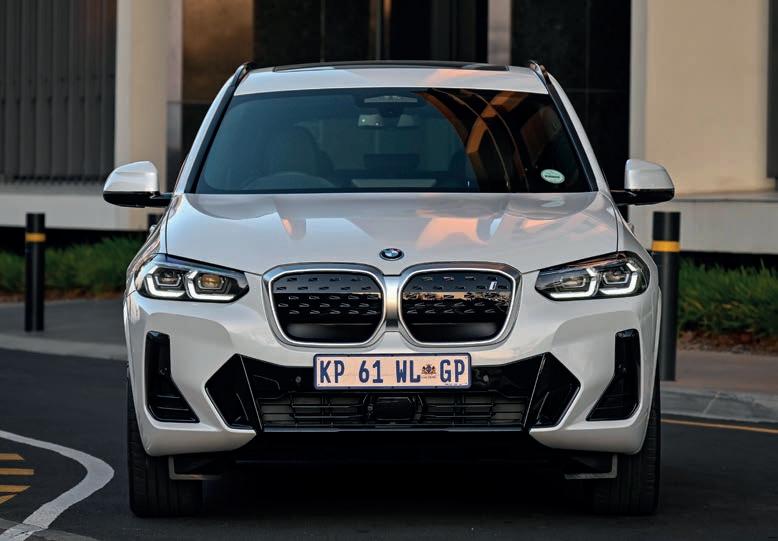

DEEP DATA
R1 290 000 Battery capacity: 80 kWh (gross)/74 kWh (net) Engine: single electric motor

Transmission:
AT
kW Torque: 400 Nm 0-100 km/h: 6.8 seconds Top speed: 180 km/h Electric consumption: 18.9-18.5 kWh/100 km Range: 460 km CO2: 0 g/km Length: 4 734 mm Height: 1 668 mm Width: 1 891 mm Wheelbase: 2 864 mm Weight: 2 185 kg Luggage capacity: 510-1 560 L Warranty: 2 years/ unlimited km (8 years/100 000 km for battery) Maintenance plan: 5 years/100 000 km
Price:
1-spd
Driven wheels: R Power: 210
104 ISSUE 7 APEX DEEP DRIVE
costs significantly less when doing so at home. However, replenishing the batteries here takes much longer than using a DC station. BMW also o ers free charging (for a limited time) at dealerships.
Range covered, how did the iX3 fare in town? Thanks to the regenerative braking system, one of the best we’ve experienced in an EV, no range anxiety was present during the daily commute in tra c and shopping trips throughout the week. Although sitting on 20-inch, designed-forenhanced-aerodynamics alloy wheels, the iX3 soaked up any road imperfections. The suspension is subtly sprung. The steering felt similar to that of a non-electric X3. It was very BMW SUV-like and well weighted.
Available in only one level of specification, BMW’s M
Sport package, the emissionfree midsize SUV boasts numerous standard features. These include the firm’s Live Cockpit Professional digital instrument binnacle, touchscreen infotainment, a Harman/Kardon sound system, automatic climate control and heated front sport seats. Ambient lighting is also present.
Like the interior, the exterior resembles that of the traditionally powered X3 derivatives. However, as this is a BMW i variant, the iX3 features several model-specific items, the most notable is the closedo front grille and blue detailing. Some may argue that more futuristic styling would have been refreshing. Yet maintaining a similar look to its siblings won’t lead to divided opinion. A

THE VERDICT 4/5
In a country where the X3 is arguably one of the best in its segment, iX3 presents owners of BMW’s popular premium midsize SUV with the opportunity to step into a car that feels familiar yet embraces a new-energy powertrain.



Internal combustion kin
Price
Driven wheels
Power/torque
Fuel consumption
Fuel tank
Range
Cost per tank*
*At November 2022
R1 214 340 3.0 L, 6-cyl, turbodiesel 8-spd AT 4 195 kW/620 Nm 6.6 L/100 km 68 L 1 030 km R1 476.28
X3 xDrive30d X3 M40i
Engine Transmission
8-spd
Nm
DEEP DRIVE 105 ISSUE 7 APEX
R1 459 046 3.0 L, 6-cyl, turbopetrol
AT 4 285 kW/500
8.9 L/100 km 65 L 730 km R1 538.55

106 ISSUE 7 APEX
AUDI RS3 SPORTBACK QUATTRO

Likely singing its swansong, the Audi RS3, in concert with its sonorous five-cylinder, is as impressive as ever.
Words: Vann van Staden winewheelsandwatches
Photos: Timothy Throne itstimooo
dual (comfort/performance) personality; solid build quality the last of the five-cylinder Audis?
When is a hatchback classified as hyper?
The design has to be considered, but, more importantly, the way it drives – handles –and, arguably, the main factor, performance. Audi teased us with the local arrival of the new iterations of its RS3 siblings for far too long. Our interest was piqued and we were finally handed the keys to possibly one of the ultimate hyper hatchbacks. This is why…
First, let’s take a minute to appreciate the striking design of the new RS3. Dressed in Daytona Grey Pearlescent, it gives the impression of a sharply dressed businessperson. The bodywork oozes style yet remains assertive. Bold. It makes its presence immediately known, especially when it plays its sonorous five-cylinder tune over the (standard) RS sports exhaust system.
The cosmetic changes comprise a more pronounced front grille flanked by LED matrix headlamps with the firm’s ‘dynamic light’ design, an Audi staple. A neat feature, the items found on the RS3 put on a unique lighting show. When unlocking the car, R, S and then 3 are displayed before changing to a chequered flag motif. The broader stance adds to the bold look. Extra attention to detail was paid to the rear roof-mounted spoiler. The test unit was fitted with (standard) 19-inch, 10-spoke, Platinum Gray alloy wheels draped in Pirelli rubber.
DEEP DRIVE 107 ISSUE 7 APEX
The interior is adorned with various materials, creating a multi-sensory experience. The contoured front sport seats, replete with contrast stitching, are well bolstered. It’s supportive yet comfortable. A neat detail, the RS insignia is embossed on the front seatbacks. A honeycomb motif can be found fore and aft. The pews are trimmed in Audi’s Dinamica microfibre material and synthetic leather. Nappa leather upholstery is available for R18 200. The standard specifications include the Ingolstadt manufacturer’s MMI touchscreen infotainment set-up, a Bang & Olufson 3D sound system, dual-zone climate control, and a reverseview camera. Cruise control is present, too.
Now, to get to what we are here for: the 2.5-litre five-pot. The petrol engine is endowed with 294 kW and 500 Nm of torque, 20 Nm up from the previous-generation version. The turbocharged unit is mated with Audi’s slick-shifting seven-speed S tronic transmission.
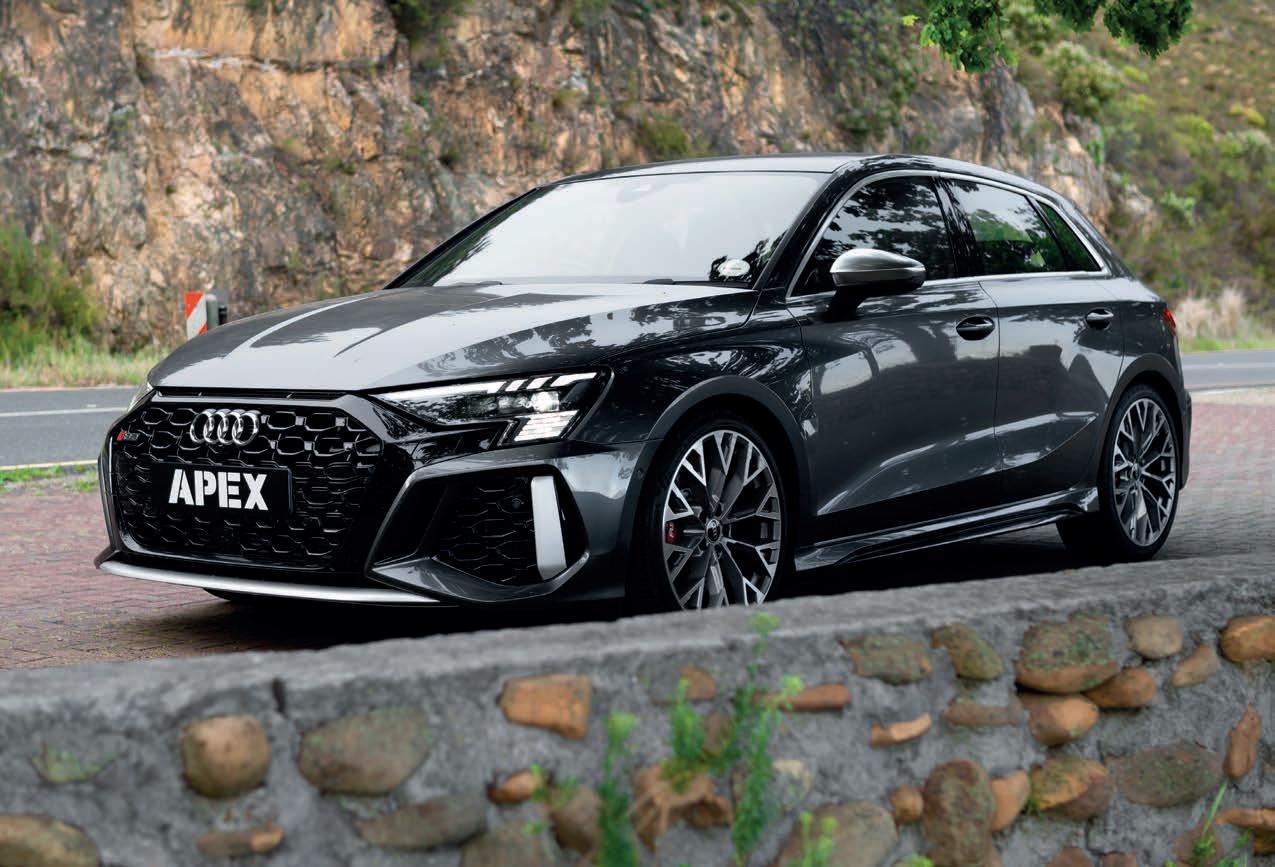
The rule of thumb to be classified as a hyper hatch is the ability for a car to hit the sub-four seconds mark when accelerating to 100 km/h from a standstill. The new RS3 Sportback completes the obligatory sprint in 3.8 seconds, making it one-tenth of a second quicker to 100 km/h than its rival, the equally thrill-inducing A45 S. Interestingly enough, A alterbach’s hyper hatch produces 16 kW more than the RS3. However, the Audi weighs approximately 100 kg less. As standard, the top speed is 250 km/h but this can be lifted to 290 km/h when ticking the correct option box.
The proverbial show stopper, or more like show starter, is the RS torque splitter. In short, this system uses AI tech in the form of an electronically controlled multi-disc clutch set-up that allows torque distribution on the rear axle. This will enable you to lean hard into corners and thus hit the apex. And did we remember to mention the drift mode? We kid you not.
In addition, we love the RS3 Sportback as much as we do because of its ability to transition between ripping apart the tarmac and being a commendable daily driver. Although fitted with 265/30 front and 245/35 rear tyres, the ride was pretty smooth.
DEEP DRIVE
DEEP DATA
The biggest pitfall is possibly its seemingly unquenchable thirst. Audi claims a fuel consumption figure of 9.0 L/100km. We didn’t come close to this. The RS3 wants to be driven and, as a result, we managed to get an average of 11.2 L/100km over the test period, which included urban and open-road driving. This isn’t ideal with today’s hefty fuel prices. However, this can easily be ignored by submerging yourself in the metal heaven that is the RS3 and ignoring your fuel problems like you ignored 2022’s new year’s resolutions to drink less and exercise more. A

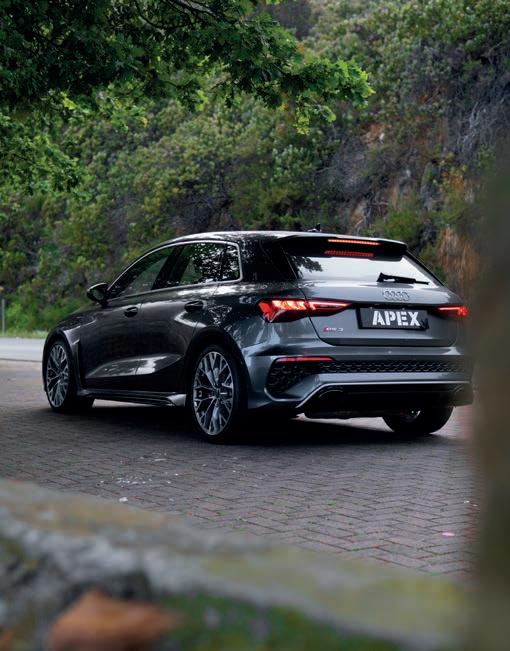
THE VERDICT 4.5/5
This will likely be the last Audi Sport model fitted with the company’s 2.5-litre five-cylinder engine. 2026 will see Audi going 100 per cent electric on all models. So this is ultimately the swansong for the five-pot powerhouse that is the RS3.

Price: R1 215 000.00 Engine: 2.5 L, 5-cyl, turbopetrol Transmission: 7-spd dual-clutch Driven wheels: A Power: 294 kW @ 5 600-7 000 r/min Torque: 500 Nm @ 2 250-5 600 r/min 0-100 km/h: 3.8 seconds Top speed: 250 km/h Fuel consumption: 9.0 L/100 km CO2: 206 g/km Length: 4 389 mm Height: 1 436 mm Width: 1 851 mm Wheelbase: 2 631 mm Weight: 1 529 kg Luggage capacity: 282-1 104 L Fuel tank: 55 L Warranty: 1 year/unlimited km Maintenance plan: 5 years/100 000km
DEEP DRIVE 109 ISSUE 7 APEX

110 ISSUE 7 APEX
JEEP GRAND CHEROKEE L
3.6
4X4
OVERLAND AT
With the new Grand Cherokee L, Jeep aims to build on its luxury-SUV heritage. Will it make its ancestors proud?

Words: Kumbirai Mtshakazi IamKumbi bold looks; plush cabin; comfortable ride no diesel option; thirsty engine DEEP DRIVE 111 ISSUE 7 APEX

DEEP DRIVE
IIn the annals of automotive history, the words ‘luxury’ and ‘SUV’ were seldom associated. In fact, according to Jeep, the word SUV became a part of popular speak in only the 1980s – 1986 to be precise – when it was first used according to Merriam-Webster. Interestingly, an Internet source noted the word ‘SUV’ was used in the 1974 Jeep Cherokee SJ brochure, though the term didn’t quite stick. So, when did the luxury SUV originate? Although not known as it at the time, with the increase in popularity of luxury SUVs, many have delved into the archives and have established a car of this ilk. There are some who maintain the first luxury SUV
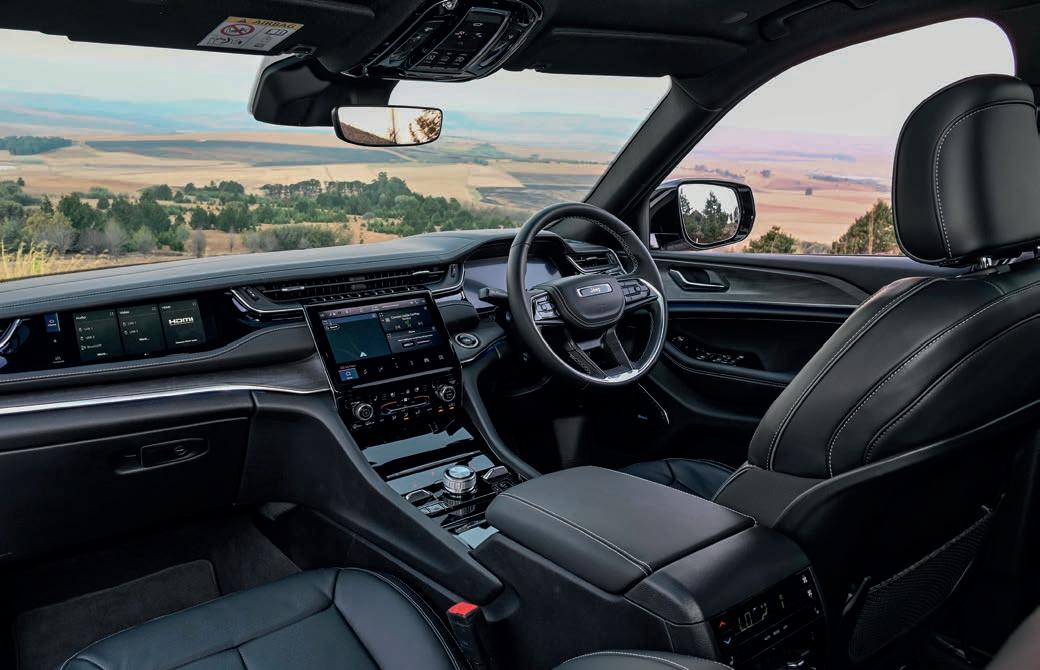
originated in the ’60s in the shape of the Jeep Wagoneer. Jeep is thus undoubtedly no stranger to SUVs or their more opulent counterparts. In its latest Grand Cherokee, the automaker has its sights set on making proud the vehicle that probably started this trend.
Although the L in the locally and, as yet, only available Grand Cherokee signifies it has a long wheelbase, in the fifth iteration, it can be used to describe the luxury accompanying it. We were left wholly impressed at the launch. However, it was time to add some mileage to Jeep’s large SUV to see how it fares in a test.
DEEP DATA
Price: R1 479 900 Engine: 3.6 L, V6, turbopetrol Transmission: 8-spd AT Driven wheels: 4 Power: 210 kW @ 6 400 r/min Torque: 344 Nm @ 4 000 r/min 0-100 km/h: n/a Top speed: n/a Fuel consumption: 10.6 L/100 km CO2: 243 g/km Length: 5 204 mm Height: 1 816 mm Width: 2 149 mm Wheelbase: 3 091 mm Weight: 2 270 kg Luggage capacity: 1 328-2 396 L Fuel tank: 87 L Warranty: 5 years/100 000 km Maintenance plan: 5 years/100 000 km
DEEP DRIVE 113 ISSUE 7 APEX






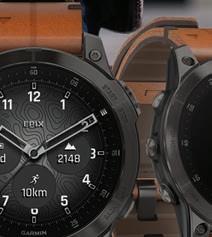




114 ISSUE 7 APEX
™ THE PREMIUM ACTIVE SMARTWATCH WITH A BRIGHT AMOLED DISPLAY © 2022 GARMIN LTD. OR ITS SUBSIDIARIES.
WEAR EPIX. BE EPIC. EPIX
In terms of its looks, the L can also be used to signify large. The Grand Cherokee L is nearly impossible to ignore. It measures over five metres in length and two metres in width. It’s imposing. At the front, the chrome-trimmed signature Jeep grille is bold, while the bodywork makes the stylish LED headand taillamps look more tapered than they are. In short, the styling is classic American.
Climbing inside, you are welcomed by arguably one of the most luxurious SUV interiors. Jeep has risen above and beyond. The cabin’s fitment and features reflect the price tag. The midrange Overland derivative tested here comes in at R1 479 900. For the pricing, you get a 10.25-inch digital driver’s display, a 10.1-inch touchscreen for infotainment and a 10.3-inch front passenger-side item. The driver cannot see or be distracted by the latter display, not because the dashboard is so broad, but because the pixel technology makes it impossible. The front passenger can access navigational information, camera views, and visual and audio entertainment. However, only the driver can see the head-up display. The front seats o er heating (the second-row pews do, too), ventilation and massage functionality.
There are two traditional USB ports and two USB Type-C ports. This will ensure charging is never an issue, as will wireless charging. Audiophiles will adore the 19-speaker McIntosh sound system. The speakers in the boot did rattle a bit when we cranked up the volume, though.
There was ample legroom in the second row. While we didn’t spend much time in the third-row seats, there was su cient room during short drives. Nonetheless, we still reckon that, like many other seven-seater SUVs, the third row is reserved for the family’s younger members.
The Grand Cherokee L o ers peace of mind with its numerous safety features including active lane management, adaptive cruise control, and rear cross-tra c alert. We did find the warning sounds intrusive and sometimes unnerving, especially the lane-keep assist system.


The seven-seater is outfitted with Jeep’s familiar 3.6-litre naturally aspirated V6 petrol engine, mated with an eightspeed automatic transmission. The self-shifter was seamless in its workings. The Pentastar motor produces 210 kW/344 Nm. However, we thought a diesel unit would be more suited to the Grand Cherokee L, as it should return improved fuel economy and boast a touch more torque. It was challenging to get close to the claimed average fuel consumption figure of 10.6 L/100 km. The best we managed was 14.5 L/100 km. This included both highway and city driving.

The steering feel had a good weight to it and NVH levels were commendable. The air-suspension configuration made the ride feel composed and enabled the driver to lift the ground clearance to 277 mm, which is helpful when taking less-travelled paths. Furthermore, the Jeep Grand Cherokee L includes Jeep’s Selec-Terrain driving modes and four-wheel drive with a lowrange transfer case. A
THE VERDICT 3.5/5
The new Grand Cherokee felt opulent, comfortable and spacious. Couple these with four-wheel drive, and you have a luxury SUV that should make its ancestor proud. The Overland is our model of choice.
DEEP DRIVE 115 ISSUE 7 APEX
KIA SPORTAGE 1.6 T-GDI GT LINE DCT
The most striking Sportage to date, the fifth iteration aims to continue its track record as Kia’s global bestseller.

Words: Melinda Ferguson melsmacked
It’s hard to think of the Kia Sportage without associating it with automotive designer Peter Schreyer. Although the South Korean manufacturer’s midsize SUV debuted in 1993, looking a lot like a bulletproof, ungainly station wagon, the third generation made the world sit up and take notice. The Sportage was a game changer for Kia and is regarded by many in the industry as one of Schreyer’s finest works. New customers flocked to the brand, which had hitherto been regarded as somewhat of a poor cousin to more popular Far East o erings. With its iconic tiger nose grille, the 2010 Sportage became a multi-design-award-winning vehicle. Combined with an impressive drivetrain and a rep for reliability, the Sportage’s aesthetic heritage continued into the fourth generation, which debuted in SA in 2016. This model set a world record for the World’s Longest Test Drive Relay in a drive that covered 3 291 km through six SA provinces over seven days with 520 test drivers at the wheel.
The fifth generation was launched locally in September this year. It’s arguably the most beautiful Sportage to date. In my books, it’s the finestlooking mid-size SUV in its segment, which comprises a string of handsome hotties, including the Mazda CX-5, Toyota RAV4, the VW Tiguan and Hyundai Tucson.
With five derivatives in the line-up – the LX, EX, GT-Line, GT-Line Plus and GT-Line S – even the so-called entrylevel is packed with many goodies. These include automatically activated LED headlights, fog lamps, selectable drive modes, a leather-clad steering wheel and transmission lever, a reverseview camera, and an attractive, curved 12.3-inch touchscreen infotainment system compatible with Bluetooth and Android Auto and Apple CarPlay. There are also 40:20:40 split-folding rear seats. The higher-specced EX and GT models are graced with a bunch of additional premium features like heated seats, an electric tailgate, a panoramic sunroof, steering wheelmounted paddle shifters, and more upmarket upholstery.
drop-dead aesthetics; superior safety systems; excellent entry-level o erings no diesel engine
116 ISSUE 7 APEX

DEEP DRIVE 117 ISSUE 7 APEX
Then there is the host of safety systems, , which is a key consideration in this preciouscargo-carrying family-vehicle market. With its six airbags and semi-autonomous technologies, including lane-follow assist, lane-keep assist, intelligent cruise control and forward-collision avoidance assist, it’s easy to see why the new Sportage claimed top honours when it underwent the stringent Euro NCAP safety testing. All derivates also come with electronic stability control, hill-start assist, downhill brake control, blind-spot collision warning, trailer stability assist and ABS with electronic brakeforce distribution (EBD).

But how does the new Sportage drive? Its turbocharged engine felt spritely, assisted by a praiseworthy dual-clutch gearbox that did its job without any sign of lag. We were impressed by the whisper-quiet cabin, at speed on highways and the overall drive comfort over various surfaces. While it’s not supposed to be a speedster, it proved to be an eager accelerator and particularly wowed when it came to its agility and road holding. Of course, there’s always a degree of body roll in most SUVs, but the Kia felt solid and surefooted. A

DEEP DATA
Price:
995 Engine: 1.6 L,
Transmission:
Driven wheels: F Power: 131 kW @ 5 500 r/min Torque: 265 Nm @ 1 500-4 500 r/min 0-100 km/h: 8.8 seconds Top speed: 201 km/h Fuel consumption: 6.5/100 km CO2: 149 g/km Length: 4 515 mm Height: 1 650 mm Width: 1 865 mm Wheelbase: 2 680 mm Weight: 1 497 kg Luggage capacity: 591-1 780 L Fuel tank: 54 L Warranty: 5 years/unlimited km Service plan: 6 years/90 000 km
R649
4-cyl, turbopetrol
7-speed dual-clutch
118 ISSUE 7 APEX
Under the eye of Schreyer
In 2006, Kia Motors managed to seduce young German wunderkind Peter Schreyer away from Audi. The hiring was inspired. Design became the brand’s cornerstone; over the next 14 years, Kia would win over 200 motoring accolades, including 20 highly coveted Red Dot design awards. Suddenly, formerly forgettable Korean cars were being regarded with newfound respect, making Kia’s success one of the most significant turnarounds in automobile history. Under the eye of Schreyer, there have been a host of beauts like, of course, the gorgeous redesigned 2010 Sportage, the speedy Stinger and the funky Soul.

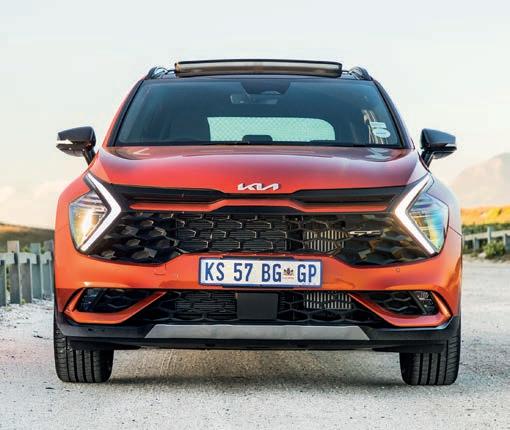

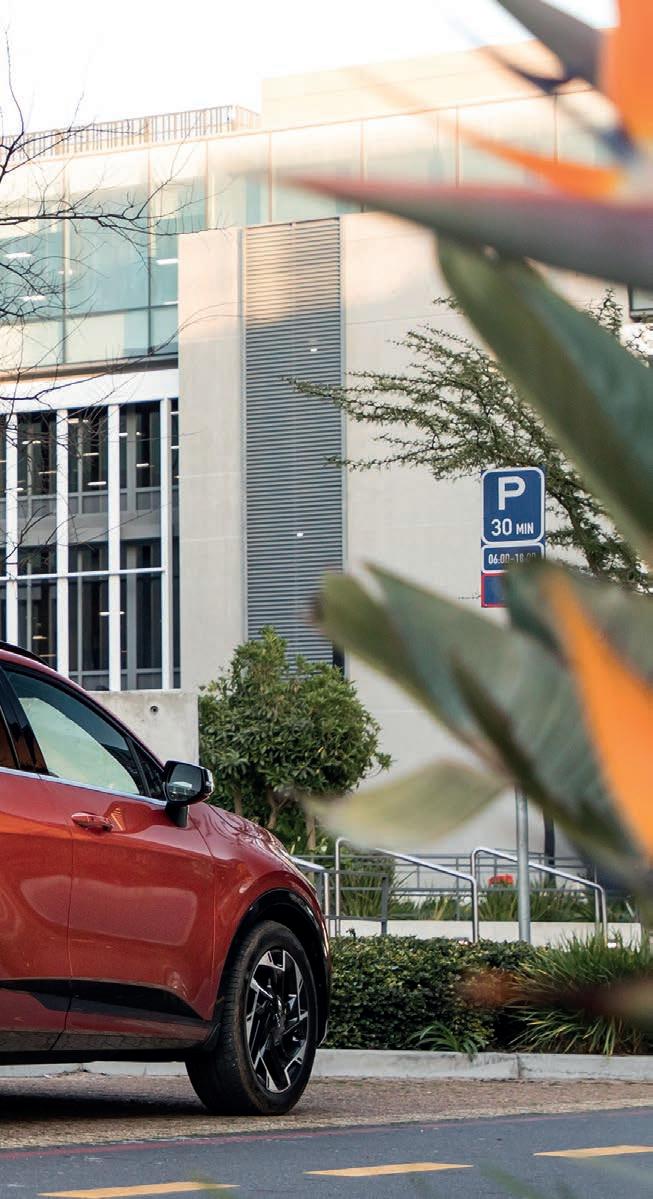
THE VERDICT 4/5
Kia has become synonymous with relative a ordability, well-specced quality and creative design, and the new Sportage ticks all the boxes. Having sold close to six million units globally, the Sportage has unsurprisingly been Kia’s top seller for years. With an SUV portfolio that kicks o with the compact Sonet, the slightly bigger Seltos, the mid-sized Sportage and the massive Sorento, the South Korean brand has an excellent line-up that should satisfy a variety of consumers’ insatiable appetite for SUV/crossovers.
DEEP DRIVE 119 ISSUE 7 APEX
RIDING SHOTGUN WITH I
S I V
S I V Nges i


ges


























































Hand of the king, or a king himself? We catch up with the sometimes funny, sometimes controversial, but always lovely guy, Siv Ngesi.
Words: Vann van Staden winewheelsandwatches
Photos: Brandon Jacobs snapchangemedia


120 ISSUE 7 APEX LIFESTYLE






V V i 121 ISSUE 7 APEX
for the longest time, but our schedules never allowed this. So when our stars eventually aligned, we had a date. Now to find the perfect car to match this giant of a personality. It wasn’t challenging; I knew exactly what I needed to do. A quick call to Herman at Ford Tygervalley, and all was set. I went to collect a current-generation Ford Mustang GT. I’m not sure who turned the most heads, Siv or the Mustang, but once he got in the car, it didn’t matter anymore because heads were turning non-stop.
Brother, finally! Jislaaik, this took long enough.

SIV In my defence, the previous car you wanted to put me in looked like a keychain. So this was worth the wait.
(A little awkward chuckle ensued) Like they say, good things come to those who wait. I hope you approve of the wheels today.
SIV I do! The first time I came across Mustangs was in the States. They are so common there. You see 16-year-olds driving them around.
Ja flip, almost like 18-yearolds with their Polos here.
SIV But here, we have a far greater appreciation for them.
You have been hella busy! I watched a trailer for The Woman King. I haven’t had goosies like that in years just from watching a trailer. That must have been quite the vibe.
SIV It was great. A truly fantastic experience working with such a great cast. Almost as great as driving this car. (Siv clearly digs a Mustang.)

You have been super busy, and I have followed you for years. You are still one of the funniest guys out there. Are you planning anything new on the comedy front?
SIV I am busy writing a new comedy show. I want to take it on tour internationally and locally. It’s mostly about masculinity, femininity, drag and pole dancing, the new things I’m into. I am trying to learn new things and unlearn old things. We learn so many things growing up, and now it’s about unlearning them. I’m all about that. I fight injustices. I fight for equality. I have a voice, and I need to use it.
At 2022’s EatOut Awards, you said, “Everyone must enjoy their food other than the vegans.”
SIV How do you know someone is vegan?
They’ll tell you.
SIV I’m just playing around with the vegans. No one gets upset anymore with me; they know I’m just messing around. I make light of most things, and veganism is one of them. But it's all in good fun. I respect everyone and their decisions. I strut around in high heels, so I’m all about respecting decisions.
I saw a clip of you pole dancing in heels. You have got some pretty sick moves!
SIV I am blown away at the response I get every time I put on heels and do my thing. People are fascinated by it. They try and place me in a box of “he must be gay” or something along those lines, but in actual fact, I’m just a person who wants to live and let live. I don’t wear heels to be di erent. I just love wearing them. My view on life is that I just want to be what I want to be! As long as I don’t hurt anyone. I’m just about people living. Life is too short to be judgmental. Do what you want, as long as you don’t hurt anyone; that’s the golden rule. There is no growth in the comfort zone.
We parked the ’Stang and said our goodbyes. Love him or hate him, Siv Ngesi is here to stay, take people out of their comfort zones, and challenge us to be better and do better. I salute you for that, my brother! A

Price: R1 084 900
Engine: 5.0 L, V8, petrol
Transmission: 10-spd AT
Driven wheels: R
Power: 330 kW @ 7 000 r/min
Torque: 529 Nm @ 4 600 r/min



0-100km/h: 4.8 seconds
Top speed: 250 km/h
Fuel consumption: 12.3 L/100km
CO 279 g/km
I have wanted to catch up with Siv Ngesi
122 ISSUE 7 APEX LIFESTYLE
Special thanks to Herman from Tygervalley Ford for lending us one of their gorgeous Mustangs.














P R E M I U M A C C E S S O R I E S Go Automotive | (011) 613 - 2241 SCAN FOR PRODUCTS F R O M K E K O www.keko.co.za


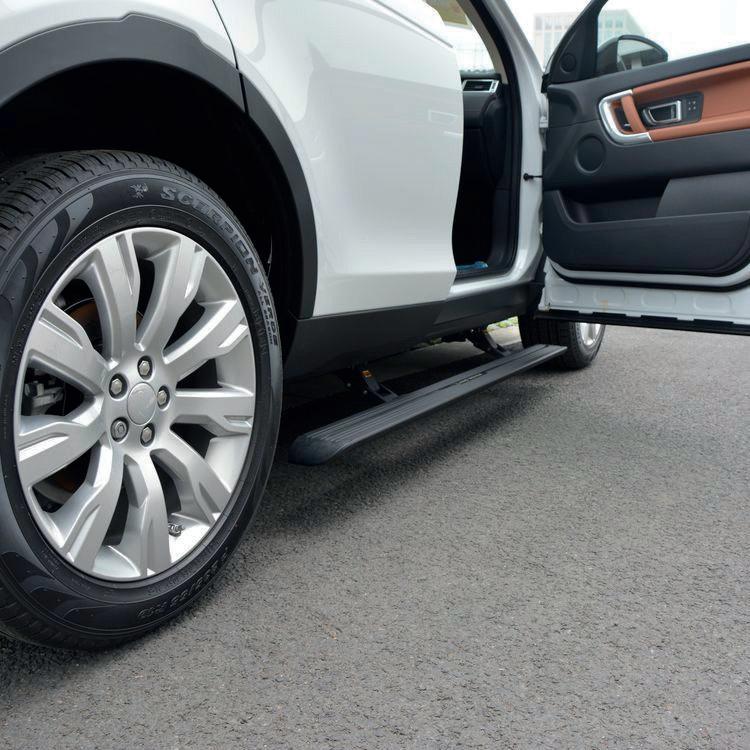


w w w . w o d e n . c o . z a PowerSteps A v a i l a b l e f o r m o s t B a k k i e s a n d S U V ' s . i n f o @ w o d e n . c o . z a S C A N F O R V I D E O G o A u t o m o t i v e | ( 0 1 1 ) 6 1 3 - 2 2 4 1
Ford Ranger 2.0L BiT 4x4 Stormtrak 10AT
 Words: Vann van Staden winewheelsandwatches
Words: Vann van Staden winewheelsandwatches
You always have questions when a long-term test unit arrives in your driveway. One of the first checks I do is how much it has on the clock. I was pretty stoked to get handed the keys to the Ford Ranger Stormtrak after finding out it already had well over 20 000 km.
It has been driven in, ready for the taking.
Now in my first-month stint with the Ranger Stormtrak, I have added another 1 500 km. I drove it like I wasn’t paying for the fuel it guzzled (I don’t know what dream world I was living in, as I knew full well I was footing the rather large fuel bill).
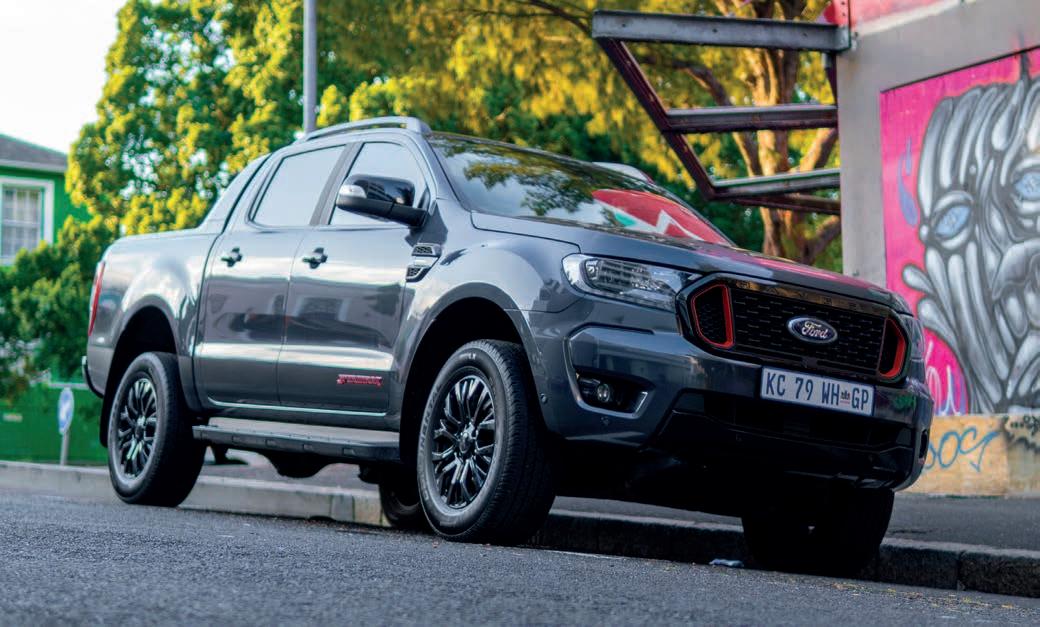
In any other car, this distance wouldn’t have seemed like a big deal, but I felt the impact of this gentle giant on my wallet. I got an
average of between 9.5 and 10.7 L/100km. The claimed (emphasis on claimed) figure is 8.4 L/100 km.
Nonetheless, its thirsty drinking habits aside, the Stormtrak was a commendable daily driver. I towered above most people in tra c, so this sense of a dominating presence follows you, and you get used to it. Parking, on the other hand, was a challenge. I spent most of my time in Sea Point, so if and when on-street parking
spots became available, I had the task of fitting a largerthan-life car into a small parking spot but the reverse camera and parking sensors did come in handy here.
Another cool thing on the Ranger Stormtrak is the Mountain Top power roller shutter that locks with the car, so whatever is left behind in the loading bay is kept safe. A massive leap forward from those traditional canvas covers that could easily be sliced open. A
FUEL CONSUMPTION 10.2 L/100KM DISTANCE COMPLETED 1500 KM CHAPTER 1/2
126 ISSUE 7 APEX LONG TERM
Suzuki Celerio 1.0 GL MT
Words: Marius Boonzaier mariusboonzaier
Suzuki has a knack for building small cars, from the firm’s city hatchbacks to its capable compact o -roader, the Jimny. I recently hung up the keys to my Jimny. In their place is a set belonging to the box-fresh Celerio, my first long-termer since starting as editor of APEX. I was excited. Over the years, I’ve grown fond of the Japanese firm’s compact cars. Of course, they have cons – most cars do –

but they remain endearing despite their drawbacks. I aim to unearth its shortcomings during the long-term test period. The Celerio is an honest little hatchback and, so far, the, the scales have tipped towards the pros.
Starting with the first chapter of my time with the Celerio, it’s been a boon travelling about town. The diminutive dimensions and this top-tier GL model’s standard-fitment rear park
distance sensors made parking a cinch. I believe this variant (in five-speed manual) is the model to go for. Usually, the mid-spec derivative in a line-up o ers the most value. However, I’d argue that, with Suzukis, the top-tier model is well worth the extra money. Priced at a hair below R200 000, the GL features a 7.0-inch touchscreen infotainment system with Apple CarPlay/ Android Auto and manual air conditioning, among
other items.
Whereas these items have become a common sight on budget cars, the Celerio outshines them regarding safety. It’s the first car in its segment with an electronic stability programme (ESP). There are also two airbags, Isofix, ABS and EBD.
Memories are made on adventures in long-term vehicles and they tend to win us over. The Celerio should be no exception. A

FUEL CONSUMPTION 5.8 L/100 KM DISTANCE COMPLETED 226 KM
1/2 LONG TERM 127 ISSUE 7 APEX
CHAPTER
&Rocking















128 ISSUE 7 APEX BIKE
If a music genre, the BMW R18 B is pure rock ’n roll. Cue ZZ Top’s La Grange…





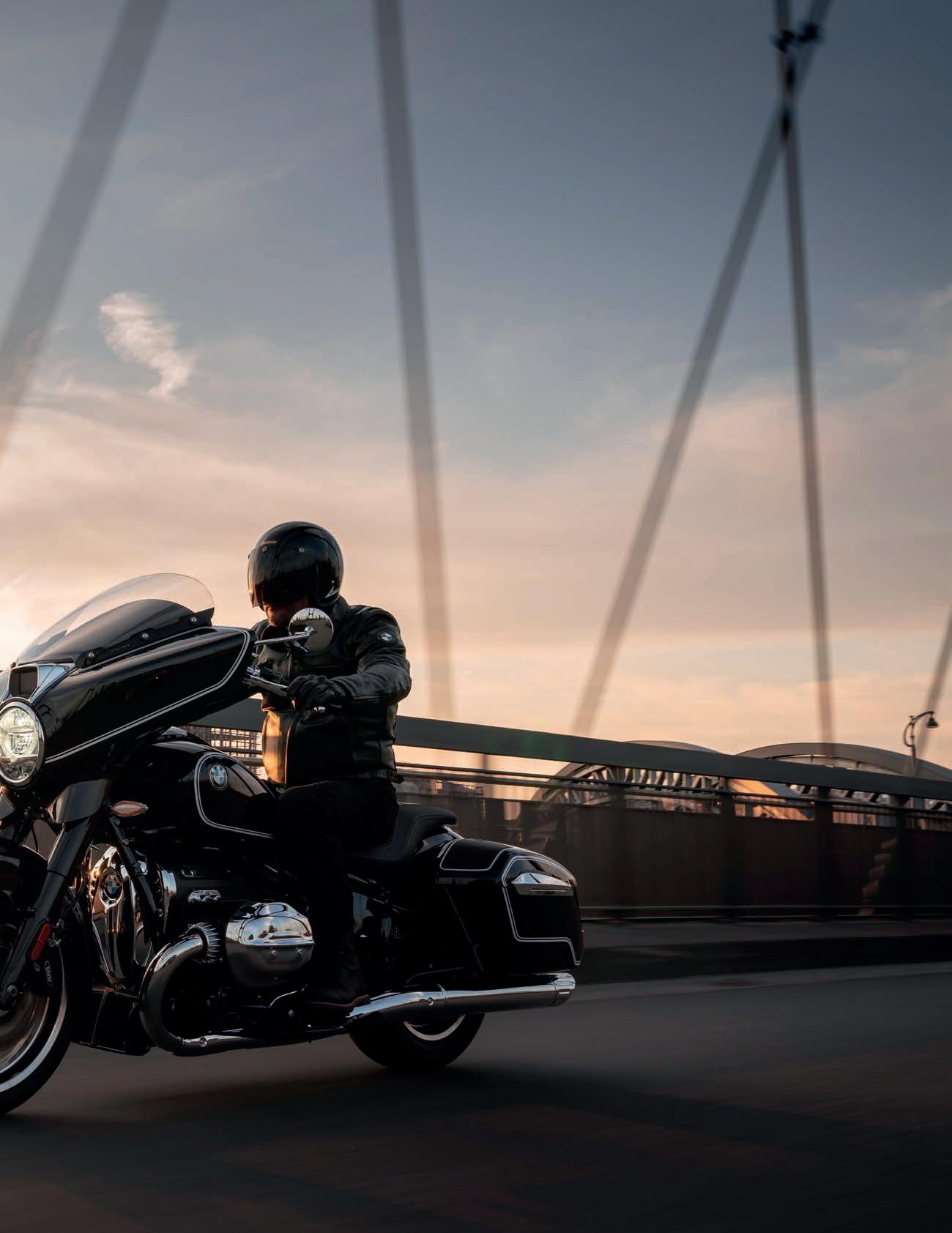
Words: David Donde












&riding

129 ISSUE 7 APEX
It’s best to
And this one was more Bach than Brahms, that's for sure. No Toccata and Fugue in D-minor, either. No, not this one. This BMW R18 B, with its beautiful pinstriping and Marshall speakers and sound system, is heavier than that. No, this bagger-style motorcycle required a genre that needs driving guitars and a bit of a kick and, let's face it, a heavy dose of redneck.
The engineering masterpiece that BMW produced went all ZZ Top on my posterior. Yes, this bike is personified by La Grange. An intoxicating thrum at idle and warm up, leading you astray into all kinds of hooliganism as things get going. With its three riding modes, I left it in ‘Rock’, with ‘Roll’ a bit too mild-mannered for this 1 800 cc bike and ‘Rain’ reserved for the one time it rained during a nighttime ride. I foolishly trusted the weather report. The low screen and exquisitely crafted analogue instrument panel glowed jewel-like above the digital display. But those caricature-like and way over-the-top protruding cylinders kept me relatively dry. The heated seat and grips kept me toasty, too. It is the first time I have needed to turn down the latter’s setting on a cold ride because they were so darn hot through my thick gloves. With five modes, I found that toasty was precisely halfway to melting o my paws just below the wrists.
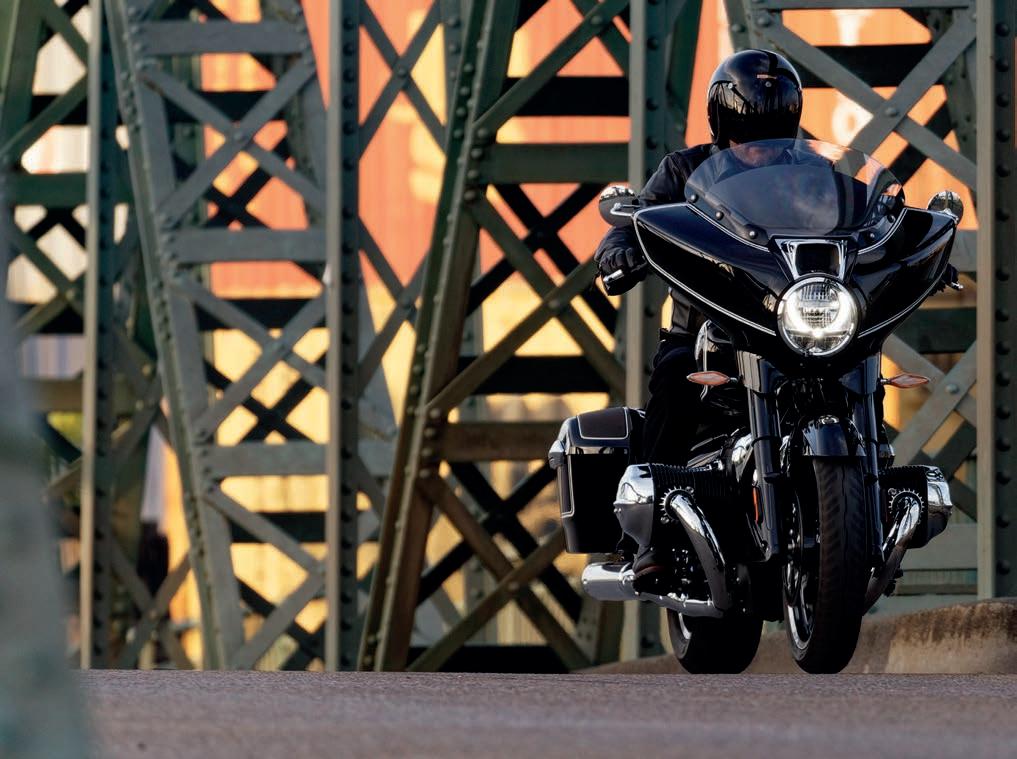
describe the motorcycle I have been riding as a piece of music.
130 ISSUE 7 APEX BIKE


The massive digital screen is a delight, displaying the fuel consumption and tyre pressure, estimated range and the like. I still cannot get to grips with BMW’s clumsy computer controller experience, a combo of a twist ring with left and right pushes and a menu up-and-down button that conspire to thwart quick access. Though they are a treat with gloves, other brands have solved the user interface far better and far more simply.
So with ZZ Top’s La Grange playing over the delightfully thumping notes of the drivetrain, if you need to get somewhere e ortlessly with a huge smile on your mug, the adaptive cruise control is flawless from 30 up to 160 km/h. The radar system handled tra c e ciently and proved helpful on longer rides and in tra c that doesn't warrant lane splitting. The handling was excellent for a big heavy bike with almost too much power. It is surprisingly easy to counter-steer the nearly half a tonne of rider and steed rapidly from one side to another. It was quite playful ... until the footpegs began issuing sparks that let you know you are





BIKE 133 ISSUE 7 APEX
reaching the limits. Having said that, the foot pegs scraping was less of an issue on this particular version of R18 than those I have had on previous tests.
Regarding handling, the R18 needs comparison with its peers, Triumph Rocket and bigger Harleys, I guess. I found it more settled, less likely to lose composure on bigger bumps and lumps mid-corner, and downright predictable while being on the firm side of plush on the freeway. In my humble opinion, it is class-leading in its segment.

With two side bags that lock electronically with the keyless go, it was excellent during the commute. I wish
there was somewhere to store a helmet, however. Ridden with care, it returns a fuel consumption figure under 4.5 L/100 km. I got 5.5 L/100 km, mostly. With a low seat height, the bike is quite manageable at low speed, with its reversing gear and all, but it is a handful if you lose its balance. It is the one time it feels like it’s just under 400 kg.
The attention to detail on this deco-looking masterpiece is incredible. There is cooled storage for your phone and the BMW Motorrad Connected app enabled me to pre-programme routes and gave feedback on the bike.
Things I didn’t quite like? Well, mostly just those useful saddlebags block the glorious view of the exposed driveshaft and its jewelled knuckle. For the rest, I could get used to a bike that isn’t my usual. It just makes you happy riding it. At R418 750, it is a heavy investment. Is it worth it for its style, chrome, heritage and performance? I’d say so, yes. A
134 ISSUE 7 APEX BIKE
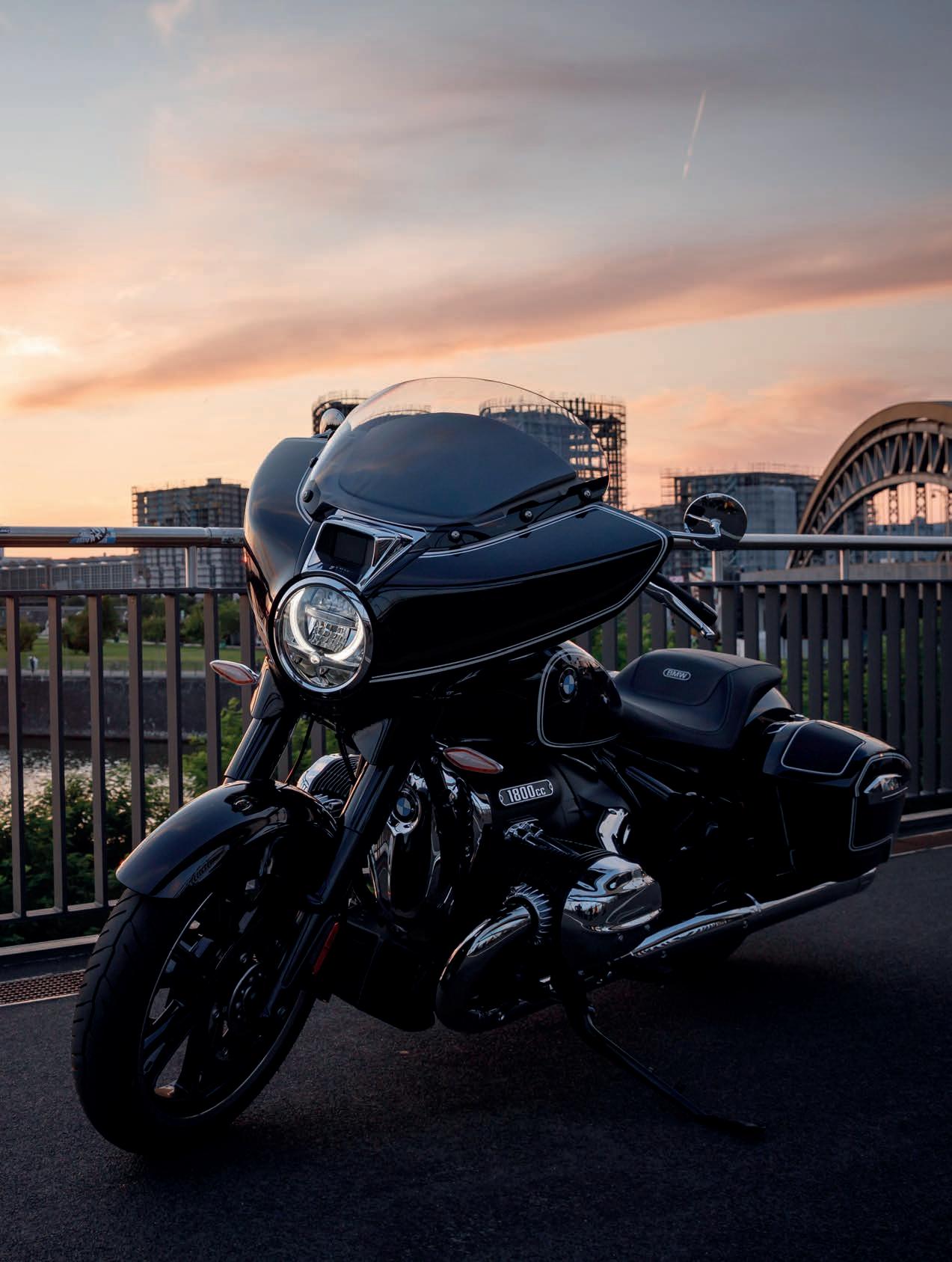
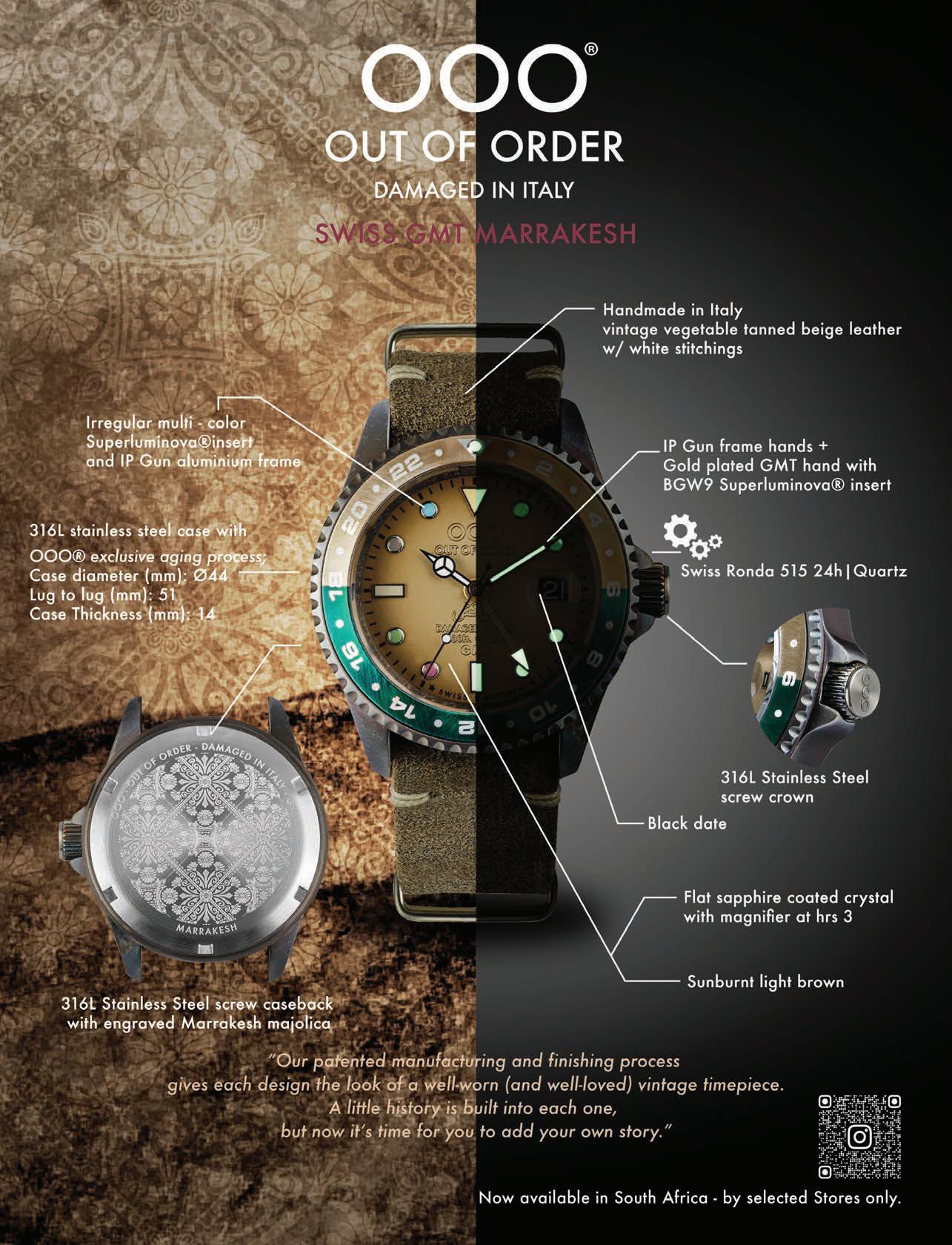
THE READING ROOM
Enjoy some downtime this season with our selection of good books.
Words: Jennifer Campbell

/ 01
POLITICS
Written by Aristotle and translated by William Ellis, this is a timeless study of politics and society by one of the world’s most well-known and respected thinkers. Politics is a reflection on the role of government, as well as the individual’s role within it. His philosophies remain as relevant today as when they were written in the fourth century. This newly translated edition forms part of a boldly designed series of classics, which aims to introduce a selection of the most celebrated works of the last thousand years to a new audience.

Cover price: R335 | Published by Jonathan Ball Publishers
THE STORY OF PORSCHE
Porsche has been synonymous with luxury and race car manufacturing for over 90 years. This tribute to the legendary manufacturer by Luke Smith studies and celebrates the brand’s story and success. The book features insightful text, as well as striking photography. The reader is invited to learn more about the journey of the brand – from its turbulent beginnings to its ascent to the summit of car design.

Cover price: R290 | Published by Jonathan Ball Publishers
LIKE, COMMENT, SUBSCRIBE: HOW YOUTUBE DRIVES GOOGLE’S DOMINANCE AND CONTROLS OUR CULTURE

Written by Mark Bergen, this is the story of YouTube and how the global phenomenon upended traditional media and transformed Google into one of the world’s most profitable companies. As a Bloomberg tech journalist, Bergen delivers the definitive account on YouTube, explaining how it started, how it actually works, and how it drives Google’s success.
transformed
04



DIDDLY SQUAT: ‘TIL THE COWS COME HOME
Jeremy Clarkson takes us back to another year of life on his farm Diddly Squat. At the end of his first year of farming, Clarkson had made a profit of £144 (around R3 000), and he had certainly mastered the art of moaning. Now, challenges continue to abound. Expect plenty of laughs as Clarkson tells tales from life as a farmer and the ups and downs that come with it.
Cover price: R350 | Published by Penguin Random House

137 ISSUE 7 APEX
/
/
02
/
03
Cover price: R350 | Published by Penguin Random House LIFESTYLE
MW
MAT WATSON ON

CARS


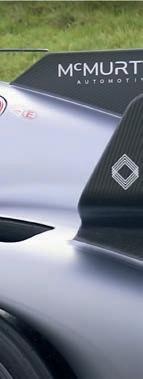

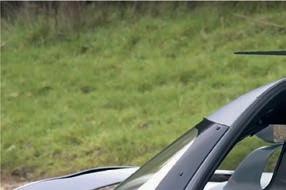
That’s it – I’m done. I’ve driven many quick cars: Bugattis, Rimacs, McLarens, Lamborghinis and Ferraris. Now, thanks to the McMurtry Spéirling, they are all o cially slow. This little £2 million (R41 494 367.66 at the time of writing) single-seater electric hypercar uses a huge fan to suck to the ground so it can deploy all its 746 kW despite being rear-driven only. I timed it at 0–60 mph (96 km/h) in just 1.4 seconds and 7.97 seconds for the quarter mile, despite hitting its 241 km/h limited top speed after just 5.0 seconds. Bonkers! No wonder the British firm calls it the wildest electric car ever to wear number plates ...


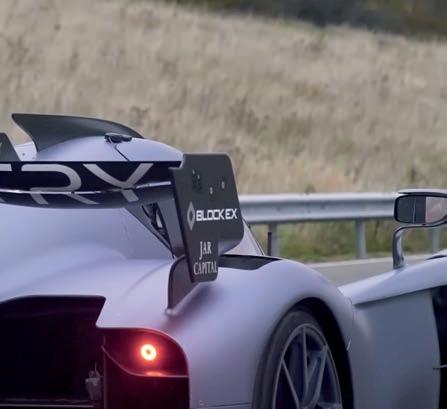
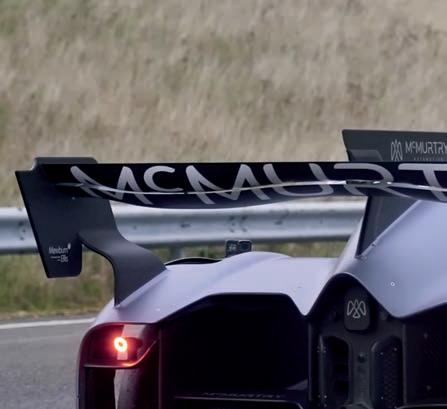 matwatsononcars
matwatsononcars
138 ISSUE 7 APEX
DRIVE INTO A SMART NEW WORLD THE HAVAL H6 HYBRID


























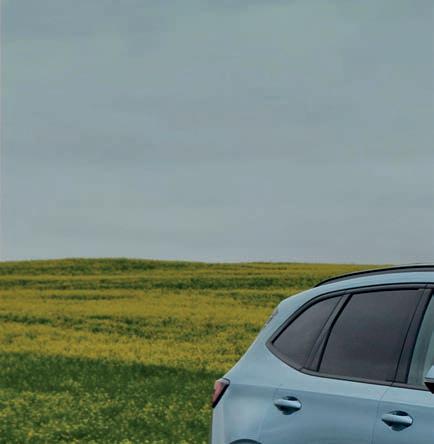












The A l l - N e w H A V A L H 6 H y b r i d combines the power of a petrol engine with the fuel savings of an electric motor to give you lower emissions and enhanced perform ance. The petrol engine charges the battery while driving, ensuring that there is never a reliance on traditional grid power. Experience next-gen performance and fuel efficiency. Experience the All-New HAVAL H6 Hybrid 100 000km WARRANTY 60 000km SERVICE PLAN 8 YEAR 150 000km BATTERY WARRANTY
WINNER
2022 | 2023
FIRST PLACE VICTORY TWO
YEARS AND COUNTING
Helmets off to team Toyota Gazoo Racing for leaving their rivals in the dust and defending their title for the second year in a row. The competition was tough but driver, Nasser Al-Attiyah and navigator, Mathieu Baumel came out on top.
And that’s not all – the Toyota Gazoo Racing team came through and dominated the top five with Giniel de Villiers and navigator, Dennis Murphy fortifying fourth place, and Henk Lategan and navigator, Brett Cummings flying into fifth.











































































































































































































































































































































































































































































































































































































 Ford Everest 3.0 V6 4WD Platinum AT
Words: Juliet McGuire Julietmc
Ford Everest 3.0 V6 4WD Platinum AT
Words: Juliet McGuire Julietmc















 Words: Mark Smyth Motorscribe
Words: Mark Smyth Motorscribe


























































































































































 Papi Mabele
Papi Mabele


































































































 Words: Marius Boonzaier mariusboonzaier
Words: Marius Boonzaier mariusboonzaier















































































 Words: Vann van Staden winewheelsandwatches
Words: Vann van Staden winewheelsandwatches

































































 matwatsononcars
matwatsononcars

































